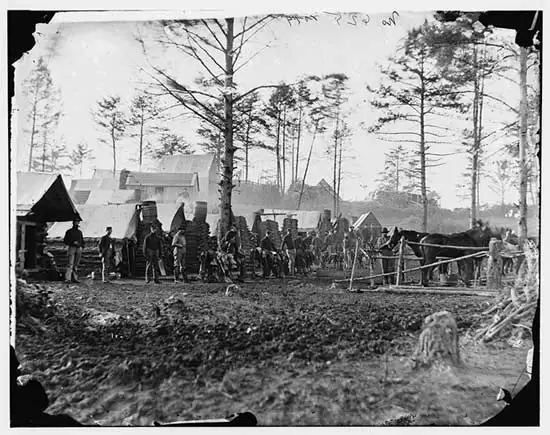PABST (or PAPST), JACOB (1832-1881). Private, 52nd New York Infantry, Company I. Of German birth, he enlisted at New York City on October 5, 1861, and mustered into the 52nd on November 1. As per his muster roll, which used the name “Papst,” and the Report of the Adjutant General, he deserted at Harrison’s Landing, Virginia, on an unspecified date.
On April 28, 1866, Pabst became a naturalized citizen; his documentation states that he was in the restaurant business and lived at 172 Eldridge Street in Manhattan. Pabst is listed as working in beer at 308 Broadway in the 1867 New York City Directory. As per the 1870 census and the 1870 New York City Directory, he was a saloon keeper at the same Eldridge Street address. The 1876 New York City Directory lists him working in beer and living at 58 Lispenard Street. As per the 1880 census, he lived with his wife and daughter in Manhattan at the same Lispenard Street address and was in the restaurant business. His last residence was 58 Lispenard Street, New York City. His death was attributed to pyemia, a form of blood poisoning. Section 165, lot 16943.
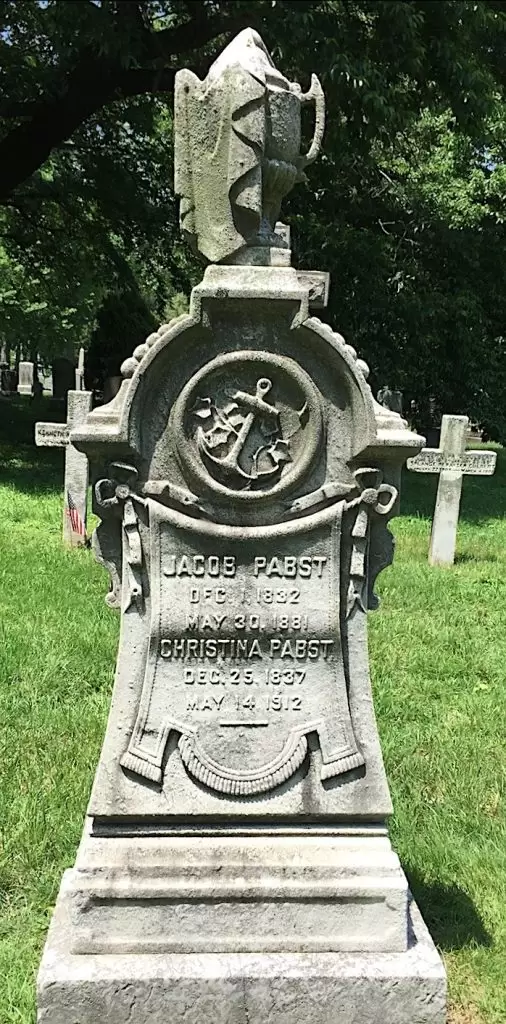
Civil War Bio Search
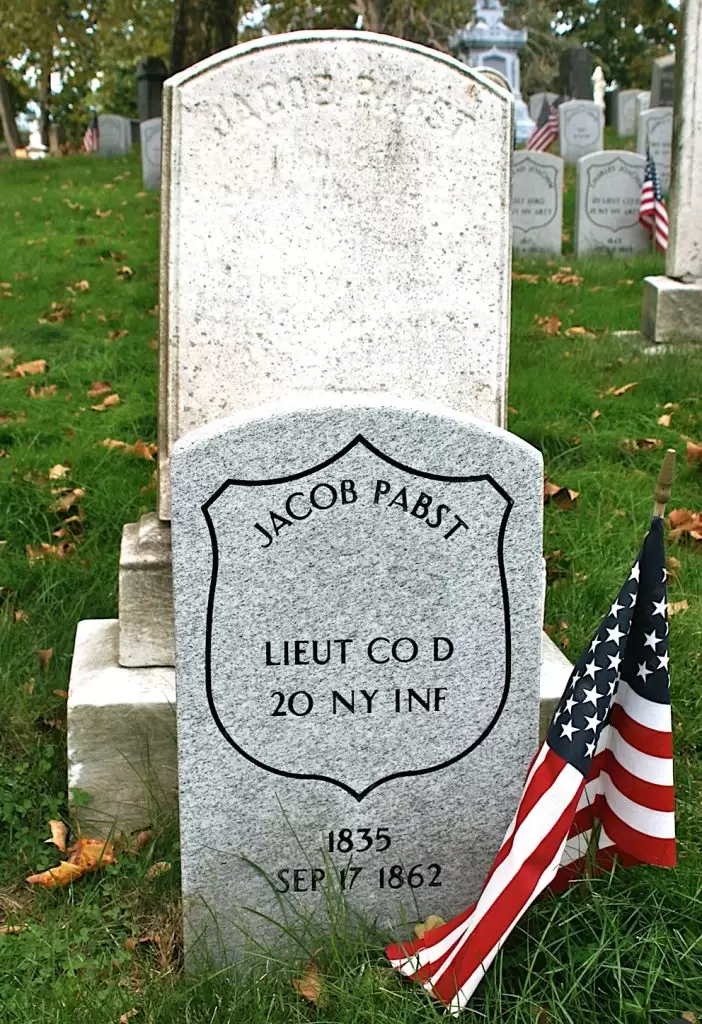
PABST (or PAPST), JACOB (1835-1862). First lieutenant, 20th New York Infantry, Companies G and D. A native of Dürkheim in Bavaria, Germany, Pabst married Caroline Leonhardt on July 1, 1858, at the United German Church in New York City. During the Civil War, he enlisted at New York City as a second lieutenant on May 3, 1861, and was commissioned into the 20th New York’s Company G three days later. Pabst was promoted to first lieutenant on May 1, 1862, and was transferred that day to Company D. On September 17, 1862, he was killed in battle at Antietam, Maryland. His death was attributed to a gunshot wound (vulnus sclopet). Originally interred at Antietam National Cemetery, gravesite 652, Pabst’s name was later noted on the Bodies in Transit List for shipment through New York City for re-interment at Green-Wood. His name is listed on the Register of Deaths of Volunteers from New York, 1861-1865. On October 20, 1862, Caroline Pabst applied for and received a widow’s pension, certificate 11,050. Caroline and her son, Jacob Pabst, who are buried at Lutheran All Faiths Cemetery in Queens, have their headstone inscribed, “Civil War Widow & Orphan.” Section 115, lot 13536 (Soldiers’ Lot), grave 18.
PACKARD, HENRY O. (1845-1872). Corporal, 13th New York Heavy Artillery, Company F. Packard was born in Saratoga, New York. The 1860 census reports that he lived in Ballston in Sarasota County with his parents and siblings. As per his soldier record, Packard enlisted as a private on January 6, 1864, at Stillwater, New York, was promoted to corporal on January 15, and mustered into Company F of the 13th New York Heavy Artillery on January 31. The “Town Clerk’s Register of Men Who Served in the Civil War” from Saratoga, New York, notes that Packard received a bounty of $300 after his enlistment. His muster roll, which reports February 18 as the date he mustered into his company, indicates that he was a clerk who was 5′ 6″ tall with grey eyes, brown hair and light complexion. On July 18, 1865, Packard mustered out at Norfolk, Virginia.
The Brooklyn Daily Eagle reported that Packard married Ida Bassford at her home on January 3, 1868. At the time of the 1870 census, he lived with his wife and daughter in Caroline, Tompkins County, New York, and worked as a clerk in a butter factory. That same year, he was listed as a clerk in the Brooklyn Directory for 1870; his home address was 231 Schermerhorn Street. Packard’s death certificate notes that he was a clerk. As per his obituary in the New York Herald, newspapers in Tompkins and Saratoga Counties were asked to print notices of his death. His last residence was 484 Adelphi Street in Brooklyn. His obituaries in the New York Herald and the Brooklyn Daily Eagle state that he died “after a long and painful illness” (consumption). Ida Packard applied for and received a widow’s pension in 1880, certificate 235,957. The Veterans Census of 1890 for Caroline in Tompkins County was completed by Ida Packard as his widow; it was noted that his discharge papers had been mislaid. Section 92, lot 4135.
PADDOCK, CHARLES HENRY (1843-1923). First lieutenant, 157th New York Infantry, Companies C and D. A native of Hamilton, New York, in Madison County, the censuses of 1850 and 1860 report that Paddock lived there with his parents and siblings. The 1850 census reports that Hiram Paddock, his father, was a farmer whose real estate was valued at $6,900; the 1860 census reports that Hiram Paddock was a merchant whose real estate was worth $5,000 and whose personal estate was valued at $1,500. During the Civil War, Charles Paddock enlisted at Hamilton, New York, as a first sergeant on August 22, 1862, and mustered into the 157th New York on September 19, 1862. The “Town Clerk’s Register of Men Who Served in the Civil War from Hamilton, New York,” notes that Paddock received a bounty of $50 after his enlistment and that he participated at the Battles of Chancellorsville, Virginia, and Gettysburg, Pennsylvania.
In these series of letters, Paddock describes his involvement in the Gettsyburg Campaign and its aftermath. Paddock wrote this letter to his brother from Littlestown, Pennsylvania, on July 1, 1863.
DEAR BROTHER GENE:
It is some time since I have written you. I am very sorry so long a time has elapsed, and…an apology, I will try to give you an account of my travels. Saturday, at 2 P.M., about 1,000 men from all Corps left…Camp Distribution with happy hearts, and went down to Alexandria and took the boat for Washington, where we arrived about dusk. Sunday morning we took the cars and passed the Relay House at noon, and Monday morning we were in Frederick. When I got down in the city I found the army passing through, and that the 11th Corps was about half an hour ahead. So I pressed on with vigor and by noon had left the 12th A. C. far behind, and had got far up into the 3rd A. C., when to my great dismay I found the 11th A.C. had turned off on another road to the left, and after weighing the matter well, I concluded to keep on with this Corps, thinking the roads would meet again. So I continued on to Torrey Town, where we halted that night. I had a nice bed in a barn, which I assure you I improved to the best possible advantage, for I had marched 25 miles and was footsore and lame. In the morning I awoke much refreshed, and found the 12th A. C. took the advance.—So I kept in front with them to Littlestown, (9 miles) and having arrived there we found considerable excitement existing, from the fact that the rebel cavalry were two miles out of town in the woods, and that they had fired on our cavalry killing a number of them. However we came on as far as here [2 miles] and halted. Last night I slept on the ground. But the signal has been given to fall in, so I must close by saying that my health is excellent, and that such nice weather for marching we have never had. If I have an opportunity to-day I will mail this. The country we are marching through is beautiful, and seems like home compared with old Virginia.
Wednesday 2 P.M.…I am now 2 miles from Gettysburg. They are fighting very…I left the 12th A. C. 2 miles back, and have just stopped and eat dinner by a …picket in the road here. About…rebel prisoners have just gone by, and…are a lot more coming. Our Corps…splendid thing in taking them. It is…advance now, and I shall see fighting. It is now 5 P.M., and what I have…through in the last two hours it will…much longer to relate.
Paddock went on to relate his experience in battle:
Thursday, July 2nd, 8 A.M. I was …to stop last night, for the robs or-…us on to this place, where we lay tonight. Yesterday, after writing, I left…picket and came through the town and…the 157th supporting the Brigade…ry. I had just got there when we were ordered forward. The battery was…ing finely, and we went to the front a little to the left, when we saw they were flanking us on the right and rear. So…changed front and went forward to…t them in that direction, and were…right up in a wheat-field. There was a single brigade against the 157th at a very short distance. Several different boys fell by my side. It was here that Lieutenant Col. Arrowsmith fell, and died immediately, hit in the head and chest. By. Fitch was wounded, and Lieut. Coffin fell, wounded in the back. Seeing that it was useless to…d against such odds, we were ordered to retreat, and we fell back out of immediate range. I got pretty near the town, where I was helping carry Adj. Henry, when a ball came hitting two of us, and we were obliged to leave him in the edge of town. The Reg’t rallied for some time, but the rebels did not advance there, but were rushing around to cut off our rear. There were but six men of my Co. left including officers. The Col[onel] was there and the colors all right. I was so tired that I could not stand up. Seeing the rebels were getting in the south part of the town we were ordered to retreat in that direction, and such a confusion and hubbub it is hard to imagine. When we got into the center of the town the bullets commenced whistling up and down the streets, and we were ordered to take to the houses. In a few minutes the streets were full of rebels. I was in a garden with a lot of the 1st Corps boys, and the first thing I knew a grey back was ordering us to take off our cartridge boxes, stack guns, & c.—Then they marched us to the rear, where I was writing last night, and not far from the wheat field. Lieut. Coffin came up last night; he said a ball passed through his blanket-roll across his back, coat and belt, and made a hole in his pants large enough for me to put three fingers through, but did not break the skin, though he supposed the ball was in him until a short time before he got here. He washed the blood off from Arrowsmith’s face and brought away his sabre and scabbard and belt, &c. He begged the rebs to let him stay but they would not. The last I saw of Col[onel] Brown, he was going up the street with the colors by his side as fast as possible.—There must be 4,000 of us here. We moved a mile further from town this morning. There they offered to parole us and keep the officers. Most of the Reg’ts accepted it, and while we were disputing about it, a heavy fire opened about three miles off on our right, which hits kept coming nearer and nearer, and now there is a battery opened on us not more than a half a mile off. The rebs scatter to the rear like sheep, but some are wounded.
Friday, 5 P.M. I have just passed through a fiery ordeal. That parole our officers did not like at all. But they were all separated from us yesterday. Well, today the question came to each Reg’t in turn. All the boys wanted to know what I was going to do; for you see I am the ranking non-commissioned officer, and have them all to see to.
Paddock goes on to relate his hardships as a prisoner of war:
July 5th. Yesterday was the Fourth. We marched a long distance and it rained a perfect flood. It was awful but not very cold. When we halted last night we cooked up a few flour cakes and roasted some beef on sticks, after disposing of which and putting on some dry clothing, which I was so extremely fortunate as to have in my knapsack. I laid down; but I was soon waked up by one of the boys to draw the rations. After waiting about two hours I obtained a pint and a half of flour per man, but the 1st, 3rd and 5th Corps boys got all the beef. The officers march just in front of us, and come back occasionally to see how we are getting on.
Monday morn. I can’t realize yesterday was communion at home, for we suffered the hardest marching we have ever had to endure. We started about 8 A.M. The order came before most of us were up. My breakfast consisted of one flour cake the size of my hand, my dinner of hard tack, my supper one canteen of water. We marched until 11 P.M., and are now up on a mountain. Lieut. Coffin is sick. Capt. Place looks as haggard as a ghost. There is a heavy fog and mist wetting us through and making it impossible to look three rods ahead.
Tuesday, P.M. We marched down the mountain several miles in a south-westerly direction to Waterloo and drew rations. At 5 0’clock we were on the march again but something kept halting the column every few rods, so that at one time we made only one mile in two hours. We passed through Waynesboro at 9 p.m., and no signs of camp. We were then marching tolerably fast, but at 11 we commenced that halting again, and finally they made a halt of half an hour, and in a jiff every man was in a snooze. I never suffered so much from mere sleepiness as last night.—At half past twelve we passed Hagerstown. I did not believe they would march us all night, until it began to grow light this morning. It was moonlight and fine marching. The guards are rough as Indians generally, but they divide their last ration with the prisoners. We arrived here—two miles from the river—at 1 p.m.
Thursday, July 9th. It is a beautiful morning. I did not write yesterday, but will try to do so more regularly hereafter. Yesterday we drew no rations until evening, and we were getting pretty hungry I assure you. The boys exchange all kinds of clothing and trinkets for bread. A cake of bread the size of a round pie can hardly be bought for a dollar. I exchanged my wallet for a piece. My shoes are most gone, and I shall be obliged to go barefoot soon. We expect to cross the river today; we should have crossed yesterday but their pontoons were burned.
Friday morn. Once more have I enjoyed the peculiar bliss of resting my weary limbs on the sacred soil of Virginia. We crossed the river at 10 P.M. yesterday.—It was a slow process, having nothing but ferry boats to use. There are some of the boys behind yet, A lady gave me a shortcake in Williamsport just before we crossed. I found a man from the 90th P[ennsylvani]a. V[olunteers], that took off the Lieut[enant] Col[onel]’s shoulder straps. He obtained them just before the rebs came up searching the dead. He would not part with them at first, but finally consented to take a dollar for his trouble and let me have them. The Col[onel] will value them highly, for there is a bullet hole in one of them, cutting off half the leaf.
Saturday Morn. We are on the march again without any thing to eat. It is 60 hours since we have drawn rations. We then drew 6 oz. flour and one lb. of beef per man. We started yesterday at 12 M. and arrived at this camp, two miles beyond Martinsburg after dark; being a distance of 15 miles. I am getting very weak. I have a bad diarrhea, the result of eating beef without salt, and these heavy flour cakes, & c. Yesterday as we came thro’ Martinsburg, the ladies cheered us, and hoped us back again soon, all right &c. They would have brought us out bread, but the guards would not let us go and get it, nor allow them to come and bring it to us. But finally they commenced handing it to us between the guards.
Twelve miles from Winchester, 3 P.M. Dear Bro. I was sick this morning, and after marching a while, sat down by the fence with a severe cramp in my bowels, feeling pretty blue. Soon a guard came along and after looking well into my face, handed me a piece of bread, hoping it would help me. I devoured it greedily and soon caught up, feeling much refreshed. We arrived here about 12 M., and for dinner obtained a small piece of bread and beef each.
After Paddock was captured at Gettysburg on July 1, 1863 (the date on his soldier record, which was the first day of that three-day battle), he was sent to Belle Island in the James River opposite Richmond, Virginia, for three months as a prisoner of war until he was paroled on September 24, 1863, and then was sent to the front at Charleston, South Carolina. On December 17, 1863, he was promoted to first lieutenant. His hometown records indicate that he served at Fernandina, Florida, and was in charge of prisoners at Fort Pulaski, Georgia. According to his pension record, he was transferred intra-regimentally to Company D on June 24, 1864. He mustered out on July 10, 1865, at Charleston, South Carolina.
As per his passport application of April 7, 1883, for a trip to Europe, he was 5′ 10″ tall with a high forehead, rather large mouth, hazel brown eyes, medium nose, slightly receding chin, dark hair, dark complexion and oval face. On April 17, 1883, Paddock married Ella Louise Murphy. The 1890 Veterans Schedule confirms his Civil War service. The 1891 New York City Directory lists Paddock as working in dry goods at 340 Broadway; his home address was 141 West 70th Street. The federal census of 1900 and the 1905 New York State census report that he lived with his wife, children and three servants (cook, maid, waitress) at 141 West 70th Street and worked in dry goods. The 1910 census notes that he was living on West 72nd Street with his sister-in-law and her family. Paddock applied for and received a pension in 1913, certificate 1,171,834. As per his obituaries in The New York Times and the Evening Telegram, which confirm his Civil War service, he was a retired wholesale dry goods merchant. A trustee of the Park Avenue Baptist Church, he was also a charter member of the Old Settlers’ Association of the West Side and a member of the Loyal Legion, a patriotic organization of men who served as officers in the Civil War. His death certificate indicates that he was a widower and a dry goods merchant; his wife died in 1918. He last lived at 149 West 72nd Street, in New York City. His death was attributed to pneumonia. On November 22, 1923, a listing in The New York Times states that Paddock left an estate valued at $31,988 to his two sons and two daughters. In 2009, a collection of his property, including a drill rifle, printed correspondence, and photos, was sold on eBay. Section 56, lot 5849.
PADLEY, WILLIAM H. (1832-1870). Private, 134th New York Infantry, Company H; 10th Veteran Reserve Corps. Padley, who was born in England, enlisted on August 25, 1862, at Schenectady, New York, as a private, and mustered into Company H of the 134th New York on September 22. As per his muster roll, he was a farmer who was 5′ 5″ tall with blue eyes, brown hair and a florid complexion. Padley’s muster roll notes that he was absent and hospitalized at Central Park, New York, on April 10, 1863. On July 1, 1863, he was transferred into the 10th Veteran Reserve Corps. He was discharged on June 29, 1865, at Washington, D.C. As per the census of 1870, he lived in Brooklyn with his wife and son and worked as a porter; he was also listed as a porter in the 1870 Brooklyn Directory. His last residence was 520 Court Street in Brooklyn. He died from congestion of the brain. Lot 17931, grave 260.
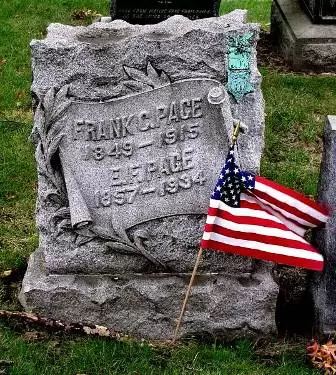
PAGE, FRANK C. (1849-1915). Musician, 169th New York Infantry, Company F. A native of Worchester, Massachusetts, his birth record indicates that his first name was Christopher, his father’s name. Page said he was 15 at the time of his enlistment as a musician at New York City on July 15, 1862, but was only 13 years old when he mustered into the 119th New York on September 4; his obituaries in the New York Sun and the Brooklyn Standard Union incorrectly state that he served in the 169th New York. As per his muster roll, he was a laborer who was 4′ 7″ tall with gray eyes, light hair and a light complexion. He served as a drummer boy and, according to his obituary in the Brooklyn Daily Eagle, he was at the Seven Days Battle in Virginia. During that engagement, Page received a hand wound that left him with a permanent scar. Although his soldier record indicates that he was discharged for disability on January 7, 1863, he either re-enlisted or exaggerated his service history because his obituaries in the New York Sun and the Brooklyn Daily Eagle note that Page was presented with a medal for bravery at the Battle of Gettysburg and served throughout the Civil War—both of which would have been impossible if he last served on January 7, 1863.
As per the 1865 New York State census, Page lived in Brooklyn with his parents and sibling and was not employed. He studied architecture and became a pioneer hotel builder in Rockaway Beach, New York, beginning in 1876. The 1880 census notes that Frank Page and his father were living in Brooklyn with his sister and her family; all of the men in the family were listed as carpenters. On October 4, 1883, he married Elizabeth Myers, the daughter of Samuel Myers (see), a United States marshal during the Civil War and New York City alderman; Myers and Page were both involved in the hotel industry in Rockaway. Page was the owner of the Pier Hotel, Iron Pier, and Vienna Hotel, and several stores in Rockaway. The Brooklyn Directories for 1889 and 1890 list him as a hotelier in Rockaway Beach and the 1892 New York State census lists him as a carpenter. He was also a charter member of the Sam Myers Hook and Ladder Company and the Veteran Volunteer Fire Department of Rockaway Beach. His obituaries in the Brooklyn Daily Eagle and the Brooklyn Standard Union, which confirm his Civil War service, note that he was also a member of Rockaway Beach Aerie, Order of Eagles, a fraternal organization that provided sick benefits, life insurance, etc. On June 7, 1884, he mustered into the Mansfield Post #35 of the G.A.R.; he listed his occupation as hotel keeper and attributed his service to the 119th New York. In addition, he was an attendant at the Universalist Church of Our Father at Grand Avenue and Lefferts Place in Brooklyn.
Page received an invalid pension in 1900, certificate 1,078,569. As per the census of 1910, he was a carpenter and house builder. Page’s death certificate notes that he was married and was a proprietor. He last resided in Brooklyn at 691 Nostrand Avenue; his obituary in the New York Herald indicates that he lived there for 45 years. His obituary in the Sun attributes his death to pneumonia resulting from a compilation of diseases. There is a G.A.R. ribbon carved into his gravestone attesting to his membership in the Mansfield Post #65. His widow, Elizabeth Page, who is interred with him, received a widow’s pension in 1915, certificate 794,127.
As per an article in the Brooklyn Daily Eagle on April 24, 1915, Page left the bulk of his estate to his son, Samuel, the executor of his will. Samuel Page was left his father’s personal estate and the Iron Pier and all of the buildings and the contents therein on that property; the property would then be left to Samuel’s heirs. His wife, Elizabeth, was bequeathed $500, the same sum bequeathed to his sister; his daughter, Idella Koeschel, was left $1,200 and her grandfather’s gold watch. Apparently, Elizabeth Page had a share of her husband’s property because an article in the Rockaway Beach Wave on November 5, 1915, notes that she leased the Vienna Hotel in Rockaway for three years for $1,800 per year; her son, Samuel, leased a storage building on the Iron Pier for three years at $1,800 per year. (Samuel Page died in 1917.) Section 137, lot 29103.
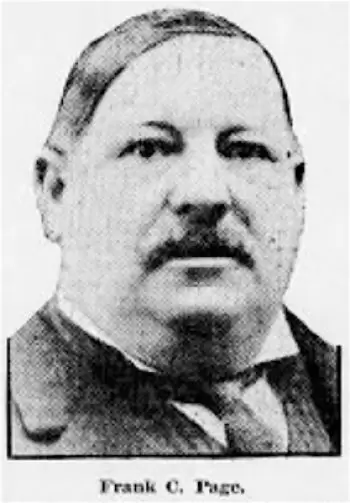
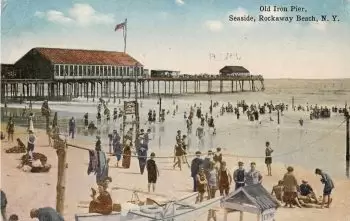
PAGE, JOHN MILTON (1840-1931). Corporal, 40th New York Infantry, Companies E and D. He enlisted as a private at Yonkers, New York, on June 14, 1861, and mustered into Company E of the 40th New York, known familiarly as the Mozart Regiment, on that date. Page was promoted to corporal on June 1, 1862, wounded at Chantilly, Virginia, on September 1, 1862, transferred to Company E on May 25, 1863, and discharged for disability on April 30, 1864, at Washington, D.C. According to his obituary in the Hempstead Sentinel, he was, at the time of his death, Long Island’s oldest veteran of the Civil War. That obituary noted that Page fought in many engagements of the Civil War, was wounded at Second Bull Run, Virginia, but returned to service after his injury. A purchasing agent by trade, he last lived with his son at 166 Cleveland Avenue in Rockville Centre, Long Island. His cause of death was pulmonary edema (excess fluid in the lungs). Section 90, lot 12040.
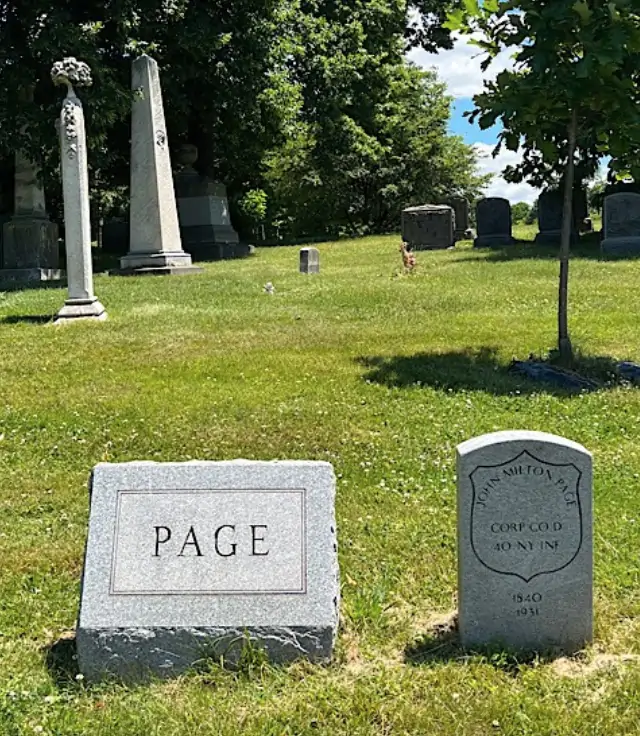
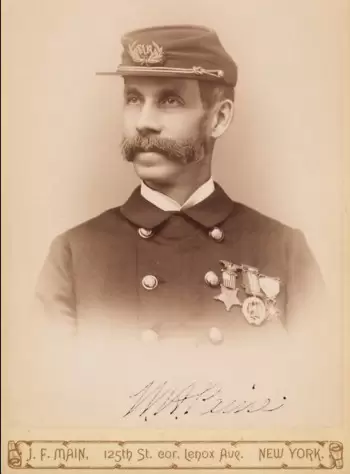
PAINE, WILLIAM HENRY (1828-1890). Colonel, lieutenant colonel, and major by brevet; captain and additional aide-de-camp, United States Volunteers. Born in Chester, New Hampshire, to an old New England family, Paine studied engineering and first worked at age twenty as a land surveyor in Sheboygan, Wisconsin. He then ventured to California at the time of the Gold Rush, where he introduced new engineering techniques while engaged in the mining industry. In 1849, he surveyed a road across the Rockies and, in 1853, surveyed a road for a Pacific railroad traversing the Nevada Mountains from Sacramento, California, to Utah. As per his biography for his papers at the New-York Historical Society, he returned to Sheboygan in 1856 where he invented steel surveyor’s measuring tape, a product he patented in 1860.
As per his obituary in The New York Times, Paine raised several regiments of Wisconsin troops during the Civil War, accompanied the 4th Wisconsin to Washington, D.C., then entered the Engineer Corps. His biography for the New-York Historical Society reports that he worked as a topographical engineer for the Union Army in 1861, mapping projects in Washington, D.C., and in Virginia. Paine enlisted as a captain on April 28, 1862, and was commissioned that day into the United States Volunteers as a captain and additional aide-de-camp. The Times obituary notes that he was more than once thanked by President Abraham Lincoln for the valuable information he obtained regarding the dimensions of the railway bridges linking Washington and Richmond, Virginia, many of which had been destroyed by Confederate rebels; these dimensions were necessary to secure the movement of Army materiel in advance of their reconstruction. As per Earl B. McElfresh in Maps and Mapmakers of the Civil War, Paine attracted President Lincoln’s attention when he risked his life to help the War Department secure information about status of the aforementioned bridges by donning civilian attire and making his way to northern Virginia and back to scout the area.
Paine, who had been the assistant to General Amiel W. Whipple, the chief topographical engineer to the Federal Army of Northern Virginia, was appointed a captain of engineers by the President, a rare appointment for a non-West Point soldier. He was appointed captain on the staff of General Irvin McDowell and commended for his superior knowledge of topographical engineering and unequalled skill at drafting military maps. According to McElfresh, topographical engineers were well trained and very artistic, exhibiting an understanding of color and composition as well as fine technical skill. Paine’s pencil maps were considered exemplary for their accuracy and reliability. His New York Times obituary notes that he furnished maps to Generals Ulysses S. Grant, Andrew Humphreys, and John W. dePeyster, and to Horace Greeley and other writers. Major General Pope, United States Volunteers, in his report on January 27, 1863, describing the recent campaign in Virginia, gave honorable mention to his staff and to Captain Paine, who was “zealous, untiring, and efficient” in executing duties that were particularly arduous.
Paine’s obituary in Engineering News relates a story that Paine was assisted by his “colored body-servant,” Darney Walker. Walker, who had a topographical “instinct,” relayed information from a Confederate camp across the Rappahannock, near Fredericksburg, Virginia, through his association with a washerwoman. That woman would relay signals to Walker by arranging clothes in different colors and positions on a clothesline; the secret code was known to the two, and the information then relayed to Paine. This topographical map (below) on April 3, 1863, drawn quickly by Paine of the bank of the Rappahannock above Fredericksburg, Virginia, helped Union General Joseph Hooker “steal a march on General Robert E. Lee” three weeks later. Hooker was able to cross upstream at Kelly’s Ford and came down on the flank of Lee’s Army, and advance closer to Richmond than Lee.
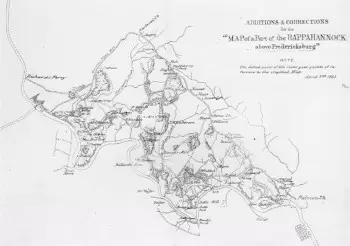
On June 4, 1863, Paine teamed with another topographical engineer and non-West Point graduate, Washington Roebling, in riding in an observation balloon across the Rappahannock River, reporting on the first stirrings of the Confederates signaling the onset of the Gettysburg campaign. The two recognized that the Union was caught ‘flat-footed” in respect to maps when the Confederates began its second invasion of the North. McElfresh contends that part of the problem was caused by changes in the Union command and “complacency at the army’s map headquarters” (p. 253). Paine later assisted Major General George G. Meade, a former topographical engineer who had just been elevated to command of the Army of the Potomac, in preparation for the Battle of Gettysburg, Pennsylvania. At midnight, on July 1, 1863, Paine escorted Meade on a tour of the battlefield to acquaint the general with the locale and to prepare to map it. On May 5-6, 1864, Paine’s map of the Battle of the Wilderness, Virginia, (below) was significant because it documents the first contact between General Ulysses S. Grant, commanding Union forces, and General Robert E. Lee, leading the Confederate Army of Northern Virginia. Paine highlighted the positions of different Confederate corps and drew in a broken arching line that marked the unfinished railroad. Lee wanted to fight in this area because the tangle of woods neutralized the numeric advantage of the Union Army, especially the artillery. McElfresh stated that Paine obtained data for this sketch (the first of three) from notes taken on the region in the late 1820s by R.C. Taylor, an employee of the State Geological Survey of Virginia.
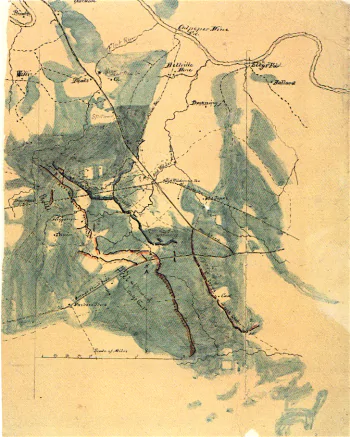
Paine’s maps of the Richmond area detailed woods, riverbanks and road services and included annotations. On August 1, 1864, he was brevetted major of United States Volunteers for “faithful and meritorious services in the field.” His promotions by brevet to lieutenant colonel on March 2, 1865, and to colonel on April 9, 1865, were awarded for “gallantry and meritorious services during the recent operations resulting in the fall of Richmond, Virginia, and the surrender of the insurgent army under General Robert E. Lee.” Paine mustered out on August 5, 1865. In addition to McDowell, Pope, Hooker and Meade, Paine also served on the staff of General John C. Frémont.
After the Civil War, Paine drew maps for such Civil War history publications as William Swinton’s (see) History of the Army of the Potomac and Horace Greeley’s American Conflict. As per his obituary in The New York Times, Paine was one of the foremost engineers in the country. In the late 1860s, he worked for the Flushing Railroad. In 1869, he was chosen as one of the engineers on the Brooklyn Bridge and assisted John A. Roebling (father of Washington Roebling, with whom he had worked in 1863) in making the original surveys. Paine was working with John Roebling on June 28, 1869, to determine the exact location of the Brooklyn tower when a ferry crashed into a piling where Roebling was standing, crushing Roebling’s toes; tetanus set in after medical help was refused and Roebling died on July 22. His son, Washington, then took over leadership of the project. Paine superintended the placing of the two caissons, built the New York tower, and was in charge of laying the cables that would support the structure. He invented a grip for use on the railroad cars and planned the system of cable traction on the bridge; in all, he received 14 patents for cable railway work during his tenure with the Brooklyn Bridge.
After remaining with the Brooklyn Bridge as an assistant engineer for several years, Paine then opened an office in New York City as a consultant for cable railroad enterprises. He was responsible for the plans for the Tenth Avenue and 125th Street cable roads in New York City and proposed plans for a Third Avenue cable road. Subsequently, he went to Kansas City and Omaha, Nebraska, to superintend construction of cable roads. After laying cables in San Francisco, California, and Denver, Colorado, he came to Cleveland, Ohio, in August 1889 to take charge of the Cleveland City Cable Company’s twenty miles of roadways, a project that was completed one week before his death. In 1889, he applied for an invalid pension, application 325,813, but apparently he died before it was certified. As per his obituary in Engineering News, about 30 members of the American Society of Civil Engineers, of which Paine had been a member since 1875 and a president, attended his funeral at the Church of the Puritans in Harlem. Members of Hamilton Post #182 of the G.A.R., the Harlem Republican Club, and engineering associates who worked with him on the Brooklyn Bridge also attended his funeral. That obituary praised him “as a most useful citizen, valiant soldier and engineer endowed by nature, and quickened by long training, with those qualities that make him eminent in his profession.” He last lived on West 122nd Street in Manhattan. Brooklyn Bridge trustees planned to honor him after his death was announced. Although his obituary notes that he suffered from chronic stomach trouble, he died in Cleveland, Ohio, of heart disease. Catharine Paine applied for and received a widow’s pension, certificate 777,865. Section 139, lot 27537.
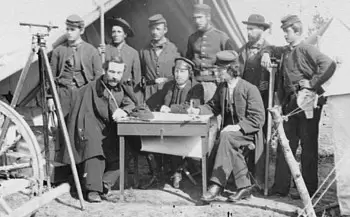
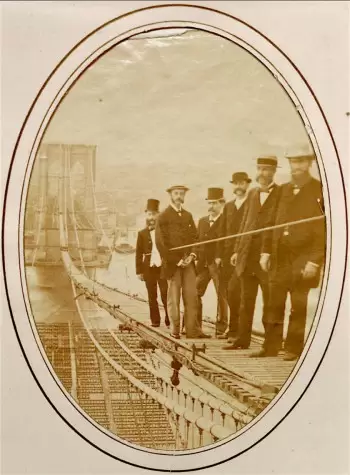
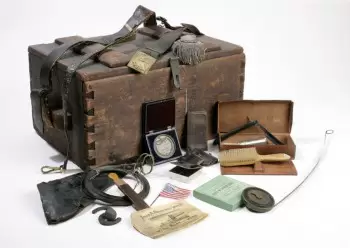
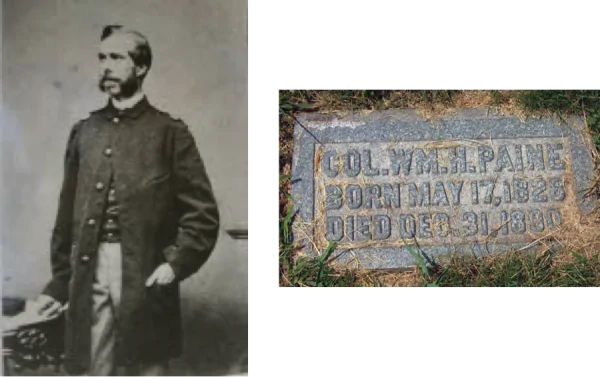
PAISLEY, JOHN (1831-1889). Captain, 10th Ohio Cavalry, Companies B and A; first sergeant, 85th Ohio Infantry, Company F. Born in Ireland, Paisley enlisted on May 29, 1862, as a first sergeant, mustered into Company F of the 85th Ohio on June 10, and mustered out on September 23, 1862, at Camp Chase, Ohio. He then re-enlisted on October 13, 1862, was promoted to first lieutenant of his company on November 7, and was commissioned into Company B of the 10th Ohio Cavalry on February 10, 1863. On March 17, 1864, his promotion to captain became effective upon his transfer to Company A that day. He served in that capacity until his discharge on July 24, 1865, at Lexington, North Carolina. He last resided on Lafayette Street in New Rochelle, New York. His death was attributed to cardiac paralysis. Section 189, lot 17030.
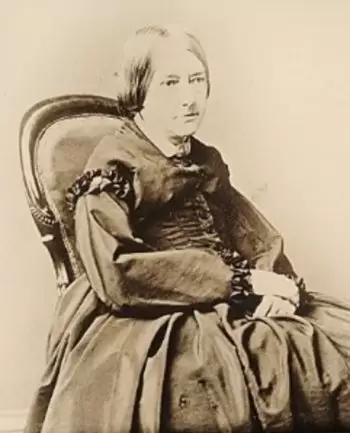
PALMER, FRANCES FLORA BOND PALMER (1812-1876). Civil War artist and lithographer. Born in Leicester, England, Frances (Fanny) Flora Bond was educated there at a private school for women where she learned to draw. She married Edmund Seymour Palmer, a man’s servant, at age 20, and they had two children. The couple fell into financial trouble after Edmund lost his job; Fanny set up a lithography business in Leicester in 1842, where she was the artist and her husband, the printer. The business failed but in 1844, the Palmers immigrated to America and settled in New York City where they set up a lithography business that bore the name F & S Palmer and produced floral prints for The American Flora by A. B. Strong. She also produced lithographs of the Mexican War, demonstrating her ability to draw a variety of subjects. Although the Palmers produced a book in 1849, The New York Drawing Book: Containing a Series of Original Designs and Sketches of American Scenery, No. 1, that sold for only 25 cents, both the book failed to sell and the business failed to flourish. Fanny Palmer then gave singing lessons and worked as a governess while her husband opened a tavern.
However, the family’s fortunes changed in 1851 when Palmer was hired as a staff artist by Nathaniel Currier; in 1857, when James Ives (see), Currier’s brother-in-law, joined the firm, the establishment thereafter was known as Currier & Ives. As per Maggie MacLean in her blog, Civil War Women (2014), Ives, an artist, often redrew the figures on Palmer’s work, but, because she needed the money, she remained in her position at the firm. Palmer distinguished herself as an artist at a time when art was not considered an appropriate profession for a woman and is credited with developing a lithographic crayon. During her years at Currier & Ives, she produced more prints than any other artist, a considerable achievement in that field. At first, she sketched rural and suburban settings in New Jersey and Long Island, traveling there by carriage and using descriptions in books, daguerreotypes and later, other types of photographs, for her subjects. Tragedy struck the family in 1859, when Edmund Palmer, who had relied on Fanny to support the family, died after he drunkenly fell down a flight of stairs in a Brooklyn hotel leaving Fanny as the sole support of her children, grandchild and sister. In 1862, she published Landscape, Fruit and Flowers, highly regarded for its color lithography. She flourished at her work which encompassed landscapes, drawings of railroads, and scenes of sports and marine life. Her skills were recognized as an artist of clipper ships, yachts and steamboats.
Palmer’s work as a Civil War artist of naval scenes has only recently been recognized and celebrated. Indeed, in the Union Image by Mark Neely and Harold Holzer, they conclude that Fanny Palmer “barely missed becoming the most important image maker of the Civil War” not due to any failure on her part, but rather because Currier & Ives never commissioned her to compose any on-land battle scenes. As per Fanny Palmer: The Life and Work of a Currier & Ives Artist by Charlotte Streifer Rubinstein, Palmer’s print, Staten Island and the Narrows (1861) depicted a New York view and an image of the City’s harbor defenses. She was most renowned for her prints of the battle of the Monitor v. Merrimac (1862) at Hampton Roads (see image below). Rubinstein notes that Palmer’s print showed the world that the United States was in the forefront of modern engineering for naval engagements. In 1865, Palmer depicted The Victorious Attack on Fort Fisher, North Carolina (January 15, 1865) when Confederate supply lines were cut off. She also made prints of three Union military camps, The Valley of the Shenandoah (1864), Cumberland Valley, from Bridgeport Heights Opposite Harrisburg, Pa. (1865), and Harrisburg and the Susquehanna, From Bridgeport Heights (1865). Those works, which showed orderly rows of tents, helped ease the worries of soldiers’ families because of their calm panoramas. In the waning months of the Civil War, Palmer created two contrasting image of Mississippi, one in time of peace and the other in time of war (see image of prosperity below).
After the Civil War, Palmer collaborated with Ives on lithographs showing images of American life, among them the transcontinental railroad, westward expansion and life on the Mississippi as it was affected by the river’s flooding. Critics debate the reasons why African-Americans in the prints about the Mississippi life appeared in stereotyped images; Palmer’s original drawings were not stereotypical and perhaps the final images were meant to appeal to a mass audience in the South and to Northerners who feared that the freed slaves were gaining too much power. She retired from Currier & Ives in 1868, leaving a legacy of more than 200 lithographs. Many of her prints were unsigned or bore the initials F. F. Palmer. She last lived with her sister; her daughter was also an artist. Palmer’s death was attributed to tuberculosis. Section 58, lot 4659.
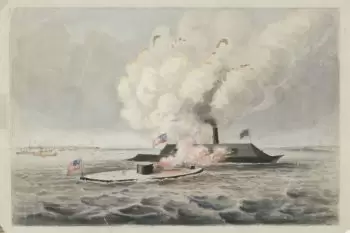
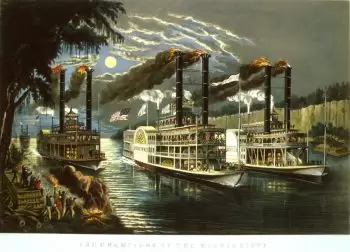
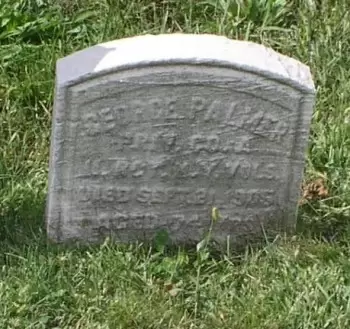
PALMER, GEORGE E. (1831-1905). Sergeant, 4th New York Heavy Artillery, Battery G; private, 11th New York Infantry, Companies A and I. A native of England, Palmer enlisted on April 20, 1861, at New York City, mustered into Company A of the 11th New York on May 7, and transferred to Company I on October 11, 1861. He mustered out at New York City on June 2, 1862. Later that month, on June 13, 1862, Palmer mustered into the 4th New York Heavy Artillery as a sergeant at New York City. As per his muster roll of August 1863, Palmer was found guilty by General Court Martial of violation of the 6th and 9th Articles of War and sentenced to hard labor on Government works for the balance of his term. Article 6 prohibits disrespect toward a commanding officer and Article 9 prohibits violence or threat of violence toward a superior officer. Palmer mustered out at New York City on June 17, 1865; according to a letter from the Department of War dated March 24, 1865, he was to be given a dishonorable discharge.
As per the 1870 federal census and 1875 New York State censuses, he lived in Greenpoint, Brooklyn, with his wife and children and was employed as a plumber. The 1880 census notes that the Palmer family still lived in Greenpoint and that George Palmer and one of his sons worked in plumbing and gas. The 1889 Brooklyn Directory lists him as a plumber at 63 Greenpoint Avenue; his home address was 139 Calyer Street. The Veterans Census of 1890 confirms Palmer’s Civil War service. In spite of the aforementioned court-martial and apparent dishonorable discharge, Palmer applied for and received an invalid pension in 1891, certificate 797,074. According to the 1892 New York State census, he was listed as a plumber living in Brooklyn. In 1901, he was admitted to the Home for Soldiers’ and Sailors’ in Bath, New York, from September 13 through October 15. At that time, he was a widower who identified his occupation as “paper stainer.” He was 5′ 5″ tall with blue eyes, grey hair and a sandy complexion suffering from heart and hearing problems in addition to dementia. As per his death certificate, he was a widower and a machinist by trade. His last residence was at 112 North Elliot Place in Brooklyn. He died from apoplexy. A government-issued gravestone was ordered for him early in the 20th century. Section B, lot 8575, grave 496.
PALMER, HOYT (1819-1879). Second lieutenant, 10th Veteran Reserve Corps, Company A; sergeant, 1st United States Veteran Infantry; corporal, 2nd United States Artillery, Company C. Palmer, a Chittenton, Vermont, native, first served with the United States Army. He enlisted on September 7, 1848, listed his occupation as soldier and described himself as having hazel eyes, black hair and a sallow complexion. Assigned to the 2nd Artillery, Company L, he was discharged on September 24, 1853, at the expiration of his service. The 1850 census notes that he was a Florida resident and a sergeant in the United States Army. As per the 1855 New York State census, he lived in the New Utrecht section of Brooklyn and worked as a druggist. He re-enlisted on September 23, 1859, at Boston, Massachusetts, and identified himself as a 5′ 7¾” soldier with hazel eyes, dark hair and a dark complexion. He was assigned to the 2nd Artillery’s Company C and was discharged for disability as a corporal on May 20, 1860, at Fort Independence, Massachusetts. At the time of the 1860 census, he lived in the New Utrecht area of Brooklyn.
Palmer continued his service during the Civil War, although the specific dates are unknown. After his initial service with the 2nd U.S. Artillery, he enlisted as a sergeant in the 1st U.S. Veterans but mustered out as a private. He also served as a second lieutenant in Company A of the 10th Veteran Reserve Corps. As per the 1865 New York State census, he lived in Brooklyn and worked as a clerk. The 1867 Brooklyn Directory lists Palmer as “u.s.a.,” perhaps an abbreviation for United States Army. A Royal Arch Mason, his companions were invited to attend his funeral. As per his death certificate, which incorrectly indicates his year of death as 1880, he was married and worked as an officer. His last residence was in Warren Township in Somerset County, New Jersey, where his wife was a farmer. His death was attributed to dropsy.
After his death on August 11, 1879, he was buried in New Utrecht Cemetery from which he was removed and re-interred at Green-Wood on October 3, 1893. Anecdotally, Walter Palmer, Hoyt Palmer’s son born in 1868, was the chief electrician for The New York Times who designed the first iron and wood ball lit with one hundred 25-watt bulbs and weighing 700 pounds that was used for the first time at the New Year’s Eve celebration in 1907, creating an annual tradition; although one second late, the ball drop attracted a large crowd of men in silk hats and ladies in fur coats. Section13, lot 19694, grave 431.
PALMER, JAMES M. (1843-1929). Private, 44th Massachusetts Infantry, Company I. Palmer was born in Maine. The 1850 census indicates that he lived in Fayette in Kennebuc County, Maine; the 1860 census lists him living with his parents and siblings in Milo in Piscataquis County, Maine. A resident of Weston, Massachusetts, and a farmer by occupation, Palmer enlisted on August 28, 1862, mustered into the 44th Massachusetts on September 12, and mustered out on June 18, 1863, at Readville, Massachusetts. As per his Draft Registration of 1863, he indicated that he had served with the 44th Massachusetts for nine months, lived in Weston and worked as a laborer. He became associated with the Freemasons in Milo, Maine, in 1866, and subsequently affiliated with other lodges when he moved. As per the 1870 and 1880 censuses, he lived in Milo, Maine, was married with children, and worked as a carpenter.
The 1888 and 1890 Brooklyn Directories indicate that he lived at 387 3rd Street and worked as a carpenter; the 1900 census lists him as a builder. In 1904, his application for a pension was granted, certificate 1,103,367. As per the 1905 New York State census, Palmer was living in Brooklyn with his wife and children and was a house builder. At the time of the 1910 census, he lived in Brooklyn, was married, and worked as a ship joiner at the Brooklyn Navy Yard; his wife died in 1914. As per an article in the Brooklyn Daily Eagle on September 26, 1915, Palmer was among 500 Brooklyn veterans who planned to participate in a major G.A.R. event in Washington, D.C., the Grand Review, marking the 50th anniversary of the return of troops from the Civil War. The Ulysses S. Grant Post #327, of which Palmer was a member and a delegate to that event, was selected as an escort to the commander-in-chief of the G.A.R. Many veterans were accompanied by their wives and daughters; members of the Women’s Relief Corps and other auxiliaries also participated in the event. The veterans headed for the nation’s capitol via the Central Railroad of New Jersey. The event also celebrated the forty-ninth anniversary of the founding of the G.A.R. In addition to his G.A.R. membership, Palmer was a member of the Knights of Pythias. The 1920 census reports that he was living with his daughter and son-in-law, Frank Walford, in Brooklyn and was not employed.
Palmer wintered in Florida where he was a director of the Fruitland Park Water Company. An article in the Brooklyn Daily Eagle on March 22, 1922, reported that the Women’s Auxiliary of the Grant Post held their annual banquet which was attended by 300 guests and focused on the theme, “Teach Ten Commandments.” Palmer was unable to attend but sent a large box of oranges from Florida where he was spending time with his son. As per his obituary in the Brooklyn Daily Eagle, which confirms his Civil War service, his funeral took place at 258 13th Street, the home of his daughter and son-in-law, George Sahl; members of his G.A.R. post were requested to attend his funeral in full uniform where the ritual of the Grand Army would be observed. He died at his winter home in Fruitland Park, Florida. His death was attributed to a cardiac condition. The Piscataquis Observer of Dover, Maine, was asked to print his obituary. One of Palmer’s sons, the only heir who lived in Fruitland Park, became the executor of James Palmer’s will; he left personal property in Lake County, Florida. Section 188, lot 34096.
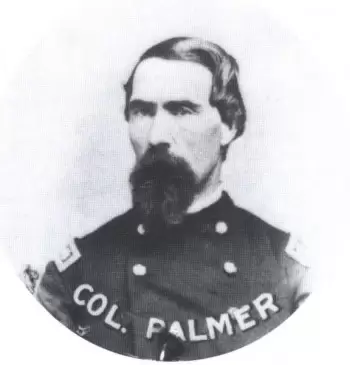
PALMER, JEREMIAH (1819-1903). Colonel, 2nd New York Heavy Artillery. Palmer was born in Herkimer, New York, a village near Utica. As per his obituary in the Brooklyn Daily Eagle, he was a contractor who constructed many miles of the New York Central Railroad (completed in 1853) and helped expand the Erie Canal. During the Civil War, he enlisted as a colonel on September 12, 1861, at Utica, New York, and was commissioned into the 2nd New York Heavy Artillery, a unit that he organized, on October 17. An article about the organization of that regiment appeared in the New York Tribune on October 19, 1861, and it was referred to as Palmer’s Battery of Artillery. According to his muster roll, he was a merchant who was 6′ tall with grey eyes, brown hair and a light complexion.
Palmer’s military record was marked by two blemishes. On August 2, 1862, he was dismissed from service for “trying to create a bad feeling amongst the enlisted men against his commanding officer.” Apparently after returning to duty, he was then dismissed again on February 21, 1863, for incompetence because of an unsatisfactory report from the Board of Examination. He soon rejoined the unit as lieutenant colonel and was commissioned in on March 14, 1862. Palmer led the 2nd at the assault on Petersburg, Virginia, where he was wounded in the left shoulder on June 19, 1864; the Brooklyn Daily Eagle incorrectly notes that he was injured at the Battle of the Wilderness. After that injury, in which the bullet came close to his heart and exited his body under his shoulder blade, he was too weak to resume command of his regiment. He was discharged from service on December 7, 1864.
A builder and contractor in civilian life, Palmer lived in Brooklyn for more than thirty-five years. Active in the Republican Party, he was the water registrar in Brooklyn. Among the buildings that he constructed were the Puritan Church at Lafayette and Marcy Avenues and a row of twelve houses on DeKalb Avenue in Brooklyn. The 1870 census listed him as a carpenter. In 1879, his application for an invalid pension was approved, certificate 193,415. As per the 1880 census, he was married, lived at 831½DeKalb Avenue and was a builder. The 1884 Brooklyn Directory lists him as a builder. The Veterans Schedule of 1890 confirms his Civil War service. Melissa Palmer, Jeremiah’s wife, died in 1898, and was buried in Mohawk Cemetery in Herkimer, New York. The 1900 census shows that Palmer was living as a boarder at 831½ DeKalb Avenue, a house that he built, and was working as a carpenter.
An article in the New York Sun in 1902 reported that Palmer, an old veteran of two wars, was a complainant in police court on Gates Avenue seeking the return of jewels that he had given to a young widow, Mamie Murphy, who was 25 years old. Apparently, when the widow’s husband was sick, she and her husband, family friends, lived with Palmer. She needed jewelry to attend a ball and Palmer provided her with several hundred dollars worth of gems. After her husband died, Palmer asked her to marry him but she refused. The magistrate ordered her to give up the jewels, citing that “she should be ashamed of herself”; Palmer was still forlorn that she had rejected his advances.
The circumstances of Palmer’s death are controversial. A widower who boarded with a family at one of his houses at 831½ DeKalb Avenue, he was found dead in his armchair. Although some attributed his death to heart disease, there were gas fumes in the room suggesting that he died from asphyxiation. As per an article in the Brooklyn Daily Eagle on March 19, 1903, the coroner was called in to investigate his death; suicide was ruled out because Palmer was planning a trip. That article noted that Palmer was survived by a sister who was likely to inherit a large estate. As per an article in the Waterville Times, Mrs. John Carr of Herkimer, whose husband was a bootblack, inherited one-fourth the share of the $100,000 Palmer’s estate (an estate equivalent to $2.7 million in 2018); the Palmers had no children, enumerated nieces and nephews were the other heirs. Section 86, lot 31217, grave 130.
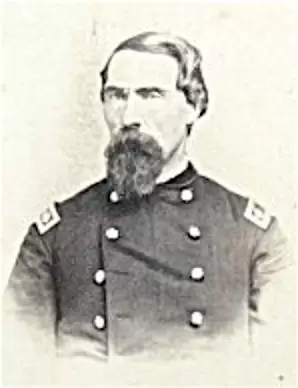
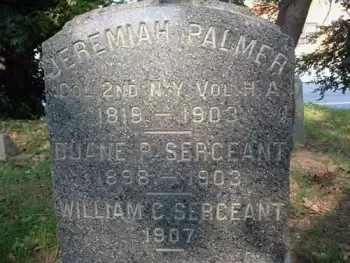
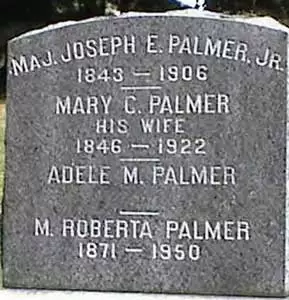
PALMER, JR., JOSEPH E. (1843-1906). Major and captain by brevet; adjutant, 158th New York Infantry, Companies G and C. Palmer was born in New York City. After enlisting at Brooklyn on August 20, 1862, as a sergeant, he mustered into Company G of the 158th New York eight days later. As per his muster roll, Palmer was 5′ 7″ tall with grey eyes, dark hair and a dark complexion. During his service, he rose to sergeant major on December 11, 1862, to second lieutenant on June 6, 1863, effective upon his transfer to Company C, to first lieutenant on September 1, 1863 (with rank from January 5, 1863), and to adjutant on October 31, 1864 (with rank from January 22, 1864). Upon achieving the rank of adjutant he was transferred that day to the regiment’s Field and Staff. An article in the Brooklyn Daily Eagle in 1864 noted that while hospitalized at Bermuda Hundred, Palmer learned that his regiment was engaged at the front and thereupon left the hospital to rejoin his regiment. He was brevetted major of United States Volunteers dating from April 9, 1865, “for gallant and meritorious services during the War,” and brevetted captain “for gallant and meritorious services during the campaign of April 1865, against the army of General Lee.” On June 30, 1865, he mustered out at Richmond, Virginia.
As per the New York State census of 1865, Palmer lived with his parents and siblings in Brooklyn and was a bookkeeper for the Army. The 1870 census notes that he lived in Brooklyn with his wife and one-year-old daughter and was a clerk for the Water Board. At the time of the 1875 New York State census, he lived in Brooklyn with his wife, two daughters and a servant and was listed as an oil painter and artist. He was listed as an artist living at 363½ Van Buren Street in the 1877 Brooklyn Directory. Palmer was active in Democratic politics, and was secretary to James Jourdan (see), under whom he had served in the 158th, when Jourdan was president of the Kings County Elevated Railroad Company. On October 28, 1879, the Utica Morning Herald and Daily Gazette reported that Palmer, a former clerk in the Department of the Brooklyn City Works, alleged that William Fowler, while president of the water commissioners, illegally expended $800,000; Fowler denied the accusation and called the charges “old and exploded.” According to the 1880 census, Palmer was listed as a landscape painter who lived in Brooklyn with his wife and children.
Remaining active in military affairs, Palmer served as the national commander of the Union Veteran Legion, a group formed in 1884. That organization was comprised of veterans who had volunteered prior to July 1, 1863, for a term of three years, had served at least two years if discharged for wounds on the battlefield, and were honorably discharged; because of those stiff requirements, the organization was much smaller than the Grand Army of the Republic (G.A.R.). An article in the Washington, D.C., newspaper, the Evening Star of August 25, 1892, discussed the planning of a suitable reception for National Commander Palmer, during Grand Army week when Palmer would be headquartered at the Riggs House in the nation’s capitol. Palmer was involved in an unfortunate incident at the Union Veteran Legion Encampment at Indianapolis in the fall of 1892. Apparently, Palmer was in favor of the rejection of the credentials of two of the delegates. Subsequently, another officer, Corporal James Tanner, who lost both of his legs at Second Bull Run, came to the defense of the two men and later confronted Palmer as being a party to the conspiracy to oust the two; Palmer and Tanner nearly came to fisticuffs. Allegedly, the disorder led to a split between the G.A.R. and the Union Veteran Legion. A Pittsburgh newspaper commended Palmer as being “the brainiest” man to lead the organization and work for its good; apparently, others in leadership positions quarreled with past commanders. The Brooklyn Daily Eagle reported on January 7, 1894, that Palmer was awarded a badge by the Union Veteran Legion in recognition of his service to that organization and to the Union for his Civil War service. The badge was made of gold, suspended from a red, white and blue ribbon with a bar inscribed in blue enamel with the name of the organization and a rank bar with three stars, denoting the rank of lieutenant general. That article notes that he was a major on the staff of the 1st Division at the surrender at Appomattox and that President Andrew Johnson later signed his commission as a life major. Further, Palmer was noted as the only Democrat who ever commanded the legion and was a candidate for the post of naval officer of New York.
The 1892 New York State census lists him as retired. He continued with his artwork and was listed as an artist on both the census of 1900 and the 1904 Brooklyn Directory; at that time, he lived at 82 Kingston Avenue. His application for an invalid pension was granted in 1903, certificate 1,059,225. His obituary in the Brooklyn Daily Eagle confirms his Civil War service and his leadership role in the Union Veteran Legion. His last residence was 82 Kingston Avenue, Brooklyn. His death was attributed to nephritis. Mary Palmer, who is interred with him, applied for and was granted a widow’s pension in 1906, certificate 619,223. As per Mary Palmer’s petition in Kings County Surrogate’s Court, he left an estate valued at less than $50. Section 41, lot 2975.
PALMER, LOWELL M. (1845-1915). First lieutenant, 1st Ohio Light Artillery, Companies C and D; private, 19th Ohio Infantry, Company F. A native of Chester, Ohio, Palmer enlisted as a private on April 24, 1861, mustered into the 19th Ohio three days later, and mustered out on August 30, 1861, at Columbus, Ohio. On October 8, 1861, he re-enlisted as a sergeant and immediately mustered into Battery C of the 1st Ohio Light Artillery. On November 23, 1863, he rose to second lieutenant and was commissioned into Battery D of the regiment. Two months after he was promoted to first lieutenant of his company on October 20, 1864, he mustered out of service on December 29.
His obituary in The New York Times, which confirms his Civil War service, notes that Palmer relocated to Brooklyn in 1866, where he became an important figure in business, philanthropy and the arts. In 1870, he established a terminal for the Erie Railroad called Palmer’s Dock in the Williamsburg section of Brooklyn. Palmer, a maker of casks and barrels, developed the dock to ship commodities directly to the area and by-pass the congested waterways in Manhattan; the dock closed in 1983. He was the head of the Brooklyn Cooperage Company, an enterprise which made the barrels for the American Sugar Refining Company of which he was a director as of 1899. As per his obituary in the Brooklyn Daily Eagle, which confirms his Civil War service as a teenager, Palmer brought the first railroad to Brooklyn in 1874, and built the first elevated coal pockets there. His interest extended to the arts and was a founder and director of the Brooklyn Academy of Music. In addition, he was president of E. R. Squibb & Sons, the pharmaceutical concern, and vice president of the Palmer Lime and Cement Company. He served as director of trustees to the Franklin Trust Company of Brooklyn, the Manhattan Life Insurance Company of Manhattan, the United States Lloyds Ship Insurance Company, the Market and Fulton National Bank of Manhattan, the Brooklyn Institute of Arts and Sciences, the Colonial Safe Deposit Company, Colonial Trust Company, New Jersey and New York Zinc Company, and the Union Ferry Company. His application for a pension in 1909 was granted, certificate 1,158,833.
As per his obituary in the New York Herald, he was a member of the Military Order of the Loyal Legion; companions were invited to attend his funeral. Palmer was also a member of the Society of Colonial Wars, the Ohio Society in New York, and was a trustee of the First Presbyterian Church on Henry Street. His last residence was 206 Clinton Avenue in Brooklyn, where he housed a fine art collection and notable private library. Palmer died at his country home, Edgewood, in Stamford, Connecticut. His death was attributed to heart disease. In 1915, Grace Palmer applied for and received a widow’s pension, certificate 804,650. An article in The New York Times on July 6, 1919, reported that Palmer’s estate was valued at $2,334,311 (about 50 million today). Section 125, lot 26169.
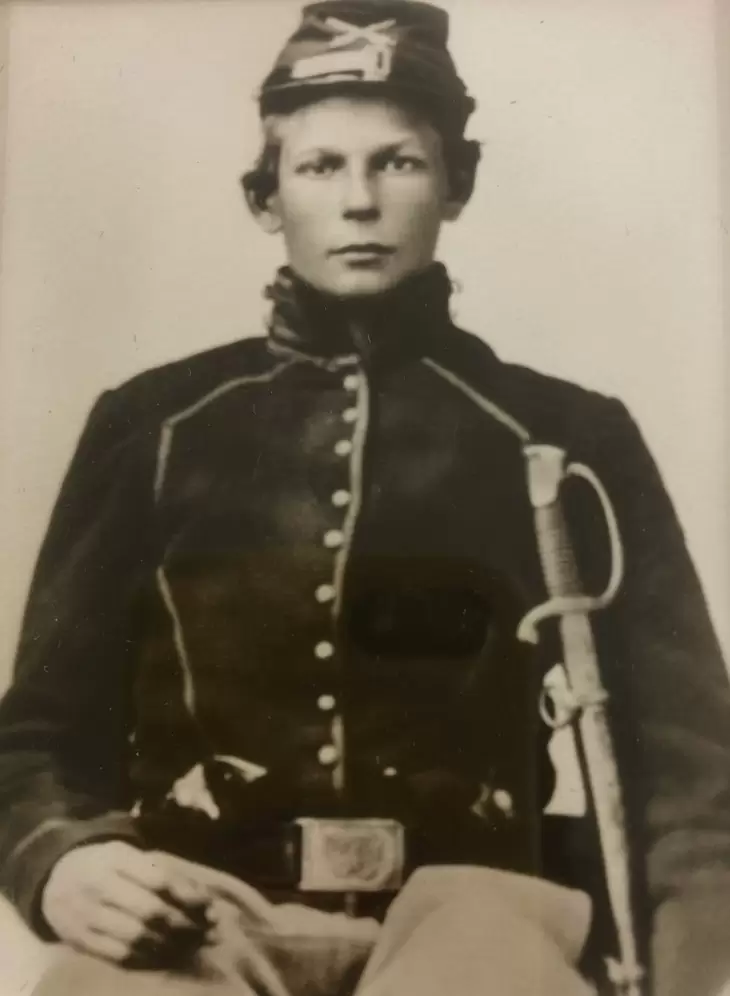
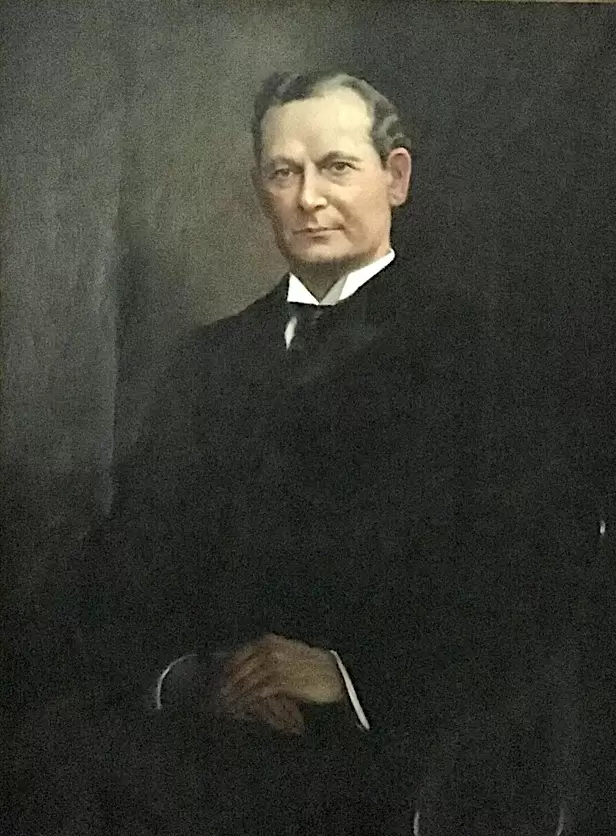
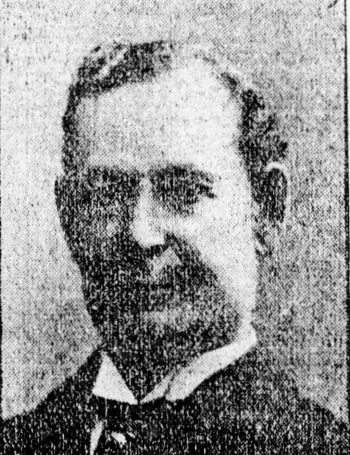
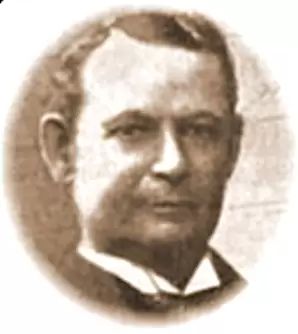
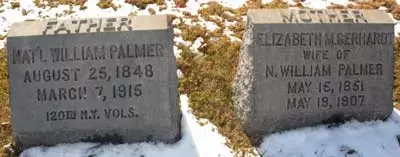
PALMER, NATHANIAL (or NATHANIEL) WILLIAM (1848-1915). Musician, 120th New York Infantry, Company E. Born in England, Palmer immigrated to the United States in 1853. During the Civil War, he enlisted as a private on August 22, 1862, at Kingston, New York, mustered immediately into the 120th New York, and was promoted to musician on December 31, 1863. His muster roll notes that he was detailed as a nurse at Corps Hospital in the summer of 1864 and at the Field Hospital in April 1865. Palmer mustered out with his company on June 3, 1865, at Alexandria, Virginia.
On October 19, 1880, Palmer became a naturalized citizen. The 1882, 1884, and 1886 Brooklyn Directories list him as a driver. In 1887, his application for an invalid pension was granted, certificate 1,092,814. As per the Brooklyn Directory for 1889 and 1890, he was still working as a driver. Remaining active in military affairs, he held leadership positions in the Moses F. Odell Post #443 of the G.A.R., including officer of the guard in 1890 and junior vice commander in 1902. The Veterans Schedule for 1890 confirms his Civil War service. The 1900 census shows that he lived in Brooklyn with his wife and children and was still employed as a driver. The 1904 Brooklyn Directory and the 1905 New York State census report that he was a clerk. As per the 1910 census, he was a watchman for the railroad. Palmer’s obituaries in the Brooklyn Daily Eagle and The New York Times, which confirm his Civil War service, indicate that he had been a Brooklyn resident for forty-five years and worked as a foreman for the Brooklyn Rapid Transit Company at its sand pit at Rockaway Avenue and Beasley Lane. As per his death certificate, he was a widower who worked as a watchman. He last resided at 394 Rugby Road in Brooklyn. His death was attributed to heart failure. Section 202, lot 32541, grave 4.
PALMER, RICHARD HENRY (1816-1864). Assistant surgeon, 10th New York Infantry; hospital steward, 170th New York Infantry, Company H. Palmer was born in Ireland. On April 5, 1846, he married Harriet Leslie at St. John’s Episcopal Church in Brooklyn. As per the 1855 New York State census, he lived in Brooklyn with his wife, three young children and a servant; he was listed as a doctor. On July 6, 1857, the New York Tribune and the American Phrenological Journal reported that Harriet Palmer, known as Hattie, the couple’s eight-year-old elder daughter, died in a tragic boating accident at Lake Ronkonkoma, New York. John Leslie, the uncle of the little girl, also perished when the boat capsized; five people survived the accident including John Leslie’s 17 year-old daughter and John W. Palmer, little Hattie’s brother. A lengthy article on the tragedy in the New York Herald of July 9, 1857, noted that the boaters were celebrating the July 4th holiday and that an experienced captain was not onboard as was usual for the family. According to the census of 1860, Palmer lived in Brooklyn with his wife, two sons and a daughter; he was listed as a physician.
During the Civil War, Palmer enlisted on August 11, 1862, and mustered into the 170th New York as a hospital steward on October 7. He was commissioned as an assistant surgeon on April 7, 1864, with rank from March 24, and transferred on April 30, 1864, at Stevensburg, Virginia, into the Field and Staff of the 10th New York. As per his muster roll, he was absent in October 1864. He died of disease at Brooklyn on December 4, 1864, while on furlough. On March 16, 1865, Harriet Palmer applied for and received a widow’s pension, certificate 74,632; at the time of her application, she lived in St. Claire, Missouri, and had two children under the age of 16. After Harriet Palmer died in 1867, John W. Palmer, guardian and elder son, applied for and received a pension for a minor, his younger brother, St. Leger Palmer, on February 2, 1869, certificate 132,194; his sister, Agnes, had reached the age of majority by that time. Section 42, lot 805.
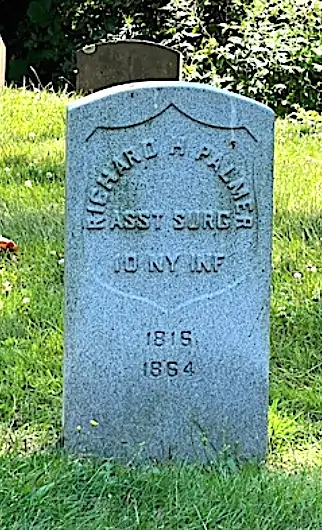
PALMER, WILLIAM (1831-1904). First lieutenant, 82nd New York Infantry, Companies B, E, and F; 15th Veteran Reserve Corps, Company D. Of Irish birth, Palmer enlisted as a private at New York City on April 17, 1861, and mustered into Company B of the 82nd New York on May 21. He became a first sergeant of Company B and then on April 30, 1862, was commissioned as a second lieutenant, effective upon his transfer to Company E on June 24. Palmer’s promotion to first lieutenant on June 20 became effective upon his transfer to Company F on December 27, 1862. He was severely wounded in the left ankle at Cemetery Ridge at the Battle of Gettysburg, Pennsylvania, on July 2, 1863, necessitating the amputation of that limb. He was transferred to the 15th Veteran Reserve Corps on June 24, 1864, from which he was discharged on June 30, 1866. His application for an invalid pension was granted on October 22, 1866, certificate 80,927.
Palmer was a member of the G.A.R.’s James C. Rice Post #29 in New York City as of June 18, 1881. A businessman in plumbing and steam-fitting in New York City, he was active in civic organizations such as the Odd Fellows and the Guiding Star Lodge. His military service was noted in his obituary in The New York Times. He died at the home of his niece in Fishkill, New York. His death was attributed to heart failure. His wife applied for and received a widow’s pension shortly after his death, certificate 591,452. Section 174, lot 18375, grave 5.
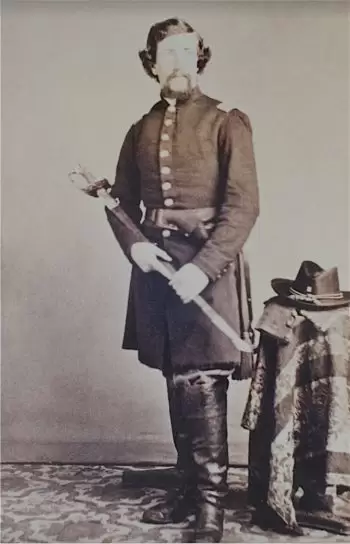
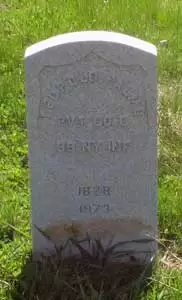
PALMO, LEOPOLD (1828-1873). Private, New York Union Coast Guard, Company G; 99th New York Infantry, Company C. Originally from Naples, Italy, Palmo was hospitalized for one day at the Charity Hospital in New York City in November 1851 for ptyalism (excessive saliva); he was listed as a barkeeper on his admission data. During the Civil War, Palmo enlisted as a private on May 28, 1861. On June 14, 1861, he mustered into Company G of the New York Union Coast Guard and transferred into the 99th New York on September 1, 1861, as a private. As per his muster roll, Palmo often served as a cook in the Regimental Hospital and was hospitalized at the General Hospital in Fort Monroe, Virginia, in September 1863. He mustered out on July 2, 1864, at New York City. As per his death certificate, he was single and worked as a trader. His last residence was 50 Centre Street in Manhattan. His death was attributed to “debility.” Section 114, lot 8999, grave 728.
PANGBORN, RICHARD E. (1844-1876). Private, 1st New York Sharpshooters, 9th Company. A Brooklynite by birth, Pangborn enlisted as a private at Lebanon, New York, on October 7, 1862, mustered into the 1st Sharpshooters on January 22, 1863, and mustered out on August 5, 1863, at Albany, New York. According to the 1870 census, he was a clerk in a paint factory living in Brooklyn, owned real estate valued at $16,000, and personal property worth $2,000. His last residence was 32 Braxton Street in Brooklyn, where he succumbed to diarrhea. Section 115, lot 20864.

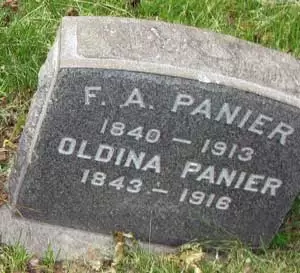
PANIER, FREDERICK ALEXIS (1840-1913). Corporal, 17th New York Infantry, Company D. A native of Paris, France, Panier immigrated to the United States from Hamburg, Germany, aboard the Humboldt on July 16, 1860, and arrived in New York City. As per the passenger manifest, he was a barber. During the Civil War, he enlisted at New York City as a private on May 20, 1861, and mustered into Company D of the 17th New York that same day. His soldier record, which is filed as Frederick Parrier, notes that he was taken as a prisoner of war at the Battle of Second Bull Run on August 29, 1862. As per his muster roll, he was present on October 21, 1862. He was promoted to corporal on January 27, 1863, detached to the Provost Guard until April 1863, and mustered out at with his company at New York City on June 2, 1863.
On October 28, 1864, he became a naturalized citizen; that document uses the spelling “Paniery.” The New York State census of 1865 reports that he lived in Brooklyn and worked as a barber. He is also listed as a barber at 71 Court Street in the 1868 Brooklyn Directory. Articles in the Evening Telegram and Brooklyn Daily Eagle of October 27, 1869, note that Panier’s apartment was burglarized after the thieves scaled a fence and gained entry through a rear window; $68.00 worth of jewelry was taken. Panier’s obituary in the Brooklyn Daily Eagle, which confirms his Civil War service, notes that he became a costume designer after the Civil War, first on Atlantic Avenue and then on Fulton Street in Brooklyn. The 1875 New York State census lists him as living in Brooklyn with his wife and two children and mother-in-law; he was working as a costumer at that time. Panier is listed as a costumer in the Brooklyn Directories for 1877, 1881, 1888 and 1889 and on the 1892 New York State census. He was the costumer for the Emma Abbott Opera Company at the Park Theater. He then designed costumes and directed carnival tableaux for the Brooklyn Saengerbund, a singing club of which he was an honorary member for forty years, and other German societies. He also directed, costumed and acted in productions of the Ulk Dramatic Club.
The 1890 Veterans Schedule confirms Panier’s Civil War service. In 1897, his application for an invalid pension was approved, certificate 962,651. The 1900 census and the 1910 census report that he lived in Brooklyn with his wife and owned a costume shop. His death certificate indicates that he was a costumer and was married. As per his obituary in the Brooklyn Daily Eagle, Veterans of the 17th Regiment, the Brooklyn Saengerbund and the Ulk Dramatic Club were invited to attend his funeral. His last residence was 55 Ashland Place in Brooklyn; Panier had lived in Brooklyn for fifty-two years. The Brooklyn Daily Eagle reported that his death was attributed to “brain trouble”; the New York Herald, which also confirms his Civil War service, notes that he died from general debility. Shortly after his death in 1913, his wife, Oldina (Ottilie, Delia) Panier, who is interred with him, was granted a widow’s pension, certificate 765,866. Section 16, lot 14888, grave 83.
PANNES, JOHN B. (1837-1909). Captain and aide-de-camp, United States Volunteers; captain, 178th New York Infantry; ordnance officer, 17th New York Veteran Infantry, Company I; first lieutenant and adjutant, 9th New York Infantry, Company A. Born in Cologne, Germany, Pannes immigrated to the United States when he was nineteen years old. He filed papers for naturalization on September 6, 1859. During the Civil War, he enlisted as a private at New York City on April 23, 1861, and mustered into Company A of the 9th New York, known familiarly as Hawkins’ Zouaves, on May 4. He was promoted to sergeant on October 14, 861, and to quartermaster sergeant on March 20, 1862, at which time he transferred into the Field and Staff. On May 20, 1863, he mustered out at New York City. Pannes re-enlisted as first lieutenant on June 5, 1863, at New York City, and was commissioned into the Field and Staff of the 9th New York four days later. He was promoted to first lieutenant and adjutant upon his enlistment. On October 14, 1863, he mustered out at New York City when his regiment was consolidated with the 17th New York Veteran Infantry. As per The History of the 9th Regiment by Lieutenant Matthew J. Graham, Pannes was slightly wounded in the neck at the Battle of Antietam on September 17, 1862, where he was commanded by Lieutenant Colonel Edgar A. Kimball (see), and was one of the men who became an officer when the regiment was consolidated. He was commissioned into Company I of the 17th on December 30, 1863, the same day as his promotion to second lieutenant.
On January 15, 1864, Pannes achieved the rank of acting ordnance officer of the 16th Army Corps in the Mississippi. Major General A. J. Smith, in his report to headquarters describing the operations in Red River, Louisiana, in 1864, commended Pannes for his untiring efforts, and wrote of his staff, “Arms, eyes, and heads seemed their main attributes during the whole campaign.” Subsequently, he served as a captain in the 178th New York, effective after he was commissioned into that regiment on March 14, 1865. He was appointed captain and aide-de-camp of United States Volunteers on March 23, 1865, relieved of military responsibilities on September 4, 1865, as per Special Order no. 43, Extract 14, and mustered out October 12, 1865.
After returning to New York City, Pannes studied law and was admitted to the bar on December 16, 1868. According to his obituary in The New York Times, which confirms his Civil War service, Pannes was a law partner of his former commander, General Rush C. Hawkins, and another comrade, George A. C. Burnett, from the end of the Civil War until 1907, in the firm Hawkins, Barnett & Pannes; subsequently, he was a senior partner at the law firm of Pannes & Blau. The 1870 census indicates that he was a lawyer living in New York City in the household of Caroline Clark. The New York Times reported on February 28, 1877, that Pannes was elected president and treasurer of the New York Dispensary.
Active in German organizations, he was a founding member of the Arion Society, a German-American musical organization, and was twice its president. The New York Times reported on December 21, 1894, that Pannes was elected an officer of the German-American Reform Union, an organization that hoped to become a political party, in the primary held in the Nineteenth Assembly District. Further, it was reported that Pannes, in his role as president of the German-American Citizens Union, addressed the New York State Senate Committee on Taxation and Retrenchment and the Assembly Committee on Excise; he noted that reform was not exclusive to any class or sect of the citizenry. The New York Herald reported on February 28, 1896, that Pannes, representing the German-American Citizens Union, went to Albany with Carl Schurz and other notables of German heritage, bearing a petition with 115,000 signatures asking that New Yorkers be permitted to vote on the sale of beer and other spirits on Sundays between the hours of 1:00 and 10:00 p.m. An article in the New York Tribune on October 1897 noted that Pannes was elected president of the Bürgerbund Executive Committee. In that article, it was noted that the group cooperated with the workers in the Citizens Union, which shared the building, and that although the German members of the Citizens Union were not all Republicans, they favored municipal reform and supported the candidacy of Seth Low. In addition, the German-American Citizens Union believed that Low would support their position on the liquor laws.
On April 19, 1890, when Pannes was president of the Hawkins’ Zouaves, he extended an invitation of “Peace and Good Will” to the 3rd Georgia Volunteers for a reunion with their former foes. As per his passport application of April 30, 1900, for a sailing to Antwerp, Belgium, he was a lawyer who was 6′ tall with a high forehead, light brown eyes, a long nose, grey hair, fair complexion, full face and broad chin. In 1891, Pannes was president of the Liederkranz of New York, a male singing society. In 1900, he was living with the Clark family on Park Avenue in New York City. In 1905, his application for a pension was approved, certificate 1,104,059. According to his death certificate, he was single, a lawyer and was interred at Fresh Pond, Long Island, on March 10, 1909; his Green-Wood burial date is listed as April 24, 1909. As per his obituary in the New York Herald, members of the Hawkins Zouave Association (9th New York) were invited to attend his funeral. He last lived on East 92nd Street in Manhattan. His funeral took place at the Arion Society’s clubhouse on Park Avenue and East 39th Street. Section F, lot 18530.
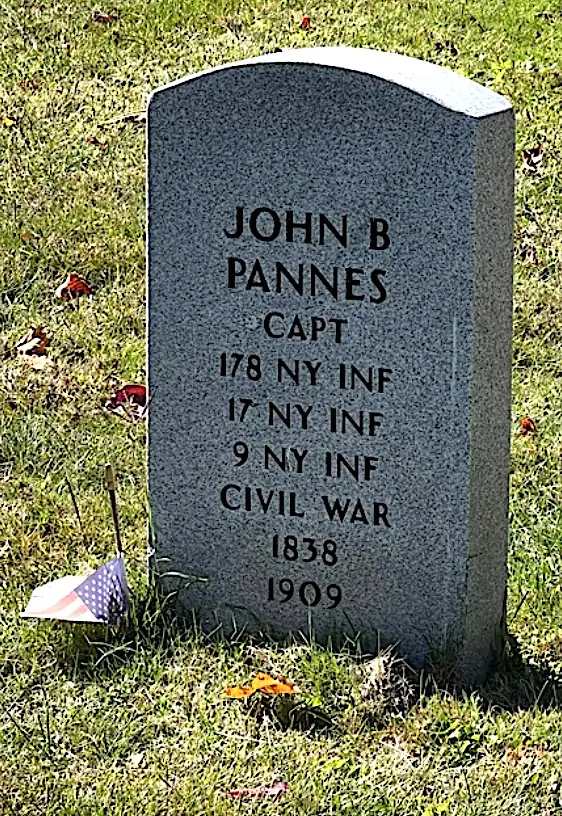
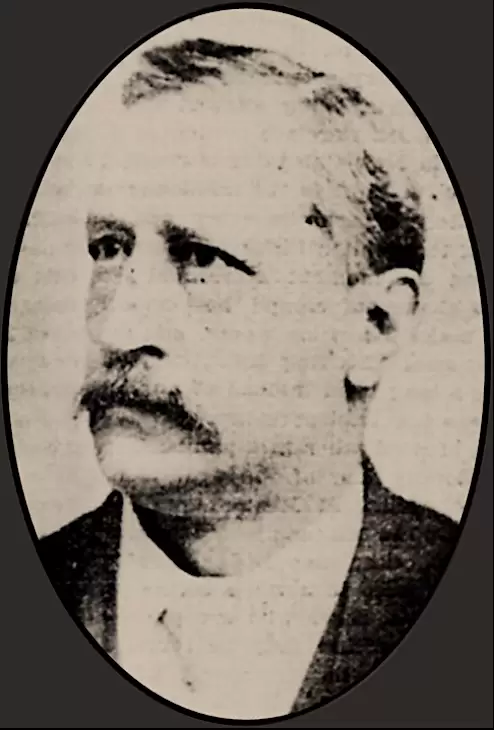
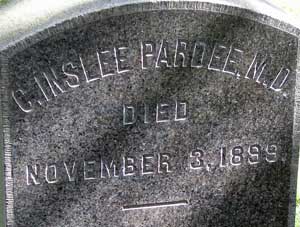
PARDEE, CHARLES INSLEE (1837-1899). Assistant surgeon, 16th New York Infantry; 4th New York Brigade State Militia. Pardee was born in Romulus, New York, in Seneca County. His ancestry can be traced to William Brewster of the Mayflower settlers. Pardee was a graduate of the Medical Department of the University of the City of New York, class of 1860. During the Civil War, he enlisted on August 30, 1862, at New York City, and was commissioned into the Field and Staff of the 16th New York on September 13, 1862. According to his muster roll, which indicates an incorrect birthplace of New York City, Pardee was a physician who was 5′ 5″ tall with blue eyes, brown hair and a dark complexion. As per his obituary in the resolutions of condolence of the Military Order of the Loyal Legion, a patriotic organization comprised of Civil War officers, and of which he was a member, he was assigned to the hospital at Frederick, Maryland, after the Battle of Antietam. He then was at the front with the 16th at Fredericksburg, Virginia, in December 1862, participated in the historic mud march of Burnside’s army, and in the Battle of Chancellorsville, Virginia. He mustered out on May 22, 1863, at Albany, New York. Subsequently, he served in the Field and Staff of the 4th Brigade, New York State Militia, in 1863.
Pardee returned to his medical practice, serving as an assistant surgeon at the Manhattan Eye and Ear Hospital beginning in 1866 and becoming its director in 1875. He is listed as a physician living in Manhattan in the census of 1870 and in the 1874 and 1877 New York City Directories. Among his other medical affiliations included his service as a contract surgeon to the New York City Asylum for the Insane, lecturer on Diseases of the Eye and Ear at the University of the City of New York, secretary of the Alumni Club at the aforementioned institution from 1870-1876, president of that organization from 1876-1877, professor of otology (anatomy and diseases of the ear) at the University of the City of New York, 1874-1897, and dean of the University Medical College from 1878 through 1897. In 1879, he was a founding member of the American Medico-Psychological Association because of his connection to the Manhattan State Hospital, and served as its secretary throughout his lifetime. On May 15, 1897, The New York Times reported that the New York University Medical College was formed by merging the Bellevue and the University Schools. When the staff was reorganized, Pardee was named professor emeritus of otology. In addition, he was a member of the New York Academy of Medicine and other medical societies.
Proud of his colonial roots, he was a life member of the New England Society. He also was a life member of the Lotos Club, of which he was a vice-president, the Union League and fleet surgeon of the American Yacht Club. His death certificate notes that he was married and a doctor; it also notes that he was cremated at Fresh Pond. In its tribute of condolence, the Loyal Legion noted that Pardee considered his interest in that organization “a valued inheritance of the war, and to wear the button a great distinction.” The Farmer’s Review of Seneca, New York, posted the notice of his death and his birthplace in Romulus. He last lived at 6 East 43rd Street in Manhattan. His death was attributed to apoplexy. Section 101, lot 4734, graves 9 and 10.
PARET, HIRAM K. (1829-1898). First lieutenant, 95th New York Infantry, Company A. As per the 1850 census, Paret, a New York native, lived with his parents and siblings in New York City and worked as a gold beater, a tradesperson who hammered gold to make gold leaf. The 1860 census reports that he lived in New York City with his wife and young child; he still worked as a gold beater and had a personal estate worth $1,200. After enlisting at New York City as a first sergeant on October 1, 1861, Paret mustered into the 95th New York on October 17. He was promoted to second lieutenant on July 28, 1862, discharged on March 6, 1863, and returned to service when he was commissioned a first lieutenant on March 15, 1864, with rank from February 1, 1864.
The Jersey City Directories for 1872 and 1889 and the 1880 census note that Paret was still working as a gold beater; the census notes that the family lived in Jersey City and that Paret’s 20-year-old daughter, Fanny, was also a gold beater. In 1890, his application for an invalid pension was approved, certificate 650,064. As per the Jersey City Directory for 1898, Paret and his sons, William and Francis, were gold leaf manufacturers at 45 Ogden Avenue; the firm was known as Hiram K. Paret & Sons. As per his obituary in the New York Herald, he was a Freemason; his comrades of the Pyramid Lodge held a special tribute honoring him. His last residence was 55 Ogden Avenue, Jersey City, New Jersey. His death was attributed to chronic nephritis. Shortly after his death, Mary H. Paret, who is interred with him, applied for and received a widow’s pension, certificate 474,567. Section 84, lot 6118, grave 4.
PARISEN, JR., OTTO W. (1822-1870). Captain and regimental quartermaster, 9th New York Infantry, Company C; lieutenant, 122nd New York Infantry, Company F. A native New Yorker, he lost his father when he was an infant. The 1847 New York City Directory lists him as a dancing master. The 1850 census reports that he lived in Hoboken, New Jersey, with his wife Augusta and worked as a bookkeeper in New York City. Parisen was also a baseball player in the early days of the sport, playing for the Knickerbockers, a pioneering team organized in Manhattan. He married his second wife, Pamela Kies, in 1853. As per Base Ball Founders by Peter Morris et. al., he was a club member of the Knickerbockers in 1854, and likely played in their first contest covered by the press on July 5, 1853. As per the Hoboken City Directory for 1861, he still lived in Hoboken.Parisen was also active in the Hoboken Highwood Guard, a militia unit.
As per Baseball in Blue & Gray: The National Pastime During the Civil War by George B. Kirsch, the names of baseball players who answered President Abraham Lincoln’s call to arms were published in The Clipper. Sportsmen were admonished in The Clipper, “Better join in, boys, than be loafing the streets or hanging around bar-rooms, and thus show people you have some noble traits that atone for whatever bad ones you get credit for.” Parisen’s name and service history were noted in that book. Parisen enlisted as a captain at New York City on April 23, 1861,, and was commissioned into the 9th New York (known familiarly as Hawkins’ Zouaves), Company C, a company he helped organized on May 4. On June 3, 1861, the ladies of Hoboken presented Parisen with a beautiful stand of colors at Riker’s Island, New York Harbor, before the regiment left for the seat of war. The regiment numbered 800 men and with the large crowd in attendance, the scene was resplendent with military and patriotic ardor. Parisen was discharged on August 10, 1862, to accept another position in the regiment. During his first enlistment, he served in campaigns in Virginia, North Carolina, and Maryland, where he was wounded in the knee at the Battle of Antietam on September 17, 1862, and hospitalized. As per Baseball Founders, Parisen recuperated at home after his hospitalization and was presented with a gold medal by the Hoboken Highwood Guard decorated with a shield embossed with an American eagle. The medal noted that he also participated at the Battles of Hatteras, Roanoke, Winton, Camden, Gatesville and South Mountain and that, “He has borne the reputation of being one of the best officers in the regiment, and he will soon return to again add his weight in the defense of the Union and the constitution.” As per J. H. E. Whitney’s The Hawkins’ Zouaves, Parisen was cited by Lieutenant Colonel Edgar A. Kimball (see) for an honorable mention for heroic actions at the Battles of South Mills, South Mountain and Antietam. Subsequently, he re-enlisted as a first lieutenant and regimental quartermaster in the 9th as of October 4, 1862, and mustered out at New York City on May 20, 1863.
Parisen re-enlisted as a first lieutenant at Sandusky, Ohio, on January 15, 1864, and was commissioned into the 122nd New York Infantry on February 22, 1864. Base Ball Founders notes that Parisen was in Johnson’s Island, Ohio (where there was a Confederate prisoner of war camp), in March 1864, just four months before Ohio’s earliest New York-ruled game, but there is no evidence that he played in that contest. As per his muster roll, he was detached as an aide-de-camp to Brigadier General Alexander Shaler in February 1864, and was absent and sick from July 1864 through the fall of that year. He mustered out with his company at Washington, D.C., on June 23, 1865; the discharge date on his pension records is July 17, 1865.
The 1866 Hoboken City Directory indicates that he lived there at 66 Washington Street. As per the 1869 Hoboken City Directory, he was a bookkeeper who lived at 54 Seventh Street. His obituary in the New York World confirms his Civil War service. He last lived at 38 6th Street in Hoboken. Pamela Kies Hillier, his second wife, who remarried after Parisen’s death, applied for and received a widow’s pension in 1896, certificate 848,098. Lot 17700, grave 68.
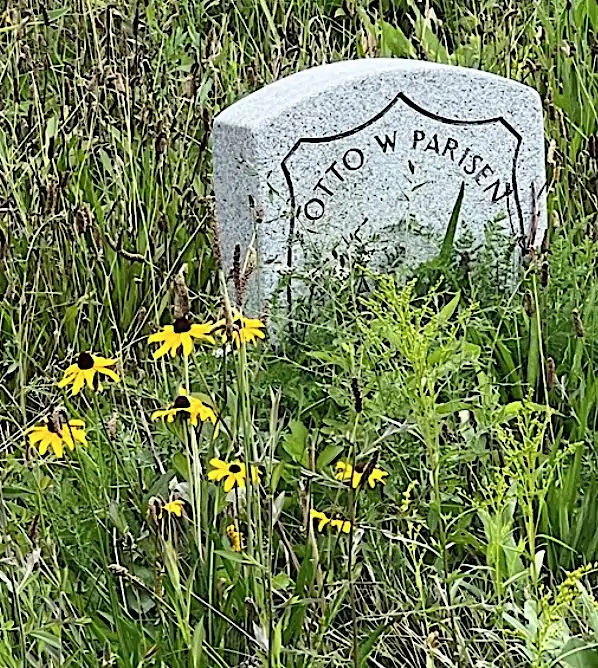
PARISEN, PHILIP J. (1824-1862). Lieutenant colonel, 57th New York Infantry. A native New Yorker, he enlisted there on September 27, 1861, and was commissioned into the 57th New York’s Field and Staff as its major on November 11, 1861. Promoted to lieutenant colonel on March 3, 1862, he commanded the 57th in Virginia at the Seven Pines’ Battle, June 25-July 2, 1862. He also commanded the 57th at the Battle of Antietam, Maryland, on September 17, 1862, and was killed in action on that day. He was interred at Green-Wood six days later. Section 189, lot 16361.
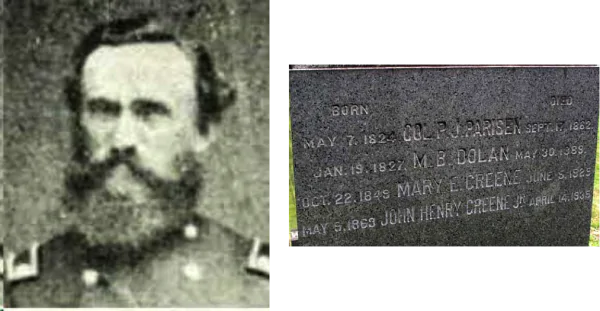

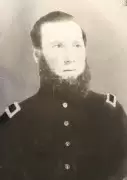
PARISEN (or PARISON, PARISEU), SAMUEL (1840-1880). Second lieutenant, 47th New York Infantry, Companies F and H. Born in New York City, Parisen enlisted at Brooklyn on August 4, 1861, and mustered into Company F of the 47th New York on September 14. As per his muster roll, he was a soldier who was 5′ 7″ tall with gray eyes, light brown hair and a light complexion. During his service, he rose to corporal and first sergeant before he was reduced to ranks. He re-enlisted on February 29, 1864, was promoted to second lieutenant on July 1, 1865, and transferred at that time into Company H. On August 30, 1865, he mustered out at Raleigh, North Carolina.
As per the 1870 census, Parisen lived in Manhattan with his wife and worked as a store clerk. The 1877 Brooklyn Directory reports that he was a conductor who lived at 1369 Fulton Street in Brooklyn. The 1880 census notes that he lived in Brooklyn with his wife and child and worked as a conductor. Parisen died at the Homeopathic Hospital in Brooklyn. His death was attributed to an abscess on the hip joint. An application was filed for a veteran’s headstone after his death. In 1889, his widow, Margaret Thorn, who had remarried, applied for a pension, application 401,801, but there is no evidence that it was certified. Section 139, lot 19438, grave 151.
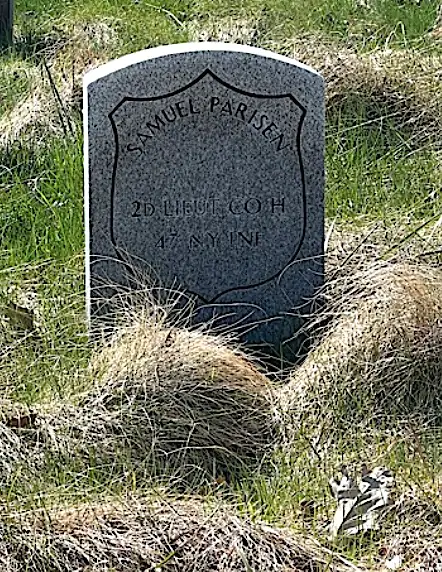
PARKER, DAVID (1840-1918). Private, 4th New York Heavy Artillery, Battery A. A New York native, Parker enlisted as a private at South East, New York, on August 30, 1862, and mustered into Battery A of the 4th New York Heavy Artillery on September 1. As per his muster roll, he was a farmer who was 5’7″ tall with black eyes, brown hair and a dark complexion. Among the actions that his battery participated in were: Lewinsville, Virginia, on October 1, 1863; the Rapidan Campaign in May-June 1864 which encompassed the Battles of the Wilderness on May 5-7; Spotsylvania on May 8-May 12; Piney Branch Church on May 8; Laurel Hill on May 10; Spotsylvania Court House on May 12-21; Landron’s Farm on May 18; North Anna River on May 23-26; Totopotomy on May 28-31; Cold Harbor on June 1-June 12 and Petersburg beginning on June 16. Parker was wounded at the Battle of Petersburg, Virginia, on June 18, 1864, and was discharged for disability on April 28, 1865, from De Camp General Hospital at David’s Island, New York Harbor. On March 9, 1869, his application for an invalid pension was approved, certificate 97,286.
The 1900 census notes that Parker was employed in real estate; the 1910 census indicates that he was living on Union Street in Brooklyn and supported his family by “his own income” and owned his home. His obituary, which confirms his Civil War service, states that he was a retired milk dealer who belonged to Sumner Post #24 of the G.A.R. and the Union Veterans’ Legion. He died at the home of his daughter at 604 West 115th Street in Manhattan. Shortly after his death, Sarah Parker applied for and received a widow’s pension, certificate 860,506. Section 140, lot 23416.
PARKER, HENRY HILLS (1845-1886). First lieutenant, 71st Regiment, New York State National Guard, Company F. Parker was born in Mount Vernon, New York. At the time of the 1860 census, he lived with his parents and siblings in New York City at the home of his maternal grandparents, Steven and Margaret Hills; his grandfather was a broker and his grandmother owned real estate valued at $15,000 (equivalent of $455,000 in 2018 money). During the Civil War, Parker enlisted at New York City on June 17, 1863, was commissioned into the 71st National Guard on June 30, and mustered out after 30 days on July 22 at New York City.
The New York Tribune reported on June 30, 1864, that Parker was awarded a Bachelor of Arts degree from Columbia College. He was a member of Delta Psi fraternity at the college; fraternity records note that he also received law and a Master of Arts degrees. On December 10, 1868, he married Elizabeth Pickman Fay in Boston, Massachusetts. The 1870 census lists Parker as a lawyer living in New York City with his grandmother, mother and siblings. Retaining his interest in military affairs, he was commissioned as a captain and aide-de-camp in the First Division, New York State National Guard, with rank from January 1, 1873. The 1875 New York City Directory lists Parker as a lawyer at 120 Broadway and a home address at 50 East 10th Street. An article in the New York Sun on November 19, 1878, lists him as among the renowned guests at the lavish wedding of James Roosevelt and Helen Astor, a marriage uniting two prominent New York families. The 1880 New York City Directory indicates that Parker still practiced law at 120 Broadway; the 1886 New York City Directory notes that he was a lawyer at 48 Wall Street and lived at 116 East 37th Street. As per his death certificate, which lists an incorrect birth year of 1802, he was a widower and a lawyer; his wife died in 1880. His obituary in The New York Times notes that his funeral was held at the Church of the Heavenly Rest at Fifth Avenue and 45th Street. The New York Evening Post, in its report of Parker’s funeral, notes that his family, well-known in New York society, had lost many relatives in a short time and was now “almost extinct.” Parker was survived by three sons. His last residence was 116 East 37th Street in Manhattan. Section 25, lot 4314.
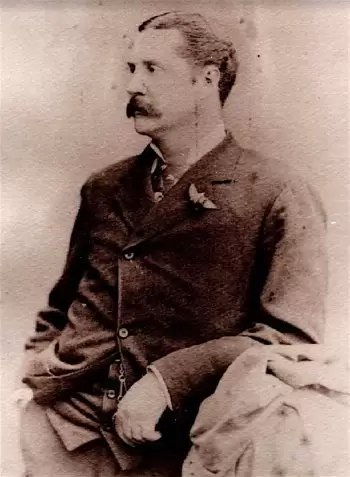
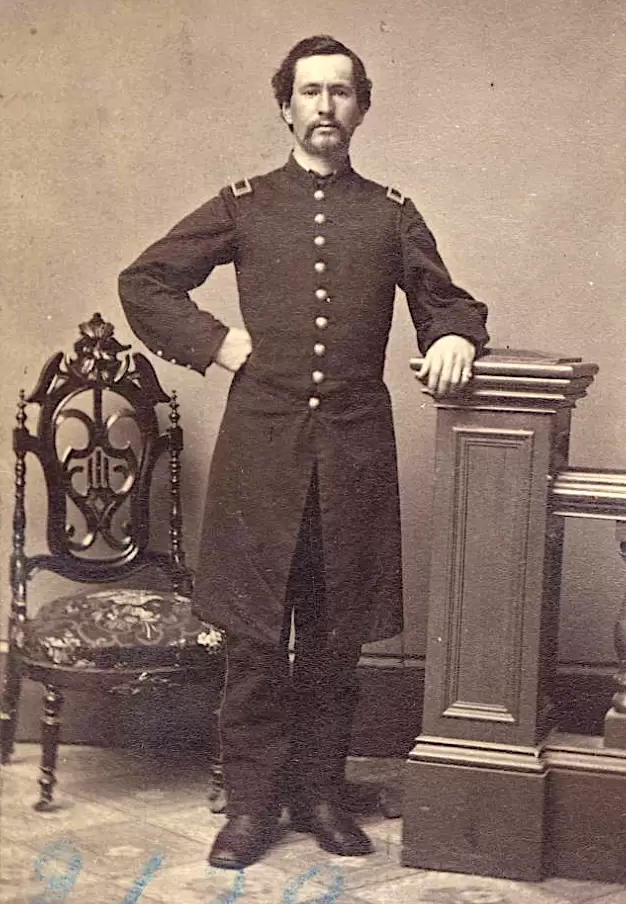
PARKER, JOHN THURMAN (1836-1904). Assistant surgeon, 169th New York Infantry. Born in Thurman, Warren County, New York, Parker enlisted as an assistant surgeon at Chapin’s Farm, Virginia, on January 2, 1864, and mustered into the Field and Staff of the 169th that day. According to his obituary in the New York Evening Post, which confirmed his Civil War service, he was one of the physicians who treated the Union officers held in squalor at Libby Prison in Richmond, Virginia, after they were liberated. He mustered out on July 19, 1865, at Raleigh, North Carolina.
Parker relocated in New York City in the mid 1870s. According to the censuses of 1870, 1880, and 1900, he was a physician. The 1890 New York Veterans Schedule confirms his military service. In 1904, he received a pension, certificate 1,089,251. His pension record indicates that he was also a contract surgeon for the United States Army. He last lived at 7 St. Nicholas Place, New York City. Parker died from chronic nephritis. Section 14, lot 10924, grave 11.
PARKER, NICHOLAS (1836-1869). Corporal, 32nd New York Light Artillery; private, 4th New York Light Artillery; 15th New York Light Artillery. Of Irish birth, Parker enlisted as a private at New York City on August 23, 1862, and mustered into the 4th Battery, New York Light Artillery, that same day. As per his muster roll, he was a coach painter who was 5′ 4″ tall with hazel eyes, brown hair and a light complexion. He transferred into the 15th Independent Battery, New York Light Artillery, on December 12, 1863, was sick and hospitalized in June 1864, and then transferred to the 32nd Battery of the New York Light Artillery on February 4, 1865, upon consolidation of the units. Parker was promoted to corporal on June 24, 1865, shortly before he mustered out with his battery at New York City on June 12. As per his obituary in the New York Daily Tribune, he was a Freemason; members of his lodge were invited to assemble to attend his funeral and pay tribute to him. His death certificate notes that he was single and a painter. He last lived at 280 West 10th Street in Manhattan. The cause of his death was pneumonia. Section B, lot 8100, grave 767.
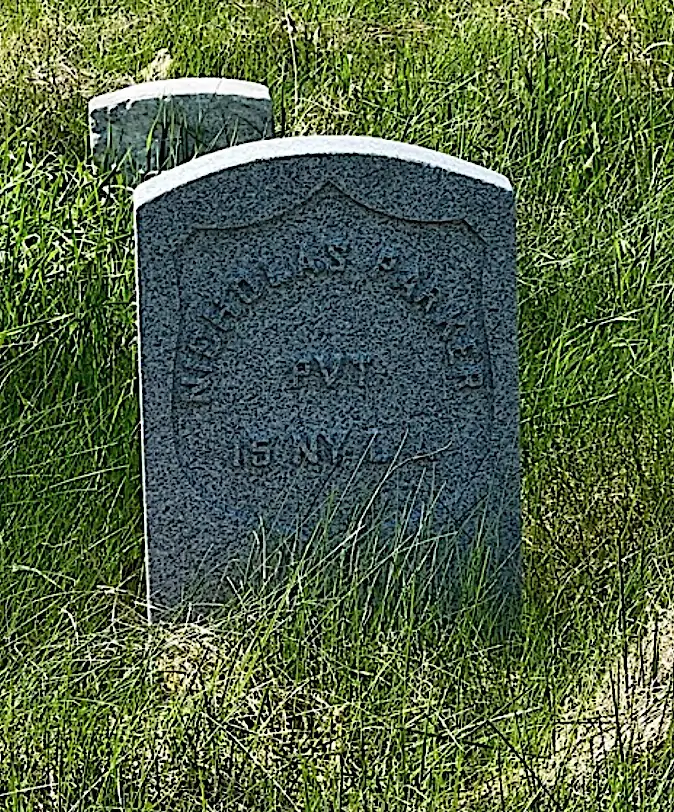
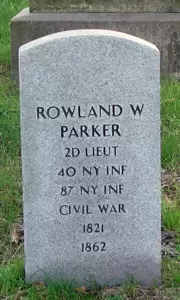
PARKER, ROWLAND W. (1821-1862). Second lieutenant, 40th New York Infantry; corporal, 87th New York, Company F. Parker was born in Massachusetts. On April 27, 1842, he married Mary Acres in New York City. As per the 1850 census, he lived in New York City with his wife, three young children, and his sister-in-law, Maria B. Acres Munroe; he worked as a leather dealer. The New York City Directories for 1857 and 1859 list him as an upholsterer and mattress maker. At the time of the 1860 census, he lived in Brooklyn with his wife and children and worked as a clerk. Parker’s life was then marked by tragedy. The New York Herald reported on October 31, 1860, that Mary Parker, his wife, had committed suicide by jumping into a cistern and drowning. That article noted that the Parkers had domestic problems, but had supposedly reconciled before the tragic suicide. Rowland Parker was left with three children, ages 13, 14, and 17.
During the Civil War, he enlisted as a corporal at New York City on October 10, 1861, and mustered immediately into the 87th New York. Subsequently reduced to ranks (private), he transferred as a sergeant into the 40th New York, known familiarly as the Mozart Regiment, on September 6, 1862. Promoted to second lieutenant on November 19, 1862, he was too ill to serve in that capacity, and died of phthisis (tuberculosis) at the Regimental Hospital in Falmouth, Virginia, on December 16, 1862. As per his obituary in the New York Daily Tribune, which confirmed his death at camp and the return of his remains to Brooklyn, his funeral was held at the home of his brother, James M. Parker, at 323 Cumberland Street. On October 8, 1863, Maria B. Munroe, guardian of his children, applied for a minor’s pension that was approved under certificate 107,387; in 1868, Munroe was granted $8.00 per month for the youngest child, Amy Parker, who had not reached the age of maturity, to date from December 1862 through July 12, 1865. As per her pension application, Parker contracted phthisis while in the line of duty; general debility was also listed as a contributing cause of his death. Section 54, lot 3649.
PARKER, SHERMAN BANTA (1842-1873). Private, 67th New York Infantry, Company G. Parker was born in Connecticut. As per the 1850 census, he lived in New York City with members of the Parker and Banta (his grandmother’s maiden name) families. The 1860 census indicates that he lived in New York City where his father, Cornelius Parker, had a “segar” store and owned real estate valued at $4,000; Sherman worked as a clerk at that time. During the Civil War, he enlisted at Brooklyn as a private on May 25, 1861, mustered into the 67th Infantry on June 20, and was discharged from the service due to disability on December 23, 1863, at Brandy Station, Virginia.
On January 29, 1870, the New York Herald reported that Julia Parker, Sherman’s 27-year-old wife, had died; members of Company B of the 12th Regiment and members of Post #36 of the G.A.R., to which Sherman Parker belonged, were invited to attend her funeral, held at her father-in-law’s residence. The 1870 census reports that he was a widower who lived in New York City with his 2-year-old son, Cornelius, worked as an exchange broker, and had a personal estate of $400. The New York City Directory for 1870 lists him as a broker at 463 Third Avenue (his father’s home address) who lived at 153 East 42nd Street; as per the 1872 New York City Directory, he was a clerk who lived with his father at 463 Third Avenue. As per his obituary in the New York Herald, members of Company B of the 12th Regiment and comrades from the Isaac Stevens Post #36 of the G.A.R. were invited to attend his funeral; members of the 12th Regiment, of which he was a corporal, were asked to assemble at the Armory in civilian dress. St. Louis newspapers were asked to reprint his obituary. His funeral was held at the residence of his father at 463 Third Avenue in Manhattan. His death was attributed to tuberculosis.
In 1880, an application for a minor’s pension was filed for Parker’s 12-year-old son, Cornelius, application 299,572, but it was never certified. Sherman’s half-brother, Cornelius B. Parker, who lived at the same 463 Third Avenue address, was cited in numerous news articles from 1876-1896 as being the “Policy King,” a backer of numerous policy shops, where monies were advanced in gambling operations and the backer collected a large cut of any winnings. The New York Herald reported on May 12, 1896, that after a two-week trial on charges arising from his gambling operations, Cornelius Parker pleaded guilty, promised to reform, and paid a $500 fine.
Sadly, On June 2, 1918, Sherman Parker’s son, Cornelius Banta Parker, drowned when the SS Carolina, a passenger liner carrying civilians and sugar cargo, was torpedoed by a German submarine off the coast of Puerto Rico; ultimately, Germany agreed to pay the Parker estate $37,155 in April 1924. Section 17, lot 17245, grave 180.
PARKIN, FREDERICK (or FREDRICH) HENRY (1843-1873). Sergeant, 37th Regiment, New York State National Guard, Company D. Originally from Prince Edward Island, Canada, Parkin was baptized there at Charlottetown on October 18, 1843, about seven months after his birth. During the Civil War, he enlisted at New York City as a sergeant and served with the 37th Regiment when it was activated for 30 days in 1863 from June 18 through July 22; the 37th was attached to the Department of the Susquehanna and was in Pennsylvania at Sporting Hill on June 30 and at Carlisle on July 1. He also served when the 37th was activated in 1864 from May 6 through June 6; at that time, the Regiment served in New York Harbor. Parkin’s death certificate indicates that he was married and was employed as a painter. As per his obituary in the New York Herald, friends and relatives and members of the 37th Regiment were invited to attended his funeral at the Trinity Methodist Episcopal Church at West 34th Street and Eighth Avenue in Brooklyn. He was the brother of George (see) and Henry K. Parkin (see). His last residence was 201 West 21st Street in Manhattan. Section 177, lot 13380.
PARKIN, GEORGE EDWARD HIFFERLY (1830-1862). First sergeant, 72nd New York Infantry, Company C. Born in Harbour Grace, Newfoundland, Canada, he enlisted as a first sergeant at Staten Island on April 28, 1861, and mustered into the 72nd on July 21. He was killed in battle at Williamsburg, Virginia, on May 5, 1862, and was interred at Green-Wood on May 18 of that year. He was the brother of Frederick (see) and Henry K. Parkin (see). As per his obituary in the New York Tribune, which noted his rank as orderly sergeant, his remains were brought to the home of his parents at 349 West 35th Street in Manhattan for his funeral prior to burial; friends and relatives were invited to attend. Section 177, lot 13380.
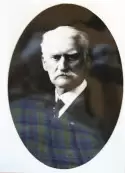
PARKIN, HENRY HITCHKOCK (1840-1922). Lieutenant, 71st Regiment, New York State National Guard, Company F. Parkin was born in New Rochelle, New York. The 1855 New York State census shows that he lived in New York City with his parents and siblings; his father was a physician. As per the 1860 census, he lived with his parents and siblings in New York City; his father was listed as a “gentleman” whose real estate was valued at $40,000 (equivalent to 1.2 million in 2018 money) and whose personal property was worth $6,000 (about $180,000 in 2018).
During the Civil War, Parkin enlisted and mustered into the 71st Regiment on May 27, 1862, at New York City, and mustered out there after three months on September 2. Parkin also served in the same regiment and company in 1863; his sketchbook for the G.A.R. notes that he was a lieutenant during the 1863 activation from June 17 through June 22 of that year.
In 1867, he married Cora Baldwin in Manhattan; that same year, he was listed as a merchant in the New York City Directory. The 1880 census notes that he was a paint broker who lived with his wife and children on DeKalb Avenue in Brooklyn. On May 21, 1909, he mustered into Lafayette Post #140 of the G.A.R.; at that time, he noted that he was retired. In 1908, his application for a pension was approved, certificate 1,115,584. The 1910 and 1920 censuses indicate that Parkin was a boarder in Manhattan; in 1910, he indicated that that he supported himself by “his own income.” As per his death certificate, he was a widower. He last lived at 43 West 58th Street in Manhattan. Section 32, lot 3609.
PARKIN, HENRY KNIGHT (1837-1896). Sergeant, 37th Regiment, New York State National Guard, Company D. Parkin was born in Prince Edward Island, Canada. During the Civil War, he served as a sergeant in the 37th Regiment, New York State National Guard for 30 days in 1864. At the time of the 1870 census, he lived with his parents and was in the lumber business. The 1872 New York City Directory lists him as a clerk whose home address was 250 West 37th Street. According to the 1880 census, he was married with one son, lived with his parents and was a lumber dealer. Parkin was listed as a clerk in the New York City Directories for 1883 and 1888. He joined Lafayette Post #140 of the G.A.R in June 1890; at that time, he lived at 314 West 31st Street and was in the lumber business. He was the brother of Frederick (see) and George Parkin (see). His death was recorded in the records of the North Presbyterian Church. As per his obituary in the New York Herald, which confirmed his affiliation with the Lafayette Post #140 of the G.A.R., he was a member and the 71st Veteran Association (which consolidated with the 37th Regiment Association in 1870); members of those organizations were invited to attend his funeral in which G.A.R. rituals were to be observed. He last lived at 169 West 64th Street in Manhattan. As per an article in the New York Tribune on December 21, 1896, Parkin was among the G.A.R. members who died in 1896 who were honored at a memorial service at the Lafayette Post which included a contingent of Society of Daughters of the Lafayette Post; the article noted that outreach was made to the families of deceased comrades. Section 177, lot 13380.
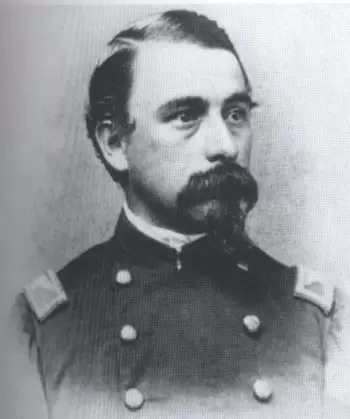
PARMELÉ (or PARMALEE), THEODORE WELD (1833-1893). Colonel, 174th New York Infantry; major, 37th Regiment, New York State National Guard, Company A. Before enlisting, Parmelé worked in the office of the Manhattan Gas Light Company. On May 29, 1862, he joined Company A of the 37th Regiment’s National Guard and served as captain and then as its major, being promoted to the latter rank on June 17 of that year. He became colonel of the 174th New York Infantry (which was part of the Metropolitan Brigade, recruited with the assistance of the New York City and Brooklyn Police Departments; however, that Brigade never served together in the field) on November 13, 1862.
On March 17, 1863, Parmelé wrote from aboard the steamer Empire Parish of the operations on the west bank of the Mississippi, “…The cause of my return without getting my cavalry to the river was the prolonged march and possible failure by extending my intervals with such poor chances of sustaining them over such roads. I have not seen the enemy in force or detachments, except skulking guerrillas. Our advance signals, after long exchanges, reported the enemy in advance of us, and the skirmishers and cavalry thought them in our rear. I do not credit the reports, but withdrew my cavalry slowly, after standing my regiments several hours. After making satisfactory observations, it being late, and my men from recent exposure being unfit, I returned. I was well supported to-day by officers and men.” After being dismissed in November 1863 for being absent without leave, the dismissal was revoked on January 5, 1864, and Parmelé was honorably discharged as disabled on account of a fall from his horse that had caused compression of his spine.
Returning to civilian life, Parmelé was a civil engineer, coal agent, and superintendent of the South Carolina State Penitentiary. His commitment to the military continued after the Civil War, with service as colonel of the 71st New York State National Guard from 1866 to 1869. He was married to the daughter of Brevet Brigadier General Charles Roome (see), and served under Roome in the 37th. According to William Swinton’s History of the Seventh Regiment (1876), Parmelé served in Company B of that unit; this service may have occurred before the Civil War. In 1889, his application for an invalid pension was granted because of his spinal injury, certificate 784,722. He last resided at 325 West 56th Street in New York City. Shortly after his death from Bright’s disease his widow, Mary P. Parmelé, received a pension in 1893, certificate 462,060. Section 60, lot 673, grave 2.
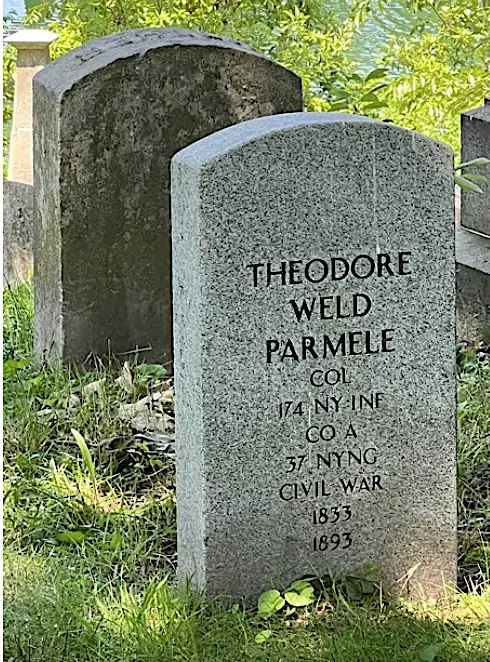
PARR, BENJAMIN (1837-1890). Private, 7th Regiment, New York State National Guard, Company D. After Parr enlisted in 1863, he served for 30 days in Company D of the 7th Regiment. Parr’s Civil War service is confirmed by his soldier history and photograph (below) at the New York State Military Museum and Veterans Research Center. His last residence was 280 St. Nicholas Avenue, New York City. His death was attributed to apoplexy. On June 16, 1891, his remains were moved to their present location. Section 192, lot 27557.
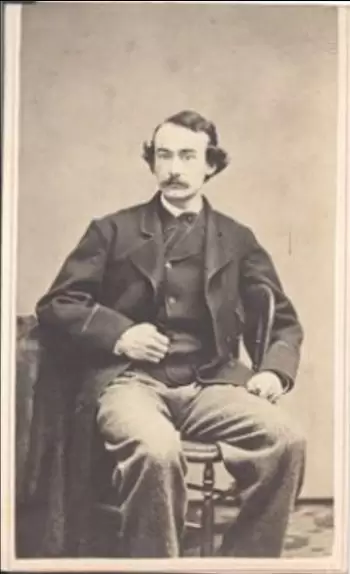
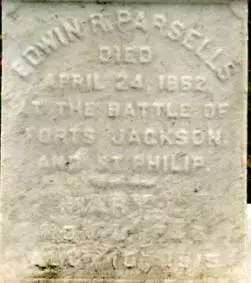
PARSELLS, EDWIN R. (?-1862). Boy, United States Navy. Parsells is not buried at Green-Wood; the monument in the family’s lot honors his memory. Parsells, who served as a boy in the Navy, was killed in battle aboard the Iroquois, a vessel in the West Gulf Blockading Squadron on April 24, 1862. At that engagement near New Orleans, Louisiana, 86 men were killed and 135 were wounded. The Iroquois arrived at its position on April 16, pressed on to capture New Orleans, and then joined Farragut to reach Baton Rouge, and take that capital city on May 8. Together with the Oneida, the Iroquois took possession of Natchez, Mississippi, on May 13, and moved on to Vicksburg, Mississippi. Remaining in the Vicksburg area, virtually unscathed, the Iroquois developed boiler trouble and was decommissioned in New York on October 6, 1862. His cenotaph is inscribed, “Edwin R. Parsells died April 24, 1862, at the Battle of Forts Jackson and St. Philip.” Section 154, lot 22095.
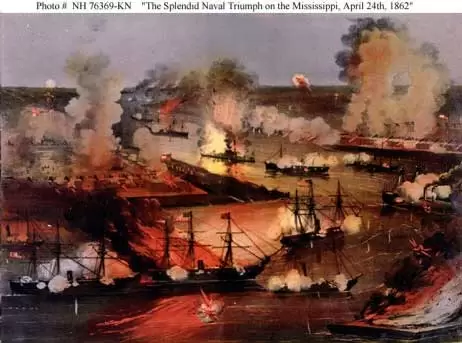
PARSHALL, WILLIAM H. (1845-1911). Private, 84th Ohio Infantry, Company G; 4th Ohio Cavalry, Company A; 79th Ohio Infantry, Company B; 73rd Ohio Infantry, Company G. A native of Lebanon, Ohio, Parshall enlisted there as a private on May 29, 1862, mustered into the 84th Ohio on June 10, and was discharged on September 20, 1862, at Camp Delaware, Ohio, at the expiration of his three month enlistment. On August 3, 1863, he re-enlisted as a private, mustered the 4th Ohio Cavalry, and was discharged on February 16, 1864. On March 28, 1864, he re-enlisted as a private and mustered into Company B of the 79th Ohio, then transferred into Company G of the 73rd Ohio on June 9, 1865, from which he was discharged on July 20, 1865, at Louisville, Kentucky.
Parshall belonged to Grand Army of the Republic’s Abe Woodyard Post #29, in Lesages, West Virginia. According to the Brooklyn Directory of 1889-1890, he was in the insurance business. After he relocated to Brooklyn, he held numerous leadership roles in the Rankin Post #10 of the G.A.R. including assistant secretary (1886), officer of the guard (1893), junior vice commander (1900) and adjutant (1908). He is listed in Brooklyn’s 1890 Veterans Census. In 1891, his application for an invalid pension was granted under certificate 832,454. According to his obituary in the Brooklyn Daily Eagle, comrades from the Rankin Post were invited to attend his funeral. He last lived at 394 Bridge Street in Brooklyn. In 1911, an application was filed for a minor’s pension, application 975,059, but no certificate number is listed. Section 136, lot 28307, grave 644.
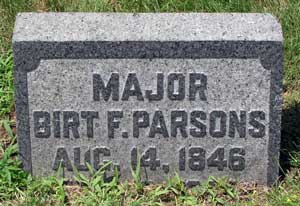
PARSONS, ADELBERT (or BIRT) F. (1846-1929). Second lieutenant, 1st Michigan Cavalry, Company I. Parsons was born in Battle Creek, Michigan. As per the 1855 New York State census, he lived in Ridgeway in Orleans County, New York, with his mother and siblings. The 1860 census notes that he lived in Brighton, Michigan, with his mother, step-father, siblings and half-sister.
During the Civil War, he was a resident of Brighton when he enlisted as a private at Detroit on December 1, 1863, and mustered into the 1st Michigan Cavalry that day. The History of Howell, Michigan, a town where Parsons later worked, notes that Parsons was underage when he enlisted and that the 1st Michigan was part of George Armstrong Custer’s brigade. Parson’s reminiscence of President Abraham Lincoln was recorded in They Saw Lincoln published in 1909 by the Lincoln Financial Foundation Collection. In his recollection, Parson noted that when he was detailed as an orderly to General Augur’s headquarters in Washington, D.C., when he was but 17 in the winter of 1863-1864, he saw Lincoln several times and attended two receptions where Lincoln was present. Parsons thought that Lincoln was the greatest man that he had ever seen, and felt, at that time, confident in the President’s statesmanship; Parsons also noted that the Emancipation Proclamation was one of Lincoln’s greatest acts.
As per a feature about him in the Brooklyn Daily Eagle after his death, Parsons was a Civil War hero who was shot in his left shoulder at the Battle of Old Church, Virginia, on May 30, 1864; that bullet remained in him throughout his life. That article notes that he was also wounded at Winchester, Shepardstown and Five Forks, all in Virginia, and that his horse was shot under him the morning General Robert E. Lee surrendered at Appomattox. Parsons rose through the ranks to first sergeant and sergeant major on July 6, 1865, and to second lieutenant four days later on July 10, mustering out on March 10, 1866, at Salt Lake City, Utah. Parsons noted in his memory of Lincoln that he returned to Michigan after his discharge where has tried “to be a fairly respectable American citizen.”
Parsons settled in Howell, Michigan, after the Civil War and was a clerk in a store there until 1871 when he invested in a business, Parsons & Beach, which sold shoes and groceries. In 1879, Parson’s application for an invalid pension was granted, certificate 174,807. At the time of the 1880 census, he lived in Howell, Michigan, with his first wife, Orra, and their sons; at that time, he was a grocer. The National Tribune (Washington, D.C.) reported on February 18, 1886, in an article about Grand Army news, that Parsons, a member of Post #120 in Michigan, was elected as a delegate to the State Encampment. The 1888 Lansing Michigan Directory lists Parsons as the vice president of the Michigan Condensed Milk Company; his residence was listed as New York City. The 1897 Brooklyn Directory lists him in the milk business on Hudson Street in New York City with a home address at 136 McDonough Street.
While living in New York, Parsons became commander of Ulysses S. Grant Post #327 of the G.A.R. An article about his installation confirms that he still carried the Springfield rifle bullet in his left shoulder and that when he was shot in the Shenandoah Valley; he rode nine miles to Harpers Ferry before having the wound dressed. As per the 1900 census, which lists an incorrect birthplace of New York, Parson lived with his wife and sons in Brooklyn and was a manufacturer of condensed milk. The 1901 Brooklyn Directory and the 1905 New York State census indicate that he was still in the milk business; he lived at 274 Hancock Street in Brooklyn. According to the 1910 census, he lived in Brooklyn with his second wife, Anna (Georgeanna), and was a manager of a milk business. By the time of the 1915 New York State census and the 1920 federal census, Parsons had retired; he still lived in Brooklyn with his second wife. Parsons was a member of the Union League Club. He last lived at 295 Macon Street in Brooklyn. His death was attributed to a cerebral hemorrhage which followed a bout of pneumonia. His death certificate notes that he was married and retired. As per his obituary in the Brooklyn Daily Eagle, comrades of the Ulysses S. Grant Post #327 were invited to attend his funeral in full uniform where Grand Army rituals were to be observed. His funeral was held at the Fairfield Chapel at 86 Lefferts Place in Brooklyn. Section 192, lot 33854.




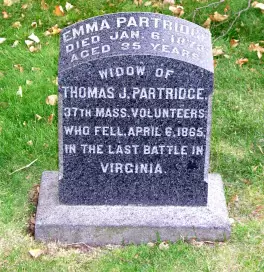
PARTRIDGE, THOMAS J. (1838-1865). First sergeant, 37th Massachusetts Infantry, Company H. Partridge is not buried at Green-Wood; the cenotaph in his family lot honors his memory. As per the Town and Vital records of Massachusetts, Partridge was born in Brooklyn, New York. In June 1855, he married Emma Cottrell in Williamsburg, Massachusetts; town records show that he was an engraver at that time. The Massachusetts State census of 1855 reports that he lived in Williamsburg with his wife and was a chaser (engraver). Partridge was the father of a daughter, Jane, born in 1856, and a son, Thomas William, who was born in 1859; the children were baptized on March 18, 1863, at the Methodist Episcopal Church in Williamsburg, Massachusetts, while Thomas Partridge was serving his country.
Partridge was a resident of Williamsburg, Massachusetts, when he enlisted as a private on August 6, 1862, and mustered into the 37th Massachusetts on August 30. As per his muster roll, he was a chaser by trade who was 5′ 8″ tall with hazel eyes, light hair and a fair complexion. He was promoted to sergeant on May 18, 1864. On September 19, 1864, he was wounded in the leg and arm at Winchester, Virginia, and was listed as absent and in the General Hospital on his September-October 1864 muster roll. Partridge was promoted to first sergeant on December 16, 1864.
In the closing days of the Civil War, Partridge was wounded in the breast at Sailor’s Creek, Virginia, on April 6, 1865, just three days before General Robert E. Lee surrendered the Army of Northern Virginia; he succumbed to that injury on April 12 at Burkesville, Virginia, one of the last casualties of the War. An article on the The Last Bloody Battle Fought by the 37th Massachusetts was written by Wayne Phaneuf. That article, based on an eyewitness report, describes the men of the 37th as having marched over 20 miles from Petersburg on the morning of April 6, feeling intense excitement as they prepared for the ensuing struggle. The Confederates were eager to protect what they could of their wagon trains as part of a desperate last stand. The cavalry, referred to as “Custer’s horsemen” and the artillery, under the command of General Philip Henry Sheridan, were waiting for the infantrymen to arrive. The 37th took a position on the left of the Brigade, the chaplain being sent to the rear when he appeared at the front of the battleground. The men of the 37th were somewhat protected by a thicket that prevented the Confederates from seeing the men despite a close distance; the rebel fire went over the heads of the Union soldiers. Using their Spencer rifles, the men of the 37th shot volleys that caused the Confederates to flee and run through the nearby forest; although the Rebels were pursued by jubilant men of the 37th, for a brief time, 200 members of the 37th were in an unsupported position. Ultimately, after a treacherous incident which at first appeared to be a surrender, the Confederates ultimately surrendered after another round of gunfire. The 37th took 300 prisoners including Generals Richard S. Ewell, Custis Lee and Joseph B. Kershaw. The article notes that although this was the 37th most noble moment, its loss was great in that nine were killed and 31 wounded; cited among the dead was Thomas Partridge. That article concluded that after two more nights in camp, when the men heard about the surrender at Appomattox, cannons were fired, men yelled themselves hoarse and tents were pitched “with the strange realization that there was no longer an opposing army to be watched and feared.”
Partridge’s hospital report states that he was buried at City Point, Virginia, in Section 1, Grave 12, Row 6; full military honors were requested for his interment. As per his final muster roll and discharge papers, he had been paid a bounty of $25, was owed the final installment of $75 of the bounty, and had received clothing valued at $52.35. His wife’s stone includes a cenotaph to him, inscribed “Thomas J. Partridge, 37th Mass. Volunteers, Who Fell April 6, 1865, In The Last Battle In Virginia.” On June 19, 1865, Emma Partridge, who is interred in the same lot as his cenotaph, applied for and received a widow’s pension, certificate 59, 269. On November 6, 1866, she applied in Haydenville, Massachusetts, for an increase in her pension; she had been receiving $8.00 per month. Emma Partridge’s obituary in the New York Herald on January 14, 1873, noted her husband’s Civil War service in the 37th Massachusetts. Section 153, lot 11545.
PARTRIDGE, WILLIAM TEW (1834-1862). Captain, 5th New York Infantry, Companies A and I. Born in Providence, Rhode Island, by 1850, he was a clerk who lived in Brooklyn with his parents and siblings. As of 1857, Partridge was a successful merchant and importer of foreign and domestic fruit with the firm of Minturn & Partridge. As per his passport application of 1859, he was 5′ 9½” tall with black eyes, dark brown hair, fair complexion, high forehead, small mouth, aquiline nose and round chin.
A resident of Yonkers, New York, Partridge enlisted at New York City on April 25, 1861, and mustered into Company A of the 5th New York as a first lieutenant on May 9. Promoted to captain on September 3, he was transferred to Company I on December 6, 1861. On June 27, 1862, he was killed at the Battle of Gaines’ Mill, Virginia. Just after he gave the order, “Skirmishers retreat,” he was shot through the heart. The men of his company immediately turned and killed the Confederate who had shot Partridge; that Confederate was hit by eight shots. Partridge’s body was taken from the field by Lieutenant McConnell and delivered to the quartermaster. Colonels Duryée and Warren later wrote in their reports of Partridge’s bravery. Alfred Davenport, in his history of the 5th, described Partridge as “brave to rashness and a strict disciplinarian. Captain Partridge had a presentiment that he would lose his life in battle, and gave directions as to the disposition to be made of his body if he should fall.” A very strong abolitionist, Partridge remarked to a gentleman in New York during the organization of the regiment, that “he could see the image of John Brown with outstretched arms ready to receive him.” His obituary in the Christian Inquirer noted:
…He early enlisted in the war; he fully understood its merits and its origin, and he gave his whole soul to duty and country. He has fallen in his beautiful youth, but it has been not in vain. It is the sacrifice of him, and such as him, that is to make a dearer, holier fatherland; a flag with its red, white, and blue kindled with new and livelier colors by the blood of the heroes who have fallen; a Union free, wholly and forever free. Peace be to his spirit, glory to his memory! Many, many years hence will the vision of that noble, manly form, and the sound of that ringing, innocent laugh, and of those words of bold and stirring truth which he uttered, come back to fill the eyes with tears, and to steel the soul against injustice and oppression.
Partridge’s obituary in The Liberator, published on July 18, 1862, spoke to his character. That obituary included the following excerpt:
“…Men who were far beyond him in years willingly confessed his superiority in soul. His character was transparent as crystal. There was no guile, no treachery, no low cunning in it. He spoke and acted his real thought with a frankness that astonished the worshippers of policy and expediency. He knew not how to wear any disguise, or stoop to any stratagem. His abhorrence of whatever is mean, base, or dishonorable was instant and spontaneous, the very instinct of his nature. He hated oppression, tyranny, slavery, and every form of injustice with an intensity that was almost divine….”
A memorial tribute poem to Partridge follows:
With solemn tread
Approach this bed
Where thousand banners wave.
Forbear to weep
O’er such a sleep,-
It well becomes the brave.
No marble raise
With storied praise,-
Leave noble deeds alone;
For Honor’s guest
Can calmly rest
Without the sculptured stone.
Above the shrine
Almost divine,
Still bow thy head in prayer,
The noblest deed,
The grandest creed,
Of man is pictured there.
Along the street,
With muffled beat,
Where thousand banners wave,-
Forbear to weep
O’er such a sleep;
It well becomes the brave.
In September of 1862, members of the fruit trade, of which Partridge was a well-respected leader, met to organize a company, to be known as the Partridge Guard, to honor his memory and support the Union cause; a news article on September 6 titled City News and Gossip noted that $1,370 was raised at that meeting. On September 19, 1862, the Brooklyn Daily Eagle reported that members of the Brooklyn Monitors organized to recruit men for the Partridge Guard, a unit named in honor of William Partridge. As per an article on Military Funerals in The New York Times on May 14, 1865, Partridge’s remains were recovered and brought home by friends for his funeral at the Chapel of the Holy Trinity in Brooklyn; he was interred at Green-Wood on May 15, 1865.
On October 13, 1865, Mary D. Partridge, his mother, who is interred with him, applied for and received a survivor’s pension, certificate 8,999. On August 17, 1863, Mary Partridge, who then lived in Boston and received $20 per month as a pension, filed papers in New York stating that her husband, George Partridge, lived apart from the family and was a drunkard dependent upon his friends for support. She also noted that her son, previous to his time in the Army, paid her bills and support and that after his death, his business partner and executor of his will, Thomas Minturn, paid her bills; William Partridge left the remainder of his estate, after all bills were paid, to his mother. William Ordway Partridge, his nephew, was a well-known sculptor. Section 9, lot 13556.
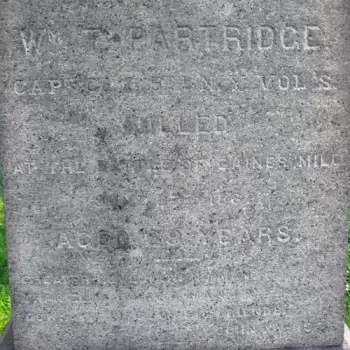

PATCHELL (or PATCHEL), THOMAS (1842-1877). Private, 40th New York Infantry, Companies E and D. Originally from New York State, Patchell enlisted as a private at Yonkers, New York, on June 14, 1861, and mustered immediately into Company E of the 40th New York. His muster roll notes that on May 25, 1863, when his company was disbanded, he was transferred to Company D. Patchell mustered out on June 26, 1864, at Petersburg, Virginia. On March 27, 1872, he married Fannie Adams in New York City. The 1876 New York City Directory lists Patchell in the wood business. As per his death certificate, he was married and worked in a lumberyard. His last residence was on 81st Street between 10th and 11th Avenues in Brooklyn. His death was attributed to phthisis.
As per the 1880 census, Fannie Patchell was living with her three young children and her mother in New York City. Her youngest child, John Patchell, was born in April 1878, six months after Thomas Patchell’s death; the Patchell’s daughter and middle child, Mary, was baptized in the Episcopal Church on July 2, 1876. In 1890, Fannie (Frances) Patchell, who is interred with him, applied for and received a widow’s pension, certificate 356,292. Section 15, lot 17263, grave 918.
PATCHEN (or PATCHIN), GEORGE (or ROBERT) L. (or N. M.) (1836-1876). Second lieutenant, 69th New York Infantry, Companies K, G, and E. Patchen was born in Brooklyn. As per the 1850 census, he lived with his widowed mother, Maria, and siblings in Brooklyn; Maria Patchen’s real estate was valued at $80,000. During the Civil War, Patchen enlisted as a private on August 12, 1862, at New York City, and mustered into Company K of the 69th New York on that date. As per his muster roll, which notes that he was also borne on the rolls as Robert M. Patchen, he was a clerk who was 5′ 9″ tall with hazel eyes, dark hair and a fair complexion. On October 8, 1862, he was promoted to sergeant, and mustered out on June 12, 1863. He returned to service when he re-enlisted on December 15, 1863, mustered into Company G of the same regiment, and was reduced to ranks (private) on that day. Promoted to sergeant on March 9, 1864, he rose to first sergeant on about June 15, 1864, and to second lieutenant on September 1 of that year effective upon his transfer to Company E. Taken as a prisoner of war on October 30, 1864, near Petersburg, Virginia, while on picket duty and with other members of the 69th New York, Patchen was paroled on February 21, 1865, at James River, Virginia, and hospitalized the next day at Annapolis, Maryland.
He may have been the George Patchen who enlisted at Brooklyn on October 29, 1866, and served in the United States Army for three years in Company K of the 32nd Infantry and Company D of the 21st Infantry; that George Patchen was discharged as a sergeant at Camp Crittenden, Arizona, on October 29, 1869. The Brooklyn Directories for 1874 and 1875 list him as a broker whose home address was 230 Clinton Street in Brooklyn. The 1876 Brooklyn Directory lists him as a broker who lived at 387 Bergen Street in Brooklyn. As per his obituary in the New York Tribune, he was a member of the New York Stock Exchange; resolutions of condolence were offered by that organization. His obituary in the Brooklyn Daily Eagle noted that his funeral was held at the Church of St. Charles Borromeo at Sidney Place and Livingston Street in Brooklyn. Samuel Patchen (see) and Joseph Patchen (see) were his brothers. He died in Babylon, Long Island. An article in the Albany Morning Express on May 6, 1890, noted that his minor children, Mary Patchen et. al., sued George’s brother, Edward Patchen, over an issue in the will of Henry Patchen, George Patchen’s father. Section 3, lot 566.

PATCHEN, JOSEPH A. (1843-1876). Unknown soldier history. Joseph was born into a well-known Brooklyn family that owned a large area of land known as the Patchen farm. His obituary notes that the Patchens were among the early settlers of Brooklyn and that Joseph Patchen had inherited considerable wealth. As per the census of 1850, he lived in Brooklyn with his widowed mother and siblings; Maria Patchen’s real estate was valued at $80,000. Joseph was the youngest of three brothers who played for the Brooklyn Stars, a baseball club, in 1859. Joseph, or Joe, was the right fielder, Edward was the third baseman and Sam (see) was the shortstop; he was also the brother of George Patchen (see). In 1859 and 1860, he was listed in the Senior Collegiate Department of the Brooklyn Collegiate and Polytechnic Institute. After some turmoil with the Stars’ management, Joseph joined the Charter Oak Baseball Club in 1860.
According to a biographical sketch pertaining to his baseball career, Patchen served during the Civil War; there are no soldier records on which his name appears. As per his passport application of 1869, he was 6′ 1¾” tall with gray eyes, blond hair, light complexion, very large nose, high forehead, round chin, and “sharp” face. In civilian life, he was a Wall Street broker and a volunteer fireman with Pacific Engine Company 14 on Pierrepont Street. He served with the volunteer firefighters until a paid fire department was introduced. As per his obituary, he was a “staunch Democrat as the male members of his family have ever been.”
As per his obituary in the Brooklyn Union, he was a man of considerable wealth who died at 230 Clinton Street in Brooklyn, where he lived with his mother; it was the home where he was born. His obituary noted that he was a man of great promise, single, and with a wide circle of friends. A newspaper article about his death notes that he was ill the month before his death but no doctor was summoned until his last hours when he suffered severe pains and delirium; the doctor arrived too late and an inquest into his death was ordered. As per his death certificate, which listed him as a stockbroker, and the news article, Patchen’s death was attributed to heart disease. His funeral took place at the Church of St. Charles Borromeo at Sidney Place and Livingston Street in Brooklyn. Section 3, lot 566.
PATCHEN, SAMUEL (1841-1885). Private, 13th Regiment, New York State Militia, Company G. A Brooklynite by birth, he was part of a renowned Brooklyn family that owned the Patchen farm. The 1850 census notes that he lived with his widowed mother, Maria, and his siblings. He was educated in the public schools and was a graduate of the Polytechnic Institute. A baseball player in his youth, he played with the Excelsiors and was the shortstop for the Stars. Patchen served as the Star Club director in 1858 and the club’s secretary in 1859, the same year that his brothers Edward and Joseph (see) played alongside him; his other brother, George (see), was not on the team. Henry Chadwick, “the father of baseball,” reported that Sam was “regarded as the best shortstop outside of the Atlantic Club” during those years. He joined the Charter Oaks Club in 1860 but left after one season.
During the Civil War, Patchen served in Maryland as private with the 13th Regiment when it was activated for three months in 1861. As per his passport application, issued on May 21, 1863, he was 6′ tall, with blue eyes, light brown hair, florid complexion, large face, Grecian nose, high forehead and ordinary mouth. In civilian life, he and his brother Edward ran the Patchen Brothers stock brokerage firm at 50 New Street in Manhattan. As per an article on his death in The New York Times, he was a member of the Stock Exchange for over twenty years and members of the Exchange said of him, “Sam Patchen’s note was worth twice as much as he said it was.” That obituary noted that the Patchen brothers had previously owned property in the Sleepy Hollow region of New York and were “heavy holders” of Brooklyn real estate. As per resolutions of condolence for Patchen family, members of the Stock Exchange noted: “During Mr. Patchen’s connection with this organization, he has always taken a deep interest in all matters pertaining to its government and the welfare of its members. He was decided in his opinions and fearless in expressing them, with a generous disposition and a readiness to extend aid where it was needed. As a business man of undoubted integrity, [he was] earnest in his convictions and prompt in his dealings.” In addition, he was a member of the Brooklyn Volunteer Fire Company for several years.
Retaining his interest in baseball, Patchen was an attendant at local games until his untimely death when he fell down a flight of stairs at the Brooklyn Club House, a club he joined in its early days and whose members thought warmly of him. As per an article about his death in the Brooklyn Daily Eagle on December 11, 1885, which confirms his Civil War service, Patchen was at the club house to propose a friend for membership. He went to a “retiring room” in the basement and then either opened the door to the sub-basement by mistake or leaned against the door when the bolt gave way. Patchen tumbled head first down the stairs, striking his head against the cement and died almost instantly. The article about his death notes that he was a big man who was tall, broad-shouldered and weighed over 200 pounds. According to another article about his death in The New York Times, washroom attendants cried for help and gentlemen from the parlor came down and lifted his body onto a bed and summoned doctors. Doctors reported that his death occurred from dislocation of the neck and fracture of the skull. Both news articles report that his wife was brought by carriage to the Brooklyn Club and a messenger was sent to the Brooklyn Academy of Music to summon his brother Edward who was attending an opera there. The New York Times article about his death noted that he died before the doctors or his relatives arrived; an autopsy was performed before the burial certificate was issued. He last lived at 232 Clinton Street in Brooklyn, a house adjacent to the house where he was born. An 1880s Stock Exchange Archive, including papers from the Patchen brothers, has been offered at auction sites. Section 3, lot 566.
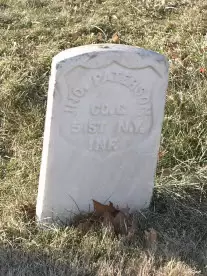
PATERSON (or PATTERSON), JOHN (1833-1875). Private, 51st New York Infantry, Company G; 2nd Battalion, Veteran Reserve Corps, 79th Company. Paterson was born in New York. After enlisting at Brooklyn on September 15, 1861, and mustering in on September 30, he served with the 51st New York until he was transferred into the 79th Company of the Veteran Reserve Corps on September 30, 1863. The 79th Company of the 2nd Battalion of the Veteran Reserve Corps was organized on that date at Camp Joe Holt, Indiana, had its designation changed on April 25, 1864, and mustered out by detachments from August 22 through September 30, 1865.
The 1870 census reports that Patterson lived in Brooklyn with his wife and two young children, worked as a plumber and had a personal estate worth $4,000. He is listed as a plumber in the Brooklyn Directory of 1875, the year of his death. His obituary in the Brooklyn Daily Eagle notes that he was a Freemason and belonged to the Rankin Post #10 of the G.A.R.; members of those organizations and comrades from the 51st New York were invited to attend his funeral. As per his burial certificate, he was married and was a plumber. He last lived at 99 Carleton Avenue in Brooklyn. His death was attributed to paralysis. On February 25, 1875, Catherine Paterson appeared in Kings County Surrogate’s Court and attested that her husband, who died without a will, had a personal estate of $2,000; she noted that she had three children, the youngest only one year old. A government-issued gravestone, dating from a contract signed on November 29, 1879, marks his grave. In 1890, Catherine Paterson applied for and received a widow’s pension, certificate 335,189. Section 84, lot 6139.

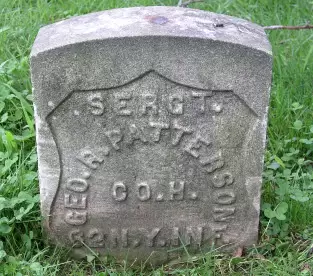
PATTERSON, GEORGE R. (1837 or 1844-1909). Sergeant, 62nd New York Infantry, Company H. Patterson was born in Manchester, England. His birth year and year of his family’s arrival in the United States are unclear. The census of 1900 reports that he was born in April 1844 and immigrated to the United States in 1854; the 1905 census gives a birth date of April 1837 and states that he lived in the country 58 years, suggesting that he arrived in the United States in 1847. His family subsequently settled in Jersey City, New Jersey. During the Civil War, Patterson enlisted as a private and mustered into the 62nd New York, known familiarly as Anderson’s Zouaves, on June 10, 1861, at New York City. He was promoted to corporal on November 2, 1862, and to sergeant on or about May 15, 1863. Patterson was discharged at Grant Camp on June 30, 1864, at Alexandria, Virginia.
The 1890 Veterans Census confirms Patterson’s Civil War service. In 1891, Patterson applied for and received an invalid pension, certificate 784,700. He was elected Street and Water Commissioner in Jersey City as a Republican in 1895 and served for one year. An article in the Jersey Journal on April 15, 1896, encouraged a vote for Patterson as a vote for a veteran who fought for the flag and who would fight for labor; the nature of that election was not stated. An article in the Jersey Journal on July 29, 1899, noted that Patterson had just been appointed warden of the County Jail and notes his lifetime achievements. Active in politics, he was a Republican County Committeeman for many years and a member of the Tenth Ward Republican Association. Patterson was a member of the Zabriskie Post #38 of the G.A.R. in Jersey City where he held the positions of inspector general and judge advocate. He was the deputy district grand chancellor of the Knights of Pythias in 1899. That aforementioned article and his obituary incorrectly note that and had been brevetted to major; his obituary incorrectly indicates that he served with a New Jersey regiment during the Civil War.
The census of 1900 indicates that he lived with his wife and children in Jersey City and was a confections salesman. An article in the Jersey Journal on December 3, 1902, noted that Patterson, in his post as county inspector of the G.A.R., was visiting various posts, including two in Bayonne, and making official inspections. The 1905 census indicates that he lived in the United States for 58 years, was a naturalized citizen and worked as a confectioner. The Jersey City Directory for the year of his death lists him as a confectioner. He last lived at 80 Cottage Street in Jersey City, New Jersey. His death was attributed to Bright’s disease. Shortly after his death, Elizabeth Patterson applied for and received a widow’s pension, certificate 691,500. Section 186, lot 18854.
PATTERSON, JAMES (1840-1904). Private, 5th New York Infantry, Company G. A native of County Antrim, Ireland, his muster roll and the 1880 census incorrectly note that he was born in New York. Patterson stood 5′ 7¼” tall with blue eyes, light hair and light complexion. A carriage trimmer by trade, he enlisted at New York City on April 25, 1861, and mustered into the 5th New York on May 9. After being shot in the shoulder and neck at Second Bull Run, Virginia, on August 30, 1862, he was hospitalized at Mansion House General Hospital in Alexandria, Virginia, the next day. Although Patterson’s muster roll notes that he was hospitalized on September 3 when he was returned from missing in action at a camp near Hall’s Hill, Virginia, he is listed in an article in The New York Times on September 1, 1862, as being among the wounded who were taken to the hospital at Alexandria, Virginia.
Patterson was named in two anecdotes about Second Bull Run, a bloody battle that decimated the regiment. According to Brian C. Pohanka’s Destruction of the 5th New York Zouaves; Battle of Second Manassas (another name for Second Bull Run), Irish-born veteran Patterson stood alongside two young recruits, one of whom, James Cathie (see) called out to him “Look out for Sis_” just before he was fatally shot. The other new recruit fired his first and only shot before he was killed. Another anecdote recounts the bloody battle between the 5th New York, a Zouave unit that faced the 5th Texas Infantry during the Battle of Second Manassas in which the 5th New York lost 123 men in five minutes, the greatest loss of life in any single infantry regiment during the Civil War. In that recollection, a Confederate approached the wounded Patterson to take whatever he had saying, “You won’t live anyhow.” Refusing to fill Patterson’s canteen and waving the $2 that he took from the wounded Union soldier, the Rebel said, “We are going to Washington and I will not fail to drink your health when I get there!” Patterson was discharged for disability at the General Hospital at Alexandria on November 10, 1862.
On October 19, 1863, Patterson applied for and was granted an invalid pension, certificate 2,201. He became a naturalized citizen on September 14, 1868; at that time, he worked as a carriage trimmer. As per the census of 1870, he was married, lived in Manhattan and worked as a carriage trimmer. The 1880 census incorrectly lists his birthplace as New York but notes that he still worked as a carriage trimmer and lived in Manhattan with his wife and daughter. The 1882 New York City Directory lists him as a trimmer. Patterson was a member of the 5th Veterans Association. As per his death certificate, he died in Manhattan. His death was attributed to cirrhosis. Catherine Patterson applied for and was granted a widow’s pension in 1904, certificate 580,875. Section 128, lot 31394, grave 638.
PATTERSON, JOHN H. (1842-1894). Seaman, United States Navy. Patterson was born in Germany. His naturalization papers report that he immigrated to the United States and arrived in New York City on or about October 15, 1860. During the Civil War, Patterson was a seaman aboard the USS St. Lawrence, USS Magnolia, and USS North Carolina. The Veterans Census of 1890, which confirms his Civil War service, notes that he served from November 1861 through May 1863.
According to records of the United Methodist Church, Patterson married Emma Graves in Manhattan on May 3, 1877; his marriage record indicates that he was a steward on a ship. The 1880 census shows that he lived at 441 First Avenue in New York City, was married with young children and was still employed as a ship steward. Patterson became a naturalized citizen on October 23, 1880. The New York City Directory of 1883 lists him as a steward; he then lived at 313 East 23rd Street. Patterson’s application for a Navy pension was approved in 1889, certificate 9,565. When the Veterans Census was taken in 1890 and at the time of the 1892 New York State Census, he lived in Oyster Bay, Long Island; the 1892 census notes that he was a hack driver. He last lived in Glen Cove, Long Island. His death was caused by Bright’s disease. Emma Patterson, who is interred with him, applied for and received a widow’s pension in 1894, certificate 10,872. Section 135, lot 27263, grave 2564.
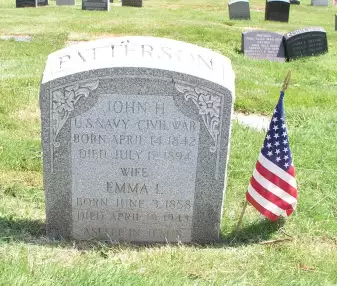
PAULSACKEL (or PAULSACHEL), CARL FREDERICK (1835-1910). Captain, 46th New York Infantry, Companies A and G. German-born Paulsackel immigrated to the United States from Rotterdam, The Netherlands, aboard the South Carolina, and arrived in New York City on September 24, 1852; the 1900 census gives an incorrect immigration year of 1850. During the Civil War, he enlisted at New York City on July 29, 1861, and entered Company A of the 46th New York that day as a first lieutenant but did not muster in at that rank. Upon his promotion to captain on September 3, 1861, he was transferred to Company G. On October 29, 1861, his petition for naturalization, noting his service as a Union Volunteer, was submitted to the Court of Common Pleas in New York City. As per Special Order No. 339 from the Adjutant General’s Office of the War Department, he was dismissed on November 11, 1862, with loss of pay and any allowances due. On October 27, 1865, his naturalization was approved; he then lived at 15 Eldridge Street in New York City.
The New York City Directories for 1876-1878 and 1880 indicate that Paulsackel worked in a billiard saloon. According to the 1880 census, he was married, lived in Manhattan and was a wood carver; the 1884 New York City Directory also lists him as a carver who lived on Eldridge Street. The Veterans Census of 1890 confirms Paulsackel’s Civil War service. The 1897 New York City Directory notes that he was a carver who lived at 212 East 115th Street in Manhattan. The 1900 census reports that he lived at 52 Franklin Avenue in Brooklyn and was a wood carver. In 1900, he applied for and was granted an invalid pension, certificate 1,097,482. The New York State census of 1905 shows that he was still working as a wood carver; he was not working at the time of the 1910 census. As per his obituary in the Brooklyn Standard Union, he had been a Brooklyn resident for fifty years and last lived at 1905 Pacific Street; however, the claim that he was a 50 year resident of Brooklyn is contradicted by census data and other documents that show that he lived in New York City (Manhattan) from after the Civil War until about 1900. Babette (Babetta) Paulsackel, who is interred with him, applied for and received a widow’s pension in 1910, certificate 730,413. Section 137, lot 28874.
PAULSON (or POULSON, POWLSIN), ANDREW J. (or I.) (1846-1891). Private, 8th Delaware Infantry, Company B; drummer, 3rd Delaware Infantry, Company I. A native of Delaware, Paulson served as a drummer for 30 days with the 3rd Delaware Regiment and then served for 30 days as a private with the 8th Delaware. He also served in the 140th New York Infantry. In 1889, he successfully applied for an invalid pension, certificate 310,664. He was a member of the Grand Army of the Republic’s Edwin D. Morgan Post#307 as of December 14, 1888. His last address was in Brentwood, New York. His widow received a pension under certificate 400,881. Section 206, lot 21347, grave 358.
PAVIE, CHARLES A. (1839-1882). Private, 71st Regiment, New York State Militia, Company E. Born in New York, he enlisted in 1861 for a period of three months and served with the 71st Regiment. In 1875, he applied for a pension, application 201,285. In 1886, Jeannette L. Pavie, his mother, applied for a pension as guardian of his minor daughter Jeanette L., application 344,882. In 1889, she re-applied for a pension for the daughter, application 397,715. There is no record that either application was granted. Pavie died of phthisis in Albany, New York, but last resided at 91 Avenue D, Manhattan. Section 103, lot 4658.
PAYNE, WILLIAM ROBERT (enlisted as MOONEY, JOHN D.) (1841-1917). Corporal, 15th New York Engineers, Company C. Born in Canada, he enlisted at Brooklyn as a private under the name of John D. Mooney on April 23, 1864, and mustered that same day into the 15th New York Engineers. He served the remainder of the War, was promoted to artificer on an unknown date and to corporal on December 25, 1864. Payne mustered out on June 13, 1865, at Fort Barry, Virginia. His last residence was at 39 Eppirt Street in East Orange, New Jersey. His widow applied for a pension soon after his death from intestinal cancer, application 1,104,576, but there is no certificate number. Section 54, lot 7390.
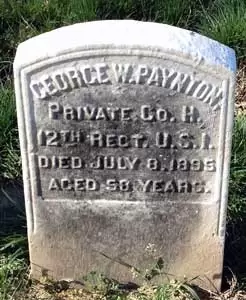
PAYNTON (or RYNTON, PYNTON, POYNTIN), GEORGE W. (1837-1895). Private, 12th United States Infantry, Company H; 84th New York (14th Brooklyn) Infantry, Company A. After enlisting as a private at Brooklyn on August 20, 1862, to serve three years, Paynton mustered into the 14th Brooklyn the next day. He was discharged for disability on December 24, 1862. He also served in the 12th United States Army, as per soldier and pension records, but the details of that service are unknown. In 1870, he applied for and received an invalid pension under certificate 132,717. The inscription on his tombstone confirms his service in the 12th Infantry. Shortly after his death, caused by a fractured skull in 1895, Ella Paynton received a widow’s pension, certificate 414,955. George L. Weed, guardian, applied for and was granted a pension for a minor in 1900, certificate 507,062. Section 2, lot 5499.
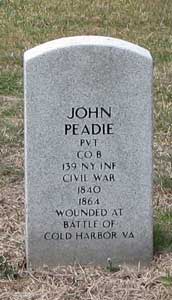
PEADIE (or PEDDIE), JOHN (1840-1864). Private, 139th New York Infantry, Company B. Originally from Scotland, Peadie enlisted as a private at Brooklyn on August 23, 1862, and mustered into the 139th New York Infantry on September 9. He was borne on the rolls and in his soldier records as John Peddie. On June 3, 1864, he was severely wounded in the left leg at the Battle of Cold Harbor, Virginia. On June 23, 1864, the Brooklyn Daily Eagle listed him, as John Peddie, among those killed and wounded in the 139th Regiment. After his leg was amputated, Peadie succumbed to his wounds on August 18, 1864, at Harewood Hospital in Washington, D.C. His name was also recorded in Burial Registers, Military Posts and National Cemeteries, 1862-1960. Section 117, lot 10975, grave 970.
PEARCE, EDWARD EASTMAN (1823-1879). First lieutenant, 84th New York (14th Brooklyn) Infantry, Company B. Although Pearce’s muster roll notes that he was born in London, England, and his baptism certificate from Tower Hamlets (Middlesex County) and the 1860 census confirm this, his Draft Registration of July 1863 incorrectly states that he was born in Ireland. He immigrated to the United States aboard the Florida from London, England, and arrived in New York City on April 20, 1832. On October 31, 1846, he became a naturalized citizen. The 1860 census notes that he lived in Islip, New York, and was a shoemaker; at that time, his real estate was valued at $1,000 and his personal estate at $30.00.
During the Civil War, Pearce enlisted as a second lieutenant at New York City on April 18, 1861, and was commissioned into the 14th Brooklyn on May 23. He was promoted to first lieutenant on August 29, 1862, and mustered out at New York City on June 6, 1864. As per his obituary in the Brooklyn Daily Eagle, Pearce was one of the original organizers of his command, participated in many severe battles and fought with “distinguished bravery.” The New York State census of 1875 reports that Pearce lived in Brooklyn. His obituary notes that he was a member of the 14th Veteran Association and had lived in Brooklyn for fifty years. As per his death certificate, which incorrectly indicates his place of birth as New York City, he was married and lived in Brooklyn. He last lived at 719 Lafayette Avenue. His death was caused by strangulation of the bowels. Section 126/127, lot 5047, grave 138.
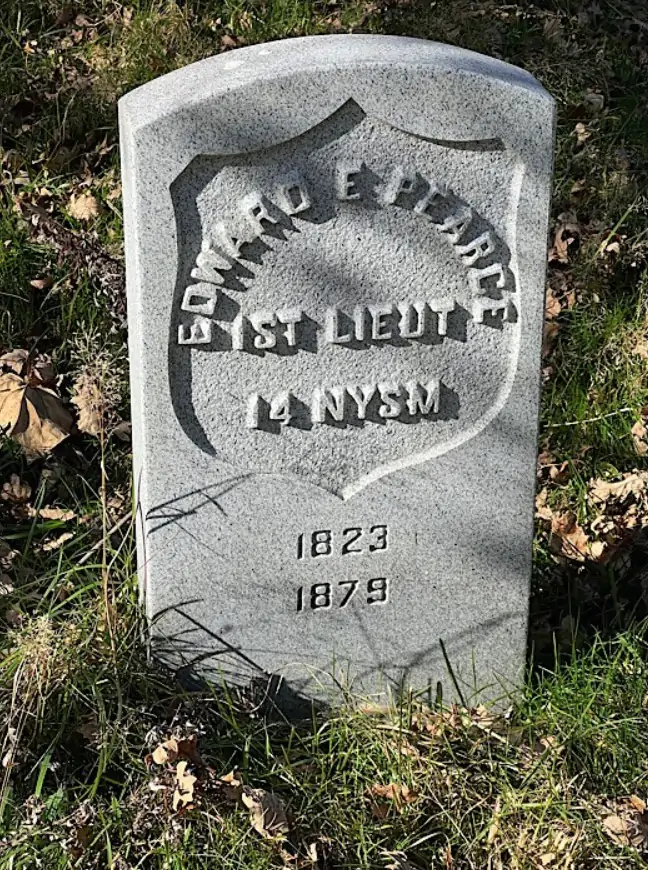
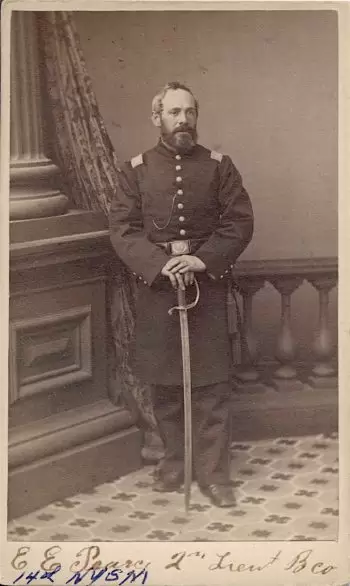
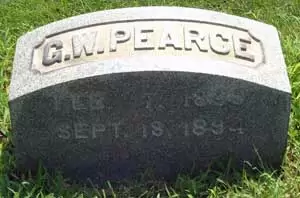
PEARCE, GEORGE W. (1839-1894). As per Pearce’s obituaries in the New York Sun and the The New York Times, he was born in England and came to the United States with his family when he was a young boy. The passenger manifest for the Robert Isaac lists September 23, 1844, as the date the Pearce family arrived in New York City. The Sun indicates that the family lived in Michigan and that George Pearce came to New York City when he was eighteen to take a job as a reporter with the New York Tribune.
After enlisting as a private on April 26, 1861, at New York City, Pearce mustered into the 10th New York four days later. He was discharged for disability on May 29, 1861, at Sandy Hook, New Jersey. Subsequently, he re-enlisted at New York City as a private on May 28, 1862, mustered into the 22nd National Guard that day, served three months, and mustered out on September 5 at New York City. In 1863, when his regiment was reactivated, he served for 30 days with the same company.
In civilian life, Pearce was a journalist. The New York City Directory for 1870 lists him as a reporter while the 1879 New York City Directory lists him as an editor. One of his jobs was as the head of the New York Tribune’s news bureau at Police Headquarters. He was then an assistant city editor for the night edition of that newspaper. As per the 1880 census, he lived with his wife and son at his mother-in-law’s house at 256 West 21st Street. On December 2, 1882, The New York Times reported that Pearce was elected a vice president of the Press Club. He became a naturalized citizen on October 24, 1884; he listed himself as a journalist on that document. Pearce was identified as a reporter in the 1888 New York Directory. When he retired from the Tribune in 1888, he was editor and proprietor of the New York Law Journal at Broadway and Duane Streets, a successful enterprise where he was held in high esteem by lawyers and judges. When he took that position, the Evening World noted on April 26, 1888, that he was feted with a banquet at Morello’s by newspaper boys who were detailed to City Hall. His obituary in Law Book News notes that although Pearce was not a lawyer, his experience as a journalist and his personal characteristics made the Law Journal a valuable publication.
An article in the New York Tribune on April 14, 1894, noted that Pearce had an operation for mouth cancer at the New York Cancer Hospital at 106th Street and Central Park West. As per his death certificate, which incorrectly states that he was born in New York City, he was married and worked as a journalist. Pearce’s obituaries in the Sun and The New York Times confirm his Civil War service. He last lived at 185 West 79th Street in Manhattan. An article on his funeral was featured on September 21, 1894, in the New York Tribune. The many guests, who overflowed his apartment, included congregants from the Church of the Divine Paternity, of which he was a member, a committee appointed by the Press Club, and many other newspapermen. His coffin was adorned by many floral tributes. A eulogy by the pastor of his church praised his patriotism, journalistic career and heroism in the face of suffering before his death. He bequeathed all of his possessions to his wife, Lilie (or Lillie) Pearce, who is interred with him. Section 53, lot 5413, grave 13.
PEARCE, PIERRE LaPAGE (1830-1890). Civil War personality and slave trader. Originally from the West Indies, according to Green-Wood, the Masonic history states that Pearce was born in New Orleans, Louisiana, and was educated at St. Charles’ College and Kemper’s College in Missouri. A clerk in the ship chandlery and grocery business, he moved to New York City in 1847 where he joined the Freemason’s Star of Bethlehem Lodge in 1854 and started a shipping and commission business that same year. He purchased the sailing ship Wildfire, a bark originally built for the California Gold Rush in 1859. In 1860, the Wildfire was off the coast of West Africa bringing 615 slaves on board to be delivered to Florida and Cuba for its sugar plantations. The ship was being tracked by a British anti-slavery patrol on its journey to Key West, Florida. When the vessel reached that port, the United States Navy steamer Mohawk boarded her on April 26, 1860, and the crew was placed under arrest by United States marshals. When the ship docked, only 507 Africans survived the trip. Many were suffering from disease brought on by the conditions of the journey and were quartered in a hospital built for them. (Burial grounds at Higgs Beach and remains of the Africans were later discovered; survivors were taken to Liberia.) The crew and its captain, Phillip Stanhope, were freed by a grand jury in Key West County that year.
In 1860-1861, no other crew that was brought into Key West was ever tried for slave trading. In the four months before the outbreak of the Civil War, the United States Navy stopped all slave trading ships and removed a total of 1,400 slaves in Key West. The Wildfire was condemned and sold by the United States Marshal Service on June 7, 1860, at public auction for $6,454.38. The United States Treasury and the crew of the USS Mohawk divided a prize of $6,087.76. He is listed as a chandler in the New York City Directories from 1875 through 1878 and as a merchant at 155 Maiden Lane in Manhattan in the 1880-1882 Brooklyn Directory. Pearce was called the “Father of the Greenwood Lodge” according to the History of the Third Masonic District of Brooklyn 1730-1888 (edited by Henry Whittemore) and became its first master. Section 158, lot 11516.
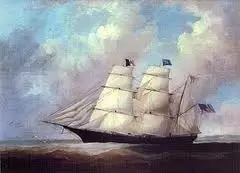
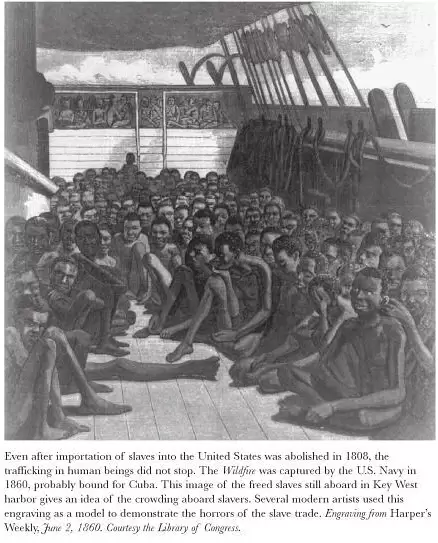
PEARSALL, CHARLES E. (or H.) (1836-1896). Private, 71st Regiment, New York State Militia, Company H. Pearsall was born in New York City. As per the censuses of 1850 and 1860, he lived in New York City with his parents and siblings; his father was a fruit merchant who had a personal estate of $10,000 in 1860. Also known as C. E. Pearsall, he enlisted on April 19, 1861, and mustered into the 71st Regiment, serving from May 3 to July 31, 1861. His obituary in the New York Tribune notes that he was a great admirer of Abraham S. Vosburgh (see), the colonel of the regiment who was one of the first casualties of the Civil War. (Vosburgh died from consumption on May 20, 1861.) The 71st saw action in Virginia at Aquia Creek on May 31 and June 1; at Matthias Point on June 27, and was at the First Battle of Bull Run on July 21, following the advance on Manassas.
The 1870 census notes that Pearsall lived with his wife’s wealthy parents in New York City and was a fruit dealer. As per an entry on daytoninmanhattan.blogspot on April 9 2016, Pearsall hired a well-known builder to construct a two-story stable, designed like a carriage house, at 30 Jane Street in Manhattan for rental purposes. (The building still stands as a commercial property.) At the time of the 1880 census, he lived on West 34th Street in New York City with his wife and was a boarder; he still worked as a fruit dealer. Pearsall was quoted in an article in the New York Herald on February 1, 1883, about the letting of stands in the new Fulton Market building. Pearsall told the Aldermanic Committee investigating the prices charged for space at that facility that restaurant keepers were discriminated against. As per the blogspot entry, Pearsall complained to the Committee of Markets on February 15, 1883, that “he was a standholder in the old market and had a permit for a stand in the new structure, but he had been told by the chief clerk of the market that he would not be given a stand.” Apparently graft was involved the allotment of stands; eventually, the problems were ironed out and Pearsall was operating at 19 Fulton Street. The 1887 and 1890 New York City Directories list him in the fruit and produce business; he then lived at 358 Tompkins Avenue in Brooklyn. Pearsall’s wife, Caroline Meleo Pearsall, who is interred with him, died in 1891. In 1891, he applied for and received an invalid pension, certificate 786,297; the date of death on his pension index card is incorrect—he died on November 16, 1896.
The blogspot post notes that on April 20, 1895, he sent an employee to bring a package containing a sword and Eskimo and Asian artifacts to a customer; along the way, the messenger, who got drunk, put on the Eskimo outfit and was arrested and jailed. Once the messenger was sober, Pearsall was contacted about the ownership of the aforementioned items. On January 11, 1896, an article in the New York Press noted that Pearsall was installed as vice president of the Vosburgh Veterans; that same article reported that he was complimented for the manner in which he conducted business of that organization. Pearsall was also a Freemason. As per his obituary in the Sun, he had been in the fruit business at 18 Fulton Street until 1895, when he retired “with a comfortable fortune.” He last resided at 419 Hancock Street in Brooklyn. His death was attributed to apoplexy.
An article in the New York Tribune, “Grand Army Bugle Notes, “ on November 23, 1896, reported on the death of Pearsall, who had been a popular vice-president of the Vosburgh Veterans of the American Guard, an organization of the 71st Regiment and one that he helped organize. That article noted that members of the Vosburgh veterans attended his funeral as a group and wore badges of mourning. On June 13, 1897, the New York Press reported that the Vosburgh Veterans decorated Vosburgh’s grave and held a service there on Memorial Day; the organization, led by Henry Patchen Martin (see), who succeeded Vosburgh as colonel of the 71st Regiment and who was presented a badge at the ceremony, then decorated Pearsall’s grave and other comrades including Stephen Egbert (see). Section 33, lot 4798.
PEARSE, ALANSON (or ALASON) SCUDDER (1845-1898). Private, 37th Regiment, New York State National Guard, Company K. Pearse, who was born in New York State, lived in New York City with his family in 1860; the census notes that his father, Augustus, was a “master painter” whose real estate was valued at $50,000 and whose personal property was worth $10,000. Augustus Pearse, who is buried in the same lot as his son, did house painting for the Astors, Vanderbilts and other famous New York families. During the Civil War, Alanson Pearse enlisted in 1863 and served for 30 days with the 37th Regiment as a private.
On May 15, 1866, Pearse enlisted as a private in the United States Marines, and after being stationed in Brooklyn, was assigned to the USS Memphis from November 1866 through April 1867. (The USS Memphis, a Confederate ship until its capture in July 1862, was decommissioned in May 1867.) Pearse was then stationed at Boston before his assignment to the USS Franklin, a screw frigate, from August 1867 through September 1868.
Pearse is listed as a clerk in the Jersey City Directory of 1873. The New York Sun announced his first marriage to Adelia Younge on April 6, 1876. The 1880 census notes that he lived with his wife and child in Jersey City and worked as a clerk in a railroad office. The Jersey City Directory for 1889-1890 lists him as a clerk whose home address was 317 York Street; his first wife, who is interred with him, died in 1889.
According to the 1890 Veterans Census, Pearse lived in Jersey City and was employed as a clerk; he noted that he did not know his enlistment dates. The Brooklyn Daily Eagle announced his marriage to Saidie Earley on March 6, 1895. The Brooklyn Directory for 1898 lists him as living at 560 Greene Avenue. His death certificate, which lists his name as Alason Pearse, notes that he was married; no occupation is indicated. His last residence was 560 Greene Avenue in Brooklyn; his death was attributed to pulmonary edema. His obituary in the Masonic Standard noted that he died suddenly and that the Masonic funeral rites were performed at his gravesite. As per his will, filed in Kings County (Brooklyn) on January 9, 1899, he left his personal property, valued at about $600, to his second wife, Saidie. Section 90, lot 872, graves 10-15.
PEARSON, CHARLES WILLIAM (1848-1928). Telegrapher, United States Volunteers, Quartermaster’s Department. A native of New York City, Pearson enlisted on December 14, 1863, and served as a telegrapher in the Quartermaster’s Department. William R. Plum, in The Military Telegraph During The Civil War In The United States (1882), noted that Pearson was at General A. J. Smith’s headquarters on an unstated date in 1864 when he was startled by the sound of firing. He looked outside the window and mistook the force of cavalry that he saw for Union troops. Upon word from the judge advocate that rebels were in the area, Pearson jumped off the stoop, which was 18 feet high, landed in the midst of Confederates and was taken prisoner by forces under the command of Confederate General Nathan Bedford Forrest. Forrest’s men were sorely outnumbered by the 5,000 Union troops in Memphis and despite Forrest losing 200 of his own men in the attack, he proceeded to march the 300 prisoners he had captured, including Pearson, to Tupelo, Mississippi, a distance of 75 miles. Pearson asked to be paroled, but after he evaded Forrest’s questions, he joined the prisoners on their trek. The prisoners walked two days in the rain, slept in the mud and then boarded freight cars. Plum notes that Pearson was without any clothes except for an undershirt and his pants which were soon seized by a Confederate and exchanged for pantaloons “big enough for Barnum’s giant.” When a fellow prisoner pleaded that Pearson be allowed to keep his own pants, which was all he had that was blue, the rebel replied, “Can’t do it, his belly is blue, that will answer.”
Plum went on to recount Pearson’s experiences in prison camp. Plum notes that in the prison yard there was an area where cooking took place. One area, a circle delineated by sticks, was forbidden territory. One morning, when Pearson was in the yard, he heard someone call his name, and when he turned around, accidentally stepped into the forbidden territory. A guard fired a shot which unfortunately struck another young prisoner who died 20 minutes later; Pearson stood watch over the mortally wounded boy to keep the flies away. Plum also reported that Pearson was punished for a disobedience and was forced to walk on burning sand that incurred blisters to his feet. Plum notes that the prisoners were in Grenada, Canton and Jackson, Mississippi, and then in Duvall’s Bluff, Selma and Cahaba, Alabama. At Cahaba, Plum notes that Pearson, thinking that he would not be exchanged as a telegraph operator, falsely reported himself as a member of Company M of the 2nd Illinois Cavalry, and was finally exchanged on an unstated date. By the time Pearson returned to his position at headquarters, he had lost 30 pounds and was not recognized by those on staff. He was discharged on November 14, 1865.
The 1894 New York City Directory lists Pearson as an operator who lived at 443 West 57th Street in New York City. The 1900 census reports that he lived in New York City with his wife and children and worked as a clerk. The Evening Star reported on June 2, 1905, that Pearson slipped and fell while attempting to board a street car at New York Avenue and 14th Street; he was treated for a slight scalp wound at the Emergency Hospital. The 1910 census and the 1910 New York City Directory indicate that he was a telegraph operator living in New York City; he was living at 154 West 84th Street with his wife, three sons and daughter.
Telegraph and Telephone Age reported on August 1, 1915, that the Society of United States Military Telegraph Corps would hold its annual reunion in New York City in October. Among the planned activities were an electric stage ride to visit Grant’s Tomb (50 cents) and a banquet at the Broadway Central Hotel with a twenty-five minute exhibition of appropriate Civil War pictures ($1.50 per plate). Pearson was a member of the reception committee of which Charles A. Tinker (see) was the chairperson. It was noted that the average age of surviving telegraphers of the Civil War was seventy-five, making the reunion very special. Telegraphers were asked to wear their society buttons on their lapels.
The 1925 New York State census shows that Pearson was a clerk living with his wife and children in New York City; Elizabeth Pearson, his wife, died in July 1925. He applied for and was granted a pension of $50 per month in 1928, just a few months before he died, certificate a-6-28-28; his name is among those listed in the Congressional Record of March 14, 1928. Apparently, telegraphers struggled to get approval for pensions because they received higher pay than private soldiers; telegraphers were also denied membership in the G.A.R. As per Congressional hearings on the matter, Pearson was mentioned as a telegrapher who was captured in August 1864, captured and taken as a spy because he was in civilian clothes, but fortunately, not shot. As per his obituary in the Brooklyn Daily Eagle, which acknowledged his Civil War service as a telegrapher, he was a retired telegraph operator who had worked on Wall Street. Pearson’s death certificate indicates that he was a widower who was a telegraph operator. He last lived at 3147 85th Street in Jackson Heights, Queens. He died from chronic myocarditis. Section 85, lot 5476.
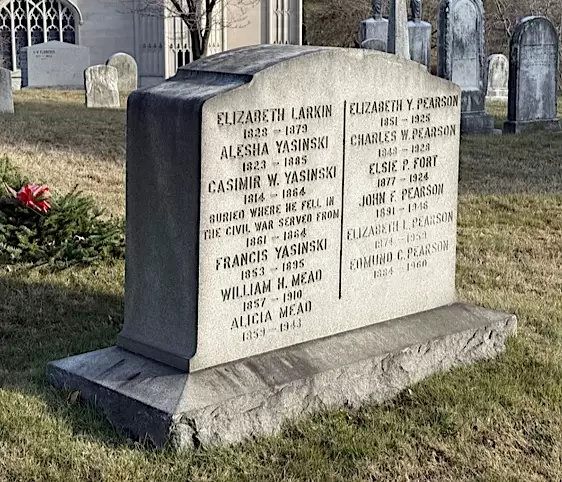
PEARSON (or PIERSON), DAVID (1840-1914). Corporal, 83rd New York Infantry, Company A; 1st Maryland Heavy Artillery, Unassigned; 1st Maryland Potomac Home Brigade Cavalry, Company A. Born in Dunfermline, Scotland, Pearson enlisted as a private in the 83rd at New York City on May 27, 1861, mustered in that date, and was promoted to corporal at some point. His muster roll notes that he was borne on the rolls as David O. Pearson and also as David Pierson. On July 3, 1863, he was taken prisoner at Gettysburg, Pennsylvania, was paroled at Annapolis, Maryland, on or about March 15, 1864, and mustered out on June 23, 1864, at New York City. On July 25, 1864, Pearson re-enlisted as a corporal at Baltimore, Maryland, and mustered into Company A of the 1st Maryland PHB (Potomac Home Brigade Cavalry) the next day. As per his muster roll, which incorrectly lists London, England, as his birthplace, he was a bookkeeper who was 5′ 7″ tall with blue eyes, light hair and a fair complexion. He mustered out on June 28, 1865, at Harpers Ferry, West Virginia. His pension index card also notes enrollment in the 1st Maryland Heavy Artillery where he was not assigned to any company. Although he applied for a pension in 1900, application 1,258,195, there is no evidence that it was certified.
In civilian life, Pearson was a maritime pilot at Sandy Hook for 41 years, retiring in 1910. Sandy Hook pilots guide oceangoing vessels, passenger ships, tankers and freighters out of the Ports of New York and New Jersey, the Hudson River, and Long Island Sound. He was listed as a pilot in Brooklyn Directories for 1889 and 1890. The 1892 New York State census notes that he lived in Brooklyn with his wife and five children. The 1900 census reports that he lived in Brooklyn with his wife and children, was a naturalized citizen and worked as a pilot. The Brooklyn Directory for 1904 and the 1905 New York State census indicate that he was a Sandy Hook pilot who lived at 457 Lafayette Avenue in Brooklyn. Pearson was a widower at the time of the 1910 census; he lived with his four daughters in Brooklyn, three of whom were public school teachers, and was still employed as a pilot.
One of Pearson’s last acts as a pilot occurred shortly before his death; he was retired at that time. The New York Herald reported in his obituary of April 12, 1914, that he accompanied two of his daughters, May (Mabel) and Helen, when they set sail aboard the Royal Mail steam packet Caribbean on a pleasure trip to Bermuda about two weeks before his death; he left them on the ship when he boarded the pilot boat and remained overnight with his old associates at Ambrose Channel in Sandy Hook. His last words to them were, “I will meet you when you cross the bar.” As per an article in The New York Times, Pearson left his daughters on their vessel when he climbed the rope ladder into the pilot boat, an act he had done for so many years; it was noted that Pearson was in apparent good health and had planned a trip to his ancestral home in Scotland. When Pearson’s daughters returned home on April 11, they expected to see their father meeting them in the pilot boat but instead, it was the sad duty of the pilot to tell the women that their father had died from heart disease. (Pearson died on April 7.) The New York Times reported a different account: that the travelers were met at the pier by their sisters who told them of their father’s sudden death.
As per Pearson’s obituary in the Brooklyn Daily Eagle, he was a member of the Royal Arcanum. Pearson’s obituary in the Brooklyn Standard Union reported that he was a retired pilot and member of the Elks. The New York Herald noted that he was a member of the Master Pilots’ Association. His death certificate indicated that he was a widower and retired. He last lived in Brooklyn at 388 Hancock Street. His funeral, Which included a requiem mass, was held at Our Lady of Victory Church at Throop Avenue and McDonough Street in Brooklyn. Pearson’s will, filed in Kings County Surrogate’s Court, named his second oldest daughter, Mabel, as executrix. Three of his daughters received $5,000 to be divided equally; Mabel controlled the remaining assets for the care of his eldest daughter, Margaret. His son, James, was not given any assets; he contested the will but a judge ruled the will valid. Section 143, lot 23549, grave 1.
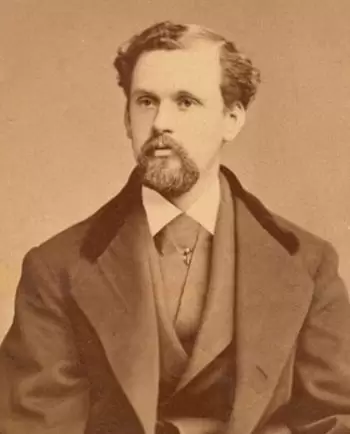
PEARSON, JAMES (1843-1890). Private, 13th Regiment, New York State National Guard, Company D; rank unknown, 22nd New York State National Guard, Company D. Although his obituary reports that he was born in New York, his death certificate and the online family tree of the Pearson family note that he was born in Donegal County, Ireland. As per the 1850 census, he lived with his mother and siblings in New York City; his father, Gibbons Pearson, who had left the family in 1848 in search of employment, died in 1849 and was buried in County Alms House Cemetery in Westchester, New York. James Pearson was educated in New York City and left school to enlist as a private at Brooklyn on May 28, 1862, the same date that he mustered into Company D of the 13th Regiment, New York State National Guard. He mustered out with his company at Brooklyn on September 12, 1862. Although his obituary states that he mustered out as a first lieutenant that is not substantiated by his soldier record.
Pearson’s pension index card indicates subsequent service in Company D of the 22nd New York State National Guard but provides no rank. The 22nd Regiment was organized on June 18, 1864, and was sent to Harrisburg, Pennsylvania the next day. Attached to the Department of the Susquehanna to July 8 and the to the Army of the Potomac until July 20, the regiment saw action at Sporting Hill, Pennsylvania, on June 30 and at Carlisle, Pennsylvania, on July 1. Pearson mustered out with his company on July 24, 1863. Two of his brothers served in the Civil War—Thomas Pearson (see), who died from wounds suffered at the Battle of Antietam, and William Pearson, who served with the 79th New York. His mother, Jane Pearson, applied for and was awarded a survivor’s pension in 1862, based on Thomas Pearson’s service, certificate 6,444.
On March 21, 1866, he married Annie J. Hume in New York City; his name is listed as Pearsons in the United Methodist Church Records. As per the 1870 census, Annie lived with her parents, siblings and her child in Brooklyn; her father was a wealthy furniture dealer. In civilian life, Pearson was a haberdashery dealer for over twenty years at 389 Sixth Avenue in Manhattan. The New York City Directories for 1872 and 1875 list him in the men’s clothing business; he lived at 428 Gold Street in Brooklyn. His business flourished until he served as a Republican on the notorious Board of Aldermen for one term beginning in 1884. During his term as alderman, he and others, a group of eighteen, were indicted for bribery in connection with the purchase of a Broadway railroad franchise. The 1884 Board of Aldermen was known as the Boodle Board; the Dutch term “boodle” means “bribe money.” In March 1886, Pearson was questioned by Roscoe Conkling before a Senate committee and admitted that his brother-in-law, a policeman, had deposited for him in the Madison Square Bank four $1,000 bills. In April 1886, he was indicted and released on $25,000 bond, posted by his brother, Alexander Pearson, who was in the furniture business. Harper’s Weekly, in an article about the scandal in 1886, reported that two of Pearson’s brothers-in-law were involved in the scheme; the policeman, Harry Hume, in whose bank account a balance of $16,000 existed before it was closed in 1886, and the other who paid Pearson’s election expenses from the account and admitted that the monies were “the profits of the aldermanic business.” In 1886, Leslie’s Magazine described the railway scandal: “Let the principals, as well as the agents, in this miserable business be uncovered and punished as they deserve.” The New York World reported at the time of his death that the attorney general had agreed to dismiss his indictment on account of lack of evidence. As per an article in The New York Times on October 16, 1892, which did not mention Pearson by name, several alderman received prison terms of varying lengths, others were acquitted after one or more trials, and others (presumably Pearson) had charges dropped on recommendation of the district attorney; Jacob Sharp, the man who would have benefited by the railway and who was convicted of bribery, died while on bail and awaiting a new trial.
After Pearson’s indictment, his clothing business was ruined. He had always lived in New York City until 1888, when he sold his store and relocated to Paterson, New Jersey. As per an undated article in The Clothier and Furnisher (Volume 17), he transferred his business after his aldermanic term ended to A. J. Pearson, presumably his wife. He then joined the firm of Pearson & Tallman on November 20, 1885, assuming liabilities of $1,800; the stock was valued at $12,000. He was a Freemason and was active in his Presbyterian church. While in Manhattan, he lived at 310 West 20th Street.
Pearson met an untimely death when he was mortally wounded after being struck by an Erie Railroad car at the mouth of the Bergen Tunnel in Jersey City, New Jersey. The New York World reported on June 10, 1890, that Pearson boarded the wrong train and after realizing his error, jumped off the train. He slipped and fell and was hit by the engine of an oncoming train. Pearson was described as tall, well-built with dark eyes, ruddy complexion, brown moustache and slightly bald. He was thrown by the train suffering injury to his arm, broken ribs and severe internal injuries. After being carried to the platform, an unconscious Person was taken to St. Francis Hospital in Jersey City. As per his obituary, his right arm was badly mangled, necessitating amputation; he then took a turn for the worse and succumbed to his injuries on June 17 at St. Francis Hospital. The New York Sun and the Buffalo Evening News both reported on his fatal accident. His funeral was at the home of his brother, Alexander Pearson, at 29 Seventh Avenue in Brooklyn. In 1891, Annie Pearson applied for and received a widow’s pension, certificate 363,734. Section 152, lot 19039.
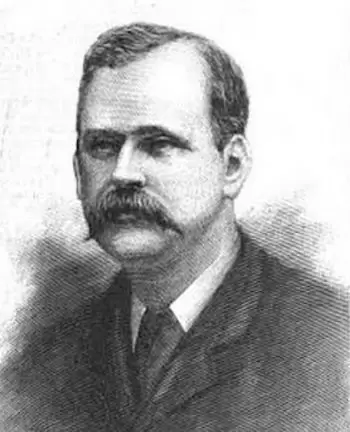
PEARSON, THOMAS (1839-1862). Private, 9th New York Infantry, Company C. An Irish native, Pearson enlisted at New York City on May 2, 1861, and mustered into the 9th New York two days later. As per his muster roll, he was a stone-cutter who was 5′ 8¾” tall with brown eyes, brown hair and a fair complexion. Wounded at the Battle of Antietam on September 17, 1862, he died of his wounds on October 14, 1862, at Locust Spring Hospital in Sharpsburg, Maryland. At the time of his death, Pearson had the following personal effects: one blue flannel shirt, one Zouave jacket, one vest, one red sash, one towel, one testament, one portfolio and one bag of sundries. His name appeared in the list of Bodies In Transit for October 1862, as a victim of wounds at Sharpsburg, Maryland. The following condolence letter, written on October 16, 1862, by Pearson’s commanding officer, was addressed to his mother:
Madam,
It becomes my sad and painful duty to announce to you the death of your son, Thomas Pearson, a private in my company. He died on the 14th day of October 1862, from the effects of his wounds, in the Division Hospital near Sharpsburg, Md., where he was under the care of good physicians and nurses, who did everything to restore him his health.
His public and private character was such, as to make him universally esteemed by his comrades and officers, and his death proves a great loss to his company.
The effects belonging to the deceased will be forwarded to you at the earliest opportunity.
Trusting, dear Madam, that you will bear your loss calmly and with submission to the will of the Almighty, I remain,
Yours respectfully,
Robert McKechnie, Lieutenant Comdg., Company H, 9th New York Vol.
On November 24, 1862, Jane Pearson (née Jane Wilson), his mother, applied for and received a survivor’s pension of $8 per month, certificate 6,444. In her pension application, Jane Pearson noted that her husband had been absent from the family for 13 years, was presumed dead, and that Thomas contributed to her support before and after his enlistment. She noted that Thomas was unmarried and that she had no other means of support. In addition, she presented her marriage certificate to Gibbons Pearson, dated April 11, 1831, in All Saints Parish in Donegal, Ireland. She noted that she lived at 267 Eighth Avenue in New York City; Jane Pearson signed her affidavits with an X, an indication that she was illiterate.
Alexander and William Wilson, who lived in Jersey City and are possibly her brothers, attested in an affidavit on May 30, 1863, noting Jane Pearson’s living circumstances. They reported that Gibbons Pearson, a man of “unsteady habits,” left the family in search of employment in the interior of the state about 13 years before Thomas Pearson died. The family had had no further contact except word that he had died about a year after he left the house; Gibbons Pearson was buried in the County Alms Cemetery in Westchester, New York, in 1849. At the time of their deposition, Mrs. Pearson was left with five other children, including William Pearson, who was serving with 79th New York Infantry (the Highlanders) and James Pearson (see); their affidavit noted that Thomas Pearson provided the bulk of her support. Another affidavit, dated September 3, 1863, and signed by Ann Bovard (relationship unknown) and Eliza Jane Laird (possibly her daughter) and submitted to the Court of Common Pleas notes that the two women had known Jane Pearson and Thomas Pearson since he was an infant. They attested that Thomas gave his mother three dollars a week before his enlistment and the principal part of his soldier pay; another son, William, gave an occasional payment and a third son boarded with her and paid her $2.50 per week. Section 152, lot 19040.
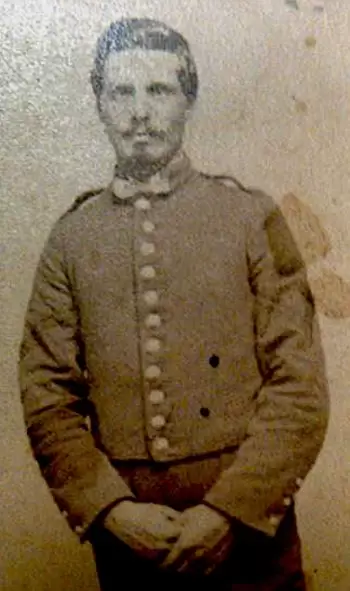
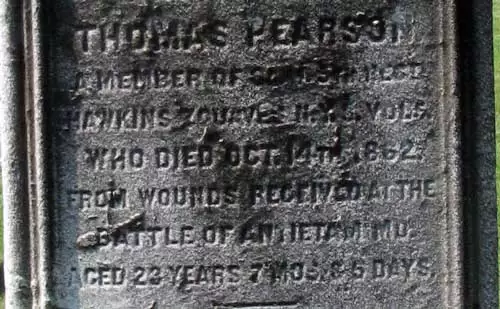
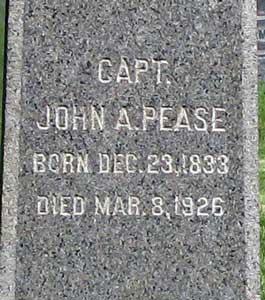
PEASE, JOHN A. (1833-1926). Ship captain. Born in Brooklyn, he went to sea when he was seventeen, following in the footsteps of his father, William Pease, a well-known sea captain. The 1850 census notes that he lived in Caldwell, New Jersey, and was already an engineer. During the Civil War, John Pease commanded the Alice Price, a vessel that carried supplies to fleets in the Gulf of Mexico and the Mississippi River and was with Admiral David Farragut at the Battle of Roanoke, North Carolina, in February 1862.
After the Civil War, Pease continued his seafaring life. He captained the Nellie White between New York and Norwalk, Connecticut; the Minnie Stanford and the Kinnedank which ran between Philadelphia and Cape May, New Jersey; and another boat which traveled the waters from New York to Galveston, Texas. Subsequently, Pease organized the Knickerbocker Steamboat Company which built steamboats, including the General Slocum (built in Brooklyn in 1891), which tragically burned in the East River on June 15, 1904, resulting in over 1,000 deaths, and the Grand Republic, which he commanded for many years, beginning in 1877. He is listed as an engineer in the 1880 census.
One obituary, which confirms his Civil War service, noted that Pease was captain of the Grand Republic, which plied the waters from New York City to Rockaway, Queens, for thirty-three years. His first wife of 40 years, Harriet L. Pease, died while on a pleasure excursion aboard the Grand Republic on June 3, 1900. As per an article on her death in the Brooklyn Daily Eagle, she took sick while on that vessel, was attended to by two physicians, then taken to her husband’s quarters where she later succumbed to apparent heart disease. At that time, they lived at 354 7th Street in Brooklyn.
On October 16, 1901, Pease married his second wife, Harriet Heyman, in Brooklyn, at the parsonage at 385 9th Street. As supervising captain and stockholder of the Knickerbocker Steamship Company, Pease was the subject of an article in The World on August 1, 1904, after the burning of the General Slocum. He appeared in the United States Circuit Court after a federal Grand Jury charged him and six others with responsibility for the tragedy. (Another source indicates that eight were charged.) Pease was indicted for “aiding and abetting criminal negligence.” He was described as a “venerable man with a long flowing beard” who was intensely nervous. The New York Evening Post reported that Pease, one of those found criminally responsible for the Slocum disaster, paid $5,000 bail at the Bronx coroner’s office. His sister, Caroline Armstrong, provided the money after giving two houses in Brooklyn as security. Ultimately, only the captain was convicted of criminal negligence and sentenced to prison; the Knickerbocker Steamship Company had to pay a small fine although there was some evidence that inspection records were falsified. Federal and State regulators were motivated to add emergency equipment on passenger ships as a result of the accident.
After retiring in about 1906, Pease was active in his community, Verona, New Jersey, where he was a founder and director of the Verona National Bank, later known as the Verona Trust Company. He was also a Freemason. The 1910 census lists him as living in Verona, New Jersey, with his wife and supporting himself by his “own income.” His obituary in the Brooklyn Standard Union confirms his Civil War activities as a supplier to ships in the Gulf of Mexico and the Mississippi River. He last lived on Lakeside Avenue in Verona, New Jersey, his home for most of his life; he was survived by his second wife. Section 166, lot 30549, grave 1.
PEASE, NICHOLAS W. (1843-1904). Private, 48th New York Infantry, Companies B and H; 10th Veteran Reserve Corps, Company G. A native of New York City, by the time of the 1855 New York State census records Pease was living in Brooklyn with his parents and siblings. His father, Reverend John Morris Pease, and his maternal grandfather, Reverend Dr. White, were early Methodist leaders in Brooklyn. He still lived in Brooklyn at the time of the 1860 census.
During the Civil War, Pease enlisted at Brooklyn on September 4, 1861, and mustered into Company B of the 48th New York the next day. He transferred into Company H on an unstated date and was wounded at some point; his muster roll notes his absence due to wounds and that he was hospitalized in New York City because of those wounds. Pease transferred into the 10th Veterans on February 6, 1864, and mustered out on September 1, 1865. Although the date of muster out was September 1, 1865, he applied for and received an invalid pension on January 31, 1865, certificate 76,565.
The 1872 and 1873 Jersey City Directories list Pease as a policeman whose home address was at 196 Montgomery Street. An article in the Brooklyn Daily Eagle on November 22, 1872, citing a story in the Sun, casts light on a controversy that led to his resignation from the force. That article notes that after he received three days leave of absence and $160 in back pay, he told his wife to meet him at his brother’s house in Brooklyn Heights and then disappeared. The Jersey Journal, reporting on the same incident on November 22, described Pease as a rather fleshy man, fine in appearance with a moustache and goatee; although he was of good character, he had the reputation of being a “Lothario.” He apparently became enamored of a woman named Lottie Cooley, and after a disappearance of a couple of days, was found by Captain McHorney of the Jersey City Police Department, who was accompanied by Pease’s brother, at the house of Lottie’s married sister. At first, Nicholas Pease was not found when the officer and Pease’s brother entered the house on Schermerhorn Street where the family surrounded the coffin of an infant. After Lottie, a good-looking brunette described as “fast,” was questioned, Pease’s brother was ejected from the house, and later, McHorney drew his revolver when Lottie’s sister and her husband set upon him. At that point, Nicholas Pease appeared and begged the officer not to shoot. Oddly, Pease, Lottie, McHorney and Pease’s brother then went out together to eat oysters. At that time, Pease promised to return home, and asked that his poor wife get his next two week salary. Pease resigned his position and returned police property to the department. The Jersey Journal noted that Pease’s wife “merits the sympathy of everybody.”
The 1878 Jersey City Directory indicates that he was a stevedore who lived at 212 Fourth Street while the 1879 Jersey City Directory notes that he was a clerk who lived at 204 Fourth Street. According to the 1880 census, he lived at 216 Fifth Street in Jersey City with his wife, Josephine, and daughter; he then worked as a clerk. He was listed as a clerk in the 1882 Jersey City Directory who lived at 218½ Fifth Street; he was still a clerk in the Jersey City Directory for 1883 with a home address at 206 Fifth Street.
Pease’s womanizing continued. The Daily Saratogian reported on December 2, 1887, that Mrs. John W. Jeffers left her husband, a New York ice dealer, in July and was found by detectives living with Pease, a former boarder, in Jersey City. Mr. Jeffers sued Pease for $10,000 in damages for alienating his wife’s affections. The article noted that Pease was in the Ludlow Street Jail in New York City in default of $2,000 bail and that Mr. Jeffers planned to divorce his wife, Cora. The Press reported on January 6, 1888, that a class leader of the Methodist Church on Laight Street sought to get Pease released from jail after his November 29, 1887 arrest; the World reported four days later that Judge Andrews ruled that Pease must remain jailed. On February 21, 1888, the New York Herald reported on the story, noting that Pease was formerly employed by the Old Dominion Steamship Company and was a leading light in the Duane Street Methodist Church. He and Mrs. Jeffers, also a church member, were said to have “yielded to temptation and fell.” The Daily New Era, a newspaper in Lancaster, Pennsylvania, reported on June 12, 1888, that Pease, a Methodist class teacher, was still jailed, and indicated that he could never repay the $10,ooo judgment to Jeffers, who had seemingly reconciled with his wife. Pease further declared that a wound that he incurred during the Civil War, had re-opened and that he was in danger of death. He appealed to the Supreme Court for his release; Judge Andrews reserved his decision, and Pease was ultimately released.
On April 30, 1890, Pease married Elizabeth Forshan in Manhattan. As per the 1900 census, he lived in Manhattan with his wife, Elizabeth, and his two children; his occupation was listed as clerk. The New York City Directory for 1894 lists him as a clerk who lived at 114 Bank Street. His last residence was on Charles Street in Roselle Park, New Jersey. His death was attributed to chronic interstitial pneumonia. Pease’s funeral was held at the Church of St. John the Evangelist at 11th Street and Waverley Place in Manhattan. Shortly after his death in 1904, Elizabeth F. Pease, his second wife who is interred with him, applied for and was awarded a widow’s pension, certificate 582,278. Section 74, lot 10237.
PEASE (or PEAS), WILLIAM EMORY (1840-1875). First lieutenant, 117th New York Infantry, Companies B, K, H and E. Although his surname is spelled “Peas” in the Green-Wood database, his wife’s name and his name on soldier and other records is noted as “Pease.” Pease was born in Richmond, Massachusetts. After he enlisted as a sergeant on July 17, 1862, at Utica, New York, he mustered into Company B of the 117th Infantry on August 9. As per his muster roll, he was a clerk who was 5′ 8″ tall with grey eyes, light hair and a light complexion.
As per his online biography on Find-A-Grave, William Pease’s records are reported on the Hamilton College site. According to that biography, he was a color sergeant at the Battle of Drury’s Bluff, Virginia, on May 14, 1864, and was wounded in the abdomen while bearing the flag to the front. The Utica Morning Herald of May 25, 1864, printed parts of Pease’s letter in which he stated that the 117th was in a severe battle when he suffered a “glance shot” to his abdomen, which “while painful and sore should be well in a couple of days.”
He was promoted to second lieutenant of his company on May 19, 1864. His muster roll reports that he was due pay for commanding Company B from August 18, 1864, to November 20, 1864; and for commanding Company K from December 5 to 31, 1864. He rose to first lieutenant on January 19, 1865, and continued to command Company K through February 17, 1865. His soldier record and muster roll indicate a transfer to Company E on January 31, 1865 (with pay from January 19), but the muster roll has the written notation that he commanded Company H from January 16 through March 14, 1865.
Among the engagements that the 117th Regiment fought in were the Battles of Cold Harbor, Petersburg, Chapin’s Farm and Darbytown Road, Virginia, and Fort Fisher, North Carolina, where the 117th led the charge. On June 8, 1865, he was discharged at Raleigh, North Carolina. The New York Times reported on June 21, 1865, that Lieutenant Wm. E. Pease was among the passengers who arrived in New York City aboard the USS Ellen S. Terry from New Berne, North Carolina.
The 1872 Brooklyn Directory lists William E. Pease as a clerk at 14 Wall Street whose home address was 304 East 119th Street in New York City. The Brooklyn Daily Eagle noted that he married Jennie (also known as Jane) L. Mortimer on February 26, 1873, at the M. E. Church on Sands Street in Brooklyn; papers in Utica, New York, were asked to copy the announcement. Records from the Treasury Department for Civil, Military and Naval Service note that William Pease was paid $1,200 for his military service.
On January 10, 1875, the New York Herald reported that a William E. Pease, who had a fair complexion, light hair, gray eyes and a full beard and mustache, was missing from his home as of December 3, 1874; the description matches that on his muster roll. At the time of his disappearance, he was wearing a dark steel mixed overcoat, black frock coat and vest, steel mixed pants, low button shoes and a black felt hat. His last address was Kings County Farms in Long Island, New York.
At the time of the 1880 census, his widow, Jane Pease and their son Wilford (Wilfred), were living with her father, John Mortimer; an infant daughter was buried in 1874. Jane Pease verified her husband’s Civil War service on the 1890 Veterans Schedule. Jennie Pease, who is interred with him, applied for and was granted a widow’s pension in 1892, certificate 623,334. Section 68, lot 3635.
PEASNER, JOSEPH (1840-1876). Private, 73rd New York Infantry, Companies K and F. Originally from Washington, D.C., Peasner enlisted at New York City as a private on May 5, 1861, and mustered into Company K of the 73rd New York on July 10. On September 1, 1861, he transferred within the regiment to Company F. Peasner deserted from a military hospital at New York City on January 18, 1864. According the the 1876 New York City Directory, he was employed as a caulker. His last residence was 24 Monroe Street, New York City. His death was attributed to a fractured skull. Section 15, lot 17263, grave 304.
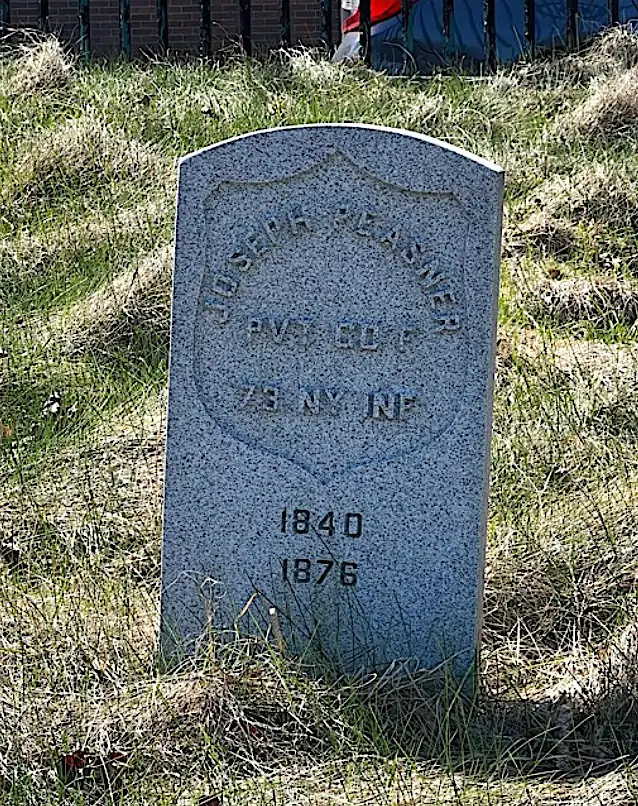
PECK, ADDISON (1844-1882). Sergeant, 162nd New York Infantry, Company A; private, 71st Regiment, New York State National Guard, Company B. After Peck enlisted as a private at New York City on May 27, 1862, he mustered into Company B of the 71st Regiment from which he mustered out on September 2 at New York City. Three days later, he re-enlisted as a sergeant and mustered into the 162nd New York on October 18. He deserted the next day at Riker’s Island, New York Harbor. He died of paresis at the Bloomingdale Asylum in New York City. Section 8, lot 4977.
PECK, EBENEZER M. (1841-1912). Corporal, 60th New York Infantry, Company K. Peck enlisted as a corporal at Ogdensburgh, New York, on September 14, 1861, and mustered into the 60th New York on October 30. On March 15, 1862, he was discharged for disability at Camp Preston King in Baltimore, Maryland. He was a member of G.A.R. Post #621. His last residence was 680 Summer Avenue in Newark, New Jersey. His death was attributed to chronic fistules. Section 15, lot 17263, grave 1256.
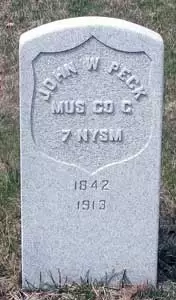
PECK, JOHN W. (1842-1913). Musician, 7th Regiment, New York State National Guard, Companies H and C. A native of New York City, Peck enlisted there in 1862 as a musician. He mustered into Company H of the 7th Regiment and served for three months. In 1863, he returned to the 7th Regiment as a musician for 30 days, but served in Company C. His application for an invalid pension was granted in 1898, certificate 976,541. At the time of his death, from “senile pneumonia,” Peck was a resident at the Soldiers’ Home in Kearny, New Jersey. Section 116, lot 4073, grave 319.
PECK, LEWIS MEAD (1832-1919). Major general by brevet and brigadier general by brevet; colonel, 173rd New York; captain, 67th New York, Company K. Peck was born in Greenwich, Connecticut. As per his biography in the records of Norwich University, Peck entered Norwich University in 1856 and stayed for two years.
His obituary in the Brooklyn Daily Eagle reports that in April and May of 1861, Peck helped in forming Company K of Beecher’s Long Island Volunteers, the 67th New York Volunteer Infantry. He then enlisted at New York City on June 4, 1861, and was commissioned into the 67th New York as a captain on June 24. The 67th Regiment took part in Major general George McClellan’s Peninsula Campaign in which it engaged in skirmishes at Yorktown and Williamsburg, Virginia, before Peck was wounded at Fair Oaks, Virginia, on June 1, 1862. Shortly after his discharge for promotion to major on October 10, 1862, he was transferred into the Field and Staff of the 173rd New York Infantry as lieutenant colonel on October 30, and was dismissed on March 13, 1863. Two days later, he was promoted to colonel and restored to the Field and Staff of the 173rd on May 29, 1863. In 1863 and 1864, the 173rd fought in the following battles in Louisiana: Port Hudson (June 14, 1863); Carrion Crow Bayou (November 11, 1863); and the Red River Campaign (March 10-May 22, 1864).
In his battlefield report from Alexandria, Louisiana, on April 30, 1864, Lieutenant Colonel Justus W. Blanchard, commanding officer of the Third Brigade, singled out Colonel Peck who, “…acting as a volunteer aide, [is] entitled to especial thanks for [his] assistance in disposing the troops and bringing up the charge…” However, on May 8, 1864, he was charged with not rallying his troops at the Battle of Pleasant Hill, Louisiana, on April 9, with abandoning the regimental colors, and for not preceding his men into battle. He was dismissed on June 10, 1864, but that dismissal was subsequently revoked on July 8, 1864, and he was acquitted of the charges after a court-martial that November. At that time, the 173rd was in Virginia prior to the Shenandoah Campaign.
After Peck was brevetted to brigadier general and then to major general on March 13, 1865, “for gallant and meritorious conduct at the Battle of Cedar Creek, Virginia, on October 19, 1864,” he mustered out at Savannah, Georgia, on October 18, 1865. As per his obituary in the Brooklyn Daily Eagle, Major General Philip Henry Sheridan endorsed the brevet of Peck, as found in hia handwritten note in War Department files: “The services rendered the Government by Gen. Peck during the time he served under my command entitles him to the brevet of major general of volunteers, and I request that that honor be conferred upon him.” Peck’s obituary in the Brooklyn Daily Eagle further notes that he engaged in 18 battles and as many engagements, and two sieges; during his service, he was wounded twice, once severely, and had two horses shot from under him. That obituary goes on to state that when the regiment disbanded at David’s Island, New York Harbor, in October 1865, there were only 400 men; there were more than 600 casualties in the three years of service with the loss of nearly all of its original field and line officers. (The article about the 50th anniversary of the regiment’s mustering into active service in the Brooklyn Daily Eagle notes that 1,200 rifles left for battle and only 300 were at muster out.)
After the Civil War, Peck worked as a broker and a clerk and was a member of the Henry M. Lee Post #21 of the G.A.R. As per the census of 1870, he was living with his mother in Brooklyn and was employed as a broker. In 1872, Peck applied for and received an invalid pension, certificate 121,301. At the time of the 1875 New York State census, he was still living with his mother in Brooklyn. On December 20, 1883, he married Emily Seymour. In 1890, he joined the Abel Smith Post #435 of the G.A.R.; he listed his birthplace as Connecticut and his occupation as public service. The Abel Smith Descriptive Book notes that he was “re-obligated” in 1890. The 1892 New York State census notes that he was married with a child, lived in Brooklyn, and worked as a clerk.
On August 14, 1892, the Brooklyn Daily Eagle reported that the Home and Country Magazine for August had a full page engraving of the charge of the Brooklyn police regiment at Port Hudson, Louisiana, accompanied by a description of the battle by Lewis Peck. (The 173rd Regiment, before it mustered was known as the Fourth Regiment, Metropolitan Police Brigade, each policeman acting as a recruiting agent under the direction of the police commissioner.) An article in the Brooklyn Daily Eagle on the 50th anniversary of the 173rd noted that the Battle at Port Hudson in June and July of 1863 took a heavy toll on the regiment—twenty-three were killed, fifteen of them officers and seventy wounded; only Vicksburg took a higher toll.
Peck was active in the Republican Party in Brooklyn and treasurer of the Brooklyn Republican Club. On April 25, 1897, the Brooklyn Standard Union published a letter to the editor, from William Welwood, the secretary of the club, arguing that it was improper of Peck to make his personal preference for mayor known to the public in his interview in the Sun. The Brooklyn Directory for 1897 lists him as a treasurer. On January 28, 1898, the Brooklyn Times Union reported that at the Republican Club reception, Peck, whose term as treasurer had ended, was presented with a diamond solitaire stud in appreciation of his work. The gift was a surprise and Peck thanked everyone for their kind remembrance.
The 1900 census notes that Peck worked as a clerk at the Department of Taxes and lived in Brooklyn with his wife and daughter. On March 28, 1903, the Brooklyn Times Union reported that Peck attended a meeting of 173rd Veterans at the Saengerbund Hall to prepare for a memorial service for the 900 members of the regiment who were deceased. The newspaper reported that Peck made an address on the “Negro question.” His remarks, which are quoted here, reflect the tense race relations of the Jim Crow era. The article, in paraphrasing, indicated that Peck said: “Negroes were capable of good citizenship and noble effort. There was no danger, however, that they would ever dominate this country. They would, he declared, become a powerful factor in public affairs in the proportion that their fund of knowledge increased.”
The 1904 Brooklyn Directory lists Peck as a clerk with a home address at 348 Bridge Street. As per the 1910 census, he was still employed as a clerk and lived in Brooklyn with his wife and daughter. On November 10, 1912, the Brooklyn Daily Eagle published a feature article on the “fifty grizzled warriors” of the 173rd Regiment who met to celebrate their fiftieth anniversary of mustering into active service and “clasp hands again” at Saengerbund Hall. Peck, the president of the 173rd Survivors’ Organization, presided over the reception, the theme of which was “One County, One Flag.” That article noted the tremendous losses suffered by the regiment and that the meeting was filled with silent toasts to the deceased and retelling of war stories.
According to his death certificate, he had been a resident of New York City for 70 years, was married and retired. Peck’s obituary in the Brooklyn Standard Union recounted his Civil War service, noting his rapid promotion for “gallant fighting.” That obituary indicated that he kept a low profile in public life and had for many years worked at the Brooklyn office of the Department of Taxes and Arrears. His last residence was on Clinton Avenue in Brooklyn where he died of senility at age 86; his obituary in the Brooklyn Standard Union noted that he had been in declining health for a year and a half. His funeral took place at the First Presbyterian Church near Henry Street in Brooklyn; Peck was a member of the congregation for about 70 years. In 1919, Emily Peck, who is interred with him, applied for and received a widow’s pension, certificate 864,900.Section 46, lot 23086.
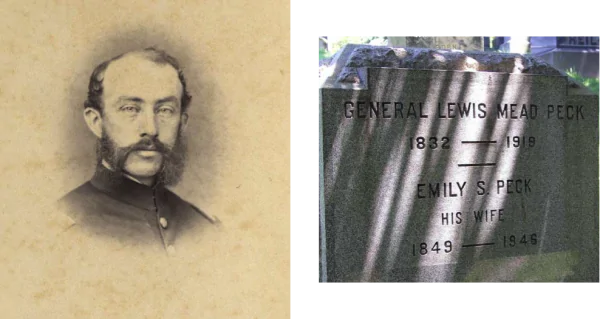
PECK, THOMAS BLOODGOOD (1832-1912). First lieutenant and adjutant, 4th Regiment, New York State National Guard. A native New Yorker, he was a descendant of William Peck, who came to New York from London in 1827 and was influential in early colonial history in Westchester County. His mother’s family, the Bloodgoods, were among the early settlers of Flatbush. On April 17, 1863, the Philadelphia Inquirer announced Thomas Peck’s marriage to Mary Francis Staunton, the daughter of Reverend Dr. Staunton, at the Zion Church on Madison Avenue in New York City.
During the Civil War, Peck enlisted at New York City as a first lieutenant on June 20, 1863, was commissioned into the 4th Regiment on July 18 as a first lieutenant and adjutant, and mustered out on July 24 of that year at New York City. The 4th Regiment was raised in response to General Robert E. Lee’s invasion of Pennsylvania and served there during its activation. On April 28, 1864, the New York Daily Herald reported that the 4th Regiment was called to serve for 30 days in defense of New York Harbor and that Thomas Peck, the adjutant, had resigned. His comrades honored his faithful performance as an efficient officer of the command and with regret, wished him well.
The 1867 New York City Directory lists Peck as a merchant at 75 Chambers Street whose home was in Port Chester, New York. As per the census of 1870, he lived in Rye, New York, with his wife and two children and was employed as a hardware retail merchant; that census reports that his real estate was worth $8,000 and his personal property was valued at $5,000 (the equivalent of $225,000 in 2019). An article in The New York Times on December 26, 1873, notes that Peck awakened and scared away two burglars who made an attempt to open the windows of his home in Rye around midnight on December 22. The 1876 New York City Directory lists him as a merchant who lived in Rye. At the time of the 1880 census, he lived at 111 East 34th Street in New York City with his wife and three children and was a merchant’s dispatch.
Peck’s obituaries note that he was largely interested in fire insurance companies. The New York Times reported on December 24, 1900, that he had been elected inspector of the Empire City Fire Insurance Company at 50 Wall Street. As per the 1910 census, Peck is listed as living in Manhattan, married with servants and working at an ironwork shop. His obituary in the Rye Chronicle notes that at the time of his death, Peck was a director of the Empire City Fire Insurance Company and president of the Port Chester Savings Bank, having been first elected to its Board of Trustees on October 10, 1877, and elected its president on January 14, 1902. The 1912 Port Chester Directory lists him as president of the Port Chester Savings Bank and living in New York City. The Rye Chronicle obituary indicates that Peck, who retired in the 1890s, was a longtime resident of Rye Village in Westchester, New York, where he was active in the Christ Church there, serving as vestryman and superintendent of the Sunday school for many years. A banker and philanthropist, he helped repay the church’s debt.
As per his obituary in the New York Herald, Peck devoted himself to philanthropic and charitable causes. He was a warden and vestryman at the Church of the Transfiguration in New York City and was treasurer of its endowment fund. In addition, he was a trustee of the House of Mercy and was a member of the American Institute, the Metropolitan Museum of Art, the St. Nicholas Society and the Colonial Order of the Acorn, an organization of descendants, on the male line, of residents of the American colonies prior to July 4, 17776. His obituary in The New York Times notes that he read that newspaper since its first issue in 1851 and kept a copy of that edition in his library of historical papers. He last lived at 111 East 34th Street in New York City. His death was attributed to rheumatism. He was survived by his widow and two sons; their daughter predeceased him. His funeral was held at the Church of the Transfiguration in New York City. Section 171, lot 10470.
PECKHAM, GEORGE (1822-1864). First lieutenant, 3rd New York Regiment, Merchants’ Brigade; quartermaster, 178th New York Regiment. Peckham was born in New York City. According to the 1850 census, he lived with his wife and young daughter at the home of his sister and brother-in-law, Nicholas Cort. That census states that Peckham was employed as a clerk. The 1855 New York State census indicates that Peckham and his wife and two children were boarders in New York City; he was working as a merchant.
At the age of 40, Peckham enlisted on October 23, 1862, and was commissioned into the 3rd New York’s Field and Staff four days later; his regiment was known familiarly as the Third Merchants’ Brigade. (The New York Times reported on July 29, 1862, that the mercantile community met at the Hall of the Chamber of Commerce with the intent of raising a corps under their auspices; local groups or individuals who raised companies were then known by those familiar names.) As per his muster roll, Peckham was a lawyer who was 5′ 4″ tall with gray eyes, brown hair and a fair complexion. A Board of Alderman document indicates that volunteers of the Merchants’ Brigade were paid a bounty of $50. He then served as a quartermaster in the 178th New York when the two units were consolidated until his discharge on January 9, 1863. The 1863 Draft Registration lists Peckham as a lawyer living in New York City.
As per his obituary in The New York Times and other newspapers, Peckham died suddenly; members of the International Order of Odd Fellows, of which he was a member, were invited to attend his funeral. He last resided at 160 West 21st Street in New York City. Section 61, lot 11056.
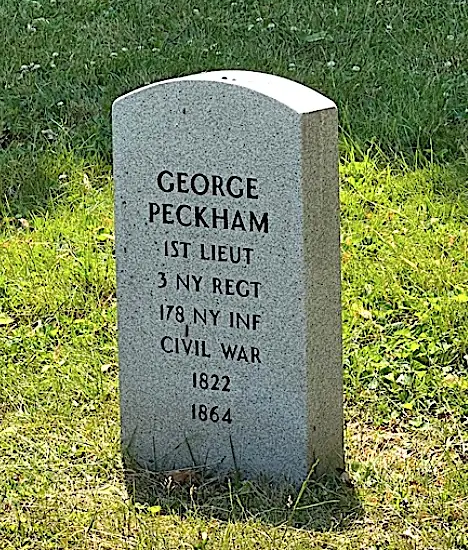
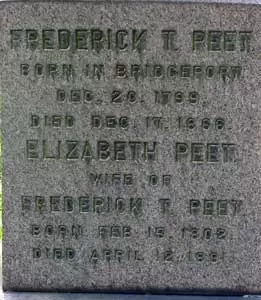
PEET, FREDERICK TOMLINSON (1841-1925). First lieutenant, United States Marine Corps; second lieutenant, United States Volunteers, 1st Sharpshooters; private, 7th Regiment, New York State Militia, Company H. Peet was born in Brooklyn and educated at Brooklyn Polytechnic and Churchill Military Academy at Sing Sing (now Ossining), New York.
After he enlisted as a private on April 17, 1861, at New York City, Peet mustered into the 7th Regiment on April 26, and mustered out on June 3 of that year at New York City. In 1917, his nephew, identified as R. T. in the Prefatory Note, published Civil War Letters and Documents of Frederick Tomlinson Peet, a collection of letters to family members and other correspondence related to his Civil War service. The letters cover topics from the mundane including requests from home, to his military experiences and his interest in obtaining a position with the Marine Corps. (Paragraphs and some apostrophes were added to make the letters easier to read in this biography.) Peet wrote to his parents from Annapolis Harbor, Maryland, on April 21-22, 1861:
Dear Mother & Father,
So far so good if we except the accommodations, which are more like the middle passage of a slaver than anything else I know of. But I forgot to tell you. We left Philadelphia on the Steamer Boston Saturday afternoon at 3, and have been on the water ever since. The Boston is a small steamer made to hold about 700 persons so you may imagine what a display we make about 12 o’clock every night; every available spot is covered with a soldier. I have not taken off my clothes since we left, to give you an idea how we sleep would be beyond my power, last night I had on beside my overcoat my knapsack, bayonet, a great tin canteen, a body belt Cartridge box, cap box & cap, besides having my pockets filled with all kinds of things.
The first night we land over at Philadelphia not being able to go on through Baltimore. I did not sleep the least, and about 3 in the morning most of us were astir and paraded through the outskirts of the city with a drum, calling for Coffee, the people put their heads from the windows in their nightcaps, (and I never saw such an ugly set of people) and soon came down and gave us all we wanted. In the afternoon we marched from one side of the city to the other and there embarked on board the Boston.
Sunday was passed on the water. We had a sermon from Chaplain Weston which I liked pretty well, although have heard better from Dr. Cutler. Yesterday we expected to sail up the Potomac to Washington but as one gun the Enemy could knock our machinery useless, and we had no armed escort we find ourselves at Annapolis instead of the Potomac. Not one of us knows which way we are to go, nor have we since we left.
The Boston regiment is here in the harbor, and they keep drilling all the time. Every moment you can see the bayonets gleam as they are shifted from one side the other; the upper deck of their boat is covered with them. The frigate Constitution is here and looks finely. Colonel Lefferts (see) has had an interview with her Commander & also with the Commander of the Boston Regiment, Mr. Butler. On the fort in Annapolis the Stars & Stripes are flying, while little boats are humming around and remind me very much of Bridgeport Harbor.
We expect to go ashore & march to Washington but nobody knows anything about it. The drum is now beating the Sergeants call, to give them the necessary commands. We should have been in Washington yesterday morning if we had not been obstructed by the pulling up of rails. I will write you more when in Washington.
I wish I could give you a faint description of what we sleep on. A great many of the men had mattresses while others managed to find some tents stowed away and used them for beds. I was lucky enough to get one of the latter, and laid down all right, although rather cold, to take my sleep, but as a fellow I knew came along I gave him half and it wasn’t long before I was crowded almost off, half on the dirty floor & half on the dirty canvas; the next night I sleep on the hard boards; but I must leave off as we are called to posts to receive orders.
Give my love to all.
On April 29, he wrote to parents describing the march to Washington, D. C., and review by President Abraham Lincoln. He described the oath taken by the soldiers: “In the oath we swore to uphold the Constitution, obey all the officers placed over us and to battle for our Countries (sic) honor & against all enemies of the government whosoever they might be.” He noted, “In the afternoon Abe Lincoln & Wm H Seward came in and addressed us…” Although Peet was upset about losing his watch, he was happy that the Washingtonians were delighted to see the soldiers and that “half of them would not take any money from us, but gave us all we wanted, everybody came up shaking hands and saying “God bless you as if they had known all for years; they were in a great state of fever before our arrival, expecting a visit from Jeff Davis.”
Shortly after his muster out from the 7th Regiment, Peet enrolled in the 1st Sharpshooters, known familiarly as Berdan’s Sharpshooters, on September 16, 1861, was promoted that day to second lieutenant, and mustered in on October 24. He wrote to his father from Sharp Shooters Instruction Camp on January 17, 1862:
My dear Father,
All right at Camp. Our rifles are ordered by Assistant Sec of War Scott; the Colonel read the order a few days ago on the parade ground, I don’t see how there can be a mistake now. We are to have Sharpes, double trigger and angular bayonets (30 inch). Our sickness is decreasing, only one died last week. Most of our company invalids are safely and pleasantly situated in the Indiana Hospital, (Patent Office). I visit the sick of our company every day in Camp, and generally stop a moment at the Patent Office when in the city.
I intend going down tomorrow. I have endeavored to see Mr. Odell [likely Congressman Moses Odell-see] but as yet have been unsuccessful in meeting him, or finding him in, he is residing at Willards. I remained over night last Monday with the Captain who has taken a room on F. Street, and endeavoring to get the better of a cold which has been hanging on for some weeks. I went to Mr. Odell’s room but he was not in. Wm sent me a letter to Mr. Roscoe Conkling, from Oneida County, N.Y.; he wishes me not to mention my marine affairs.
I am glad to hear that the Miss Morrells are to be in town. I shall not fail to see them.
Our men are in want of prayer books. If the Tract or Bible Society can send us some I wish you would forward them immediately. We have had none given to us. Tell Mother I want to see her but won’t get a furlough until we have a fight. I shall have some photographs taken tomorrow if it is a promising day. My pantaloons if I wish can be made in Washington. I have bought a very nice silver watch for $13.50. Creighton intends to buy one like mine for Charley. I shall see him tomorrow and if possible sell him mine and then send you the money to buy a better one. I must now say good by. With much love to all, I remain Your Affectionate Son, Fred
Peet fought in the following battles of the Peninsula Campaign in Virginia: Yorktown, Chickahominy, Hanover Court House, Savage Station, White Oak Swamp, and Nelson’s Farm.
Peet wrote to his sisters from Chickahominy, Virginia, on May 30, 1862:
Dear Hattie & Rebekah,
Since I wrote my last letter our camp has been moved once or twice. We arrived here at noon on Monday last and encamped in the rain. That night at 9 or 10 orders came to cook two days rations and be ready to start at 5 next morning each man to have 60 rounds of cartridges.
I was up Tuesday morning at 3 A.M. and at 5 we all start in a dismal rain storm. Our march was through such a series of small puddles and bad roads that I never hope to see such another day. It seems that we were ordered to proceed to Hanover C[our]t House and break up the railway or burn bridges, thus destroying the connections between Fredericksburg and Gordonsville with Richmond.
We arrive at the Court House at one P.M., met the enemy and had quite a battle. Our R[e]g[imen]t had some 8 men wounded one or two severely. None were hurt in Co. H. We did not take as active a part a some of the other Rgts namely 25 & 14 & 44 N.Y. also 2 & 4 Maine. I suppose before this reaches you a full account will be given by the papers. It seems that the enemy were some North Carolina troops on the way to Richmond. Our forces consisted of about ten thousand men under Gen[Fitz John] Porter (see).
We slept at night on secesh [supporters of the Confederacy] blankets which the “Butternuts” had thrown away. Their blankets, guns and in fact everything they had were thrown away in their efforts to skedaddle. I was near the 25th N.Y. when Lt Col Savage (formerly a member of NY 7th Rgt) was wounded also the Col, Major, and I believe, the Adjutant & Doctor. This Rgt lost more than any other, they lost one half of their men.
Our march and its effect was perfectly satisfactory, and we returned to camp last night. We left at 2:30 P.M. and reached here at 9 0’clock. The roads were dry, our march being about the cool of the afternoon. We were not as fagged out as when we reach the C.H. from here. I am well, never was better although marching some 14 or 16 miles is pretty tough on a hot day. On our march from here I met and had a moment’s talk with Lt Spaulding, 6 Reg Cav.
I received Mr. Taft’s letter and was glad he wrote. I shall write to him when I get some more time. We were ordered but about an hour ago to see that each man had his 60 rounds of cartridges and be ready to start at a moment’s notice—so I will wait until I see if we are to march before I write again. I received a letter from you two this morning, which I read with pleasure. You must not be afraid that my letters will miscarry. Just put Sharp Shooters, Gen Porters Corps, Gen Morells Div, on the envelope and it will reach me wherever I may be.
Tell Mother she must not be worried about me. I don’t think I shall be killed and if I am slightly wounded I will be sent to N.Y. I have been taken care of so far and I doubt not that it will be so all through this war. Also tell Mother not to be frightened if after a battle she does not get a letter, for should I be hurt the Capt & Lt. will let you know of it immediately. If I am all right I won’t get time to write, so keep up spirits until you know I am gone. I have not the slightest fear. With my best love to Mother, Father and you all I remain affectionately your brother, Fred.
Ask William to send me some money as I have not one cent. Also some postage stamps.
Shot through the lungs at Nelson’s Farm on June 30, 1862, Peet was taken for dead and no effort was made to remove the bullet. (Incorrectly listed as “dead,” his obituary appeared in the Brooklyn Daily Eagle.) He was captured that day and incarcerated at Libby Prison in Richmond, Virginia, and was exchanged under a special flag from Union Major General McClellan after a few weeks. His obituary in the Auburn [New York] Citizen, published in 1925, which outlines his Civil War service and notes that Colonel Chilton, the chief of staff of Confederate General Robert E. Lee, sent his medical director to look after Peet and arranged to have him sent home awaiting an exchange of prisoners.
The commanding officer of the 1st Sharpshooters, Captain George U. Hastings, wrote to Peet’s brother from the Camp at James River on July 3, 1862:
My dear friend—
I am compelled to write in great haste and therefore to be abrupt in announcing bad news. Your brother Fred was wounded in the fight on Monday last and like many of our wounded in this rapid retreat was left in the hospital to fall a prisoner into the rebels hands. I cannot say that there is not great danger than his wound was mortal, a musket ball entered at the shoulder and lodged in his lungs. He believed himself that he could live but a few hours, and the doctor said that very likely he might not live a day while he considered it not impossible that he might recover, but he would have to lose his arm.
Had I been without any responsibility of a company and the duty of bringing them safely as possible through great danger I would have remained with Fred—As it was I had to take short and sad leave of him, but two of the Company voluntarily staid (sic) with him expecting to be taken prisoners but unwilling to leave him without friends. I had them detailed as hospital nurses so that they might remain with him and our other wounded and be themselves kindly treated.
Fred was convinced that his wound was mortal—though it was less painful than many gun shot wounds, it made breathing very difficult. He could not speak without increased suffering—He had no important message to send home he said except to tell his mother that thought of her when he was in action, that she was always in his mind during the fight and that he died in the faith of Christ.
I wish I could encourage you to hope that he might recover but I fear his own forebodings were too well founded and he is no more alive. I loved him very dearly, and feel this blow grievously. He was a brave, frank, noble fellow, everybody liked him, the Company would do more for his pleasure than for that of any of their officers and were affectionately attached to him. He bore himself bravely and with coolness and encouraged others to stand up bravely in the action when bullets were pouring in like a hail storm.
My Company suffered badly in the fight. I know of seven wounded some of them prisoners and others missing probably killed or else wounded and in the enemy’s hands. With the tenderest sympathy for yourself and poor Fred’s afflicted parents, I am your affectionate friend.
Subsequently, Hastings wrote from Harrison’s Farm, Virginia, in his field report dated July 5, 1862, “I cannot forbear to state that my men stood nobly in the field with the Sixty-first under a terrific fire of musketry from an enemy concealed in the woods evidently far outnumbering our own force there immediately engaged. The conduct of my men was fully satisfactory to me. Lieutenant Frederick T. Peet, of my company, though suffering from sickness, entered eagerly into the battle, and conducted himself with great bravery and perfect coolness. He fell wounded while encouraging and cheering on our men.” Peet resigned on July 9, 1862.
Subsequently, Peet joined the Marine Corps on December 8, 1862, where he served at Morris and Folly Islands, and was among the first to enter Fort Wagner, South Carolina, after it fell to Union forces. Peet wrote this letter home on September 7, 1863, from Morris Island after the Confederates had abandoned the forts there:
Dear Father
Your letter came on hand yesterday. I had written an answer but as I have a little piece of news I concluded to give it to you in full. This A. M. the long roll was beaten and soon we were marching on [Fort] Wagner. By day light (4 o’clock) we entered it having endured a pretty brisk shelling from [Fort] Moultrie while on the march. News came to the brigade doing duty last night in the trenches by an Irishman, who swam from Wagner through the creek to our trenches, that the rebs were evacuating. I was surprised to see how our guns had knocked the Fort, nearly all the guns left had been disabled by our incessant fire. Our trench was up to the rebel moat not 30 feet from the parapet, had the rebels not evacuated we would have stormed it to day, and captured them all.
[Fort] Greg also is evacuated. To day Johnson and Moultrie are keeping up a sharp fire on our troops stationed in and near the forts. The Admiral has sent a flag of truce to demand that the rebels surrender [Fort] Sumter. I suppose it was refused as his boat was fired on.
I have brought off a sword bayonet and Canteen as a trophy. Our troops went in Wagner at 2 this morning. Our Monitors are nearly up to Sumter; a rebel battery is anchored behind Sumter.
I think it quite likely that we will be sent home soon for they certainly can’t get on without us much longer up north, and if we recommence a campaign on James island and it will be some time before we can get off. Everyone is talking in my tent and I can’t write as I wish.
Tell Rebekah and Libby that I intended to see them but through a mistake in my reading of the time-table. We expected to leave on Monday but got off on Saturday the day I expected to see Libby. Tell Mother that I will write her a letter soon. Can you not send any stamps. The Arago & Fulton are the regular steamers to Port Royal. Direct them to Lt Peet Marine Batallion South Atlantic Bl(ockading) Squ[adron].
I hope Mother is well. How did you enjoy your visit to Iowa? Can you send me any paper collars 14½ inches.
Give my love to all at home. I will write soon again with love I am
Your Affectionate Son Fred
Later, Peet served on the USS Ossipee and then on the USS Niagara. He was appointed first lieutenant on September 1, 1864, and resigned on August 28, 1869. His last assignment was at Mare Island, California, where he bought a ranch at Los Angeles. Peet remained in California for a few years before returning to Brooklyn; he was listed on the California Voter Registers for 1870 as a resident of Napa and as a farmer in Soscol on the Greater Napa Valley Register in 1875.
Peet lived in good health after the Civil War, never having the bullet that lodged in his body in 1862 removed. After returning to Brooklyn, he was secretary of the L & W Railway Company which built an extension to Auburn, New York, where he served as manager and took up residence. In 1879, his application for an invalid pension was granted under certificate 206,645. On January 4, 1887, he married Cornelia Sartwell Chapman of Auburn. In 1896, Peet applied for membership in the Empire State Society of the Sons of the American Revolution, citing his maternal grandfather, Lambert Lockwood, who was wounded and taken prisoner at the Danbury Raid of April 26, 1777, and his paternal great-grandfather, William Peet, a private in a Connecticut Regiment. He is listed in the 1902 Auburn (New York) City Directory as a wholesale coal dealer. A writer as well as a businessman, his reminiscences were published by his nephew in Personal Experiences in the Civil War in 1905 and Civil War Letters and Documents in 1917 (reprinted in 2018). The 1910 census reports that he was a wholesale coal merchant living in Auburn with his wife. In 1917, the Auburn Directory listed him as a wholesale coal merchant living at 6½ William Street. By the time of the 1920 census, he was retired.
As per his obituary in The New York Times, which confirms his Civil War service, he was a member of the Military Order of the Loyal Legion, a patriotic organization organized on April 15, 1865, by Union officers to maintain the “unity and indivisibility of the Republic.” He also belonged to the Society of Colonial Wars in the State of New York, and the Army and Navy Club. His obituary in the Auburn Citizen notes that he was a vestryman in St. Peter’s Church and was active in many church projects. In addition, he belonged to the Seward Post #37 of the Grand Army of the Republic (as of November 10, 1909) and the Auburn City Club. A member of the Owasco Yacht Club, he donated a silver cup to winners of the annual yacht race and sought to increase interest and membership in that club. He last resided at 6½ William Street in Auburn, New York. His funeral there was held at St. Peter’s Episcopal Church; a delegation from the Owasco Yacht Club and other local organizations in which Peet had memberships attended. A second funeral service was held at St. Ann’s Church on Clinton and Livingston Streets in Brooklyn; his obituary in the Brooklyn Daily Eagle, which confirms his Civil War service, notes that Peet’s father, Frederick T. Peet, was a senior warden at St. Ann’s . Section 99, lot 11685.
PELTON, HENRY F. (1842-1869). Private, 83rd New York Infantry, Company H. A New York native, he enlisted as a private at New York City on May 27, 1861, and mustered into his company the same day. As per his muster roll, Pelton was listed as absent and detached to hospital at Gettysburg, Pennsylvania, in August and October 1863; he was marked present as of December 1863. He mustered out with his company on June 23, 1864, at New York City. Possibly, he is the Henry Pelton who is listed as a clerk in the 1868-1869 New York City Directory. He last resided at 978 Sixth Avenue in Manhattan. Section 192, lot 19157.
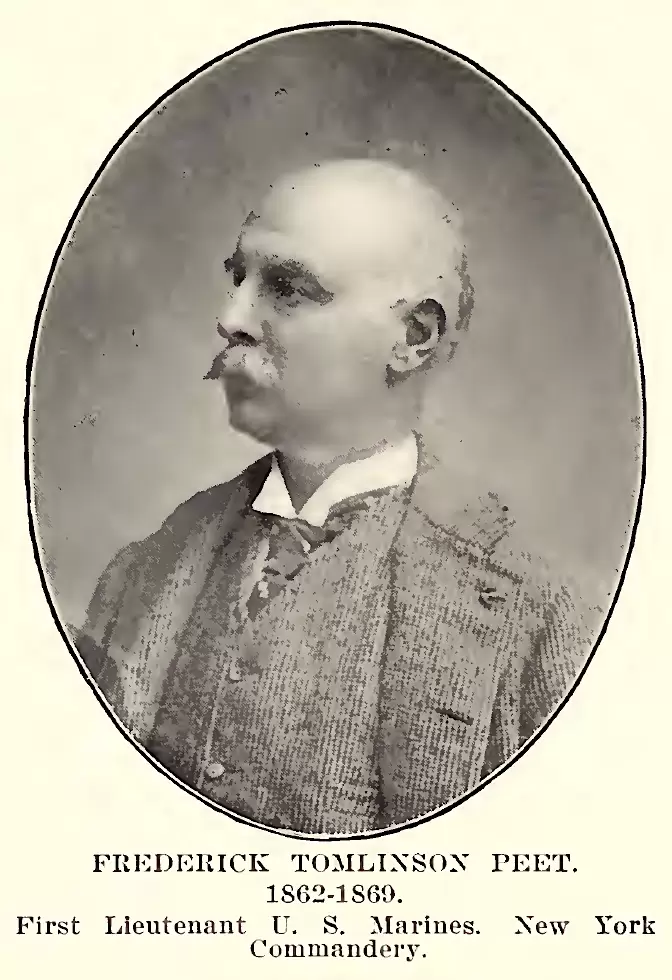
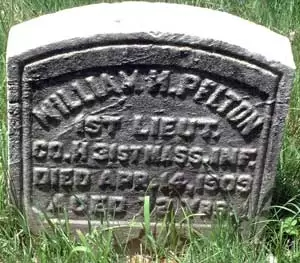
PELTON, WILLIAM H. (1837-1909). First lieutenant, 31st Massachusetts Infantry, Companies H and D. Pelton was born in Sheffield, Massachusetts. On January 27, 1860, he married his first wife, Cornelia E. Phillips, in Florida, Massachusetts. He was a clerk and the couple lived in New Haven, Connecticut. At the time of his enlistment as a sergeant on December 7, 1861, Pelton was a resident of Great Barrington, Massachusetts, was and worked as a salesman He mustered into the 31st Massachusetts the next month on January 27, 1862. He became a first sergeant as per General Order No. 7, dated May 8, 1862, at which time he became eligible for sergeant’s pay.
Pelton rose through the ranks, becoming a second lieutenant on January 1, 1863, and a first lieutenant on March 20, 1864; his Draft Registration, filed in Massachusetts in July 1863, notes that he was a clerk and at New Berne, North Carolina. Pelton’s promotion to first lieutenant was announced in the Pittsfield Sun on July 21, 1864. His muster roll notes that he was assigned to command of Company D as of April 20, 1864. Subsequently, he was detached to New Orleans, Louisiana, in July and August of 1864; his muster roll states that he was owed $6.00-10.00 for May and June of that year for being responsible for company property. He mustered out at New Orleans on August 14, 1864, to accept a commission as first lieutenant of Company H of his regiment. His muster roll for October 1864 indicates that he was still due pay for his responsibility of clothing and arms for his assignment commanding Company D. He mustered out on December 15, 1864, as per Special Order 330 (which pertained to the consolidation of his regiment).
At the time of the 1875 New York State census, Pelton lived in Troy, New York, with his first wife, two sons, Clarence and Raymond, and mother-in-law; he was then employed as a salesman. On August 29, 1891, he married Ellen Mangan, aged 28, in Brooklyn. In 1892, his application for an invalid pension was approved, certificate 979,097. The 1892 New York State census reports that he was married, lived in Brooklyn and was a cartmaker. According to the 1900 census, the Peltons had a seven-year-old son and lived in Brooklyn at 65 St. Felix Street; he worked as a shoe salesman. The 1902 Brooklyn Directory lists him as a clerk; he still lived at the St. Felix Street address.
As per his obituary in Brooklyn’s Home Talk the Item, which confirms his Civil War service, Pelton was a member of the Rankin Post #10 of the G.A.R. He died at Bay Ridge Hospital where he was a caretaker and where his funeral was held. His last address was in Brooklyn at 60th Street and Second Avenue. His death was attributed to pneumonia. Pelton was survived by his wife and son, who bore his name. In 1917, Ellen Pelton, who is interred with him, applied for and received a widow’s pension, certificate 826,741. Section 14, lot 16311, grave 25.
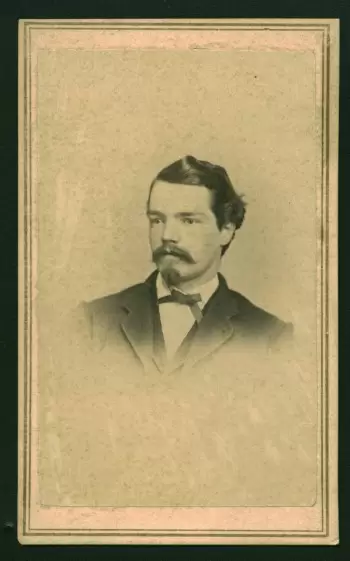
PENDLETON, WILLIAM DOUGLAS (1831-1893). First assistant engineer, United States Navy. Pendleton was born in Campbell, Virginia. His father, William Garland Pendleton, nicknamed “Old Penny,” was a lawyer and at the time of his death in 1839, was a proctor at the University of Virginia. Pendleton’s mother, Mary, also had roots in Virginia; both parents are buried in Virginia, his father in Lynchburg and his mother in Richmond.
In spite of his roots in the South, Pendleton supported the Union cause. During the Civil War, he served as an assistant engineer in the United States Navy. An article in The Philadelphia Inquirer on September 19, 1861, noted that the blockading steamer, Quaker City, on which Pendleton was an assistant engineer, had arrived at the Brooklyn Navy Yard on September 17 from Fortress Monroe. The Quaker City had been part of the blockade at the mouth of Chesapeake Bay, between Cape Henry and Cape Charles, for 79 days. The vessel, whose contract with the government had expired, was at the Navy Yard for a re-fit prior to rejoining the blockade. The Quaker City had onboard the crew of the Henry Middleton, a schooner captured by the Vandalia off the coast of Charleston, South Carolina, on August 21 while she was attempting to run the blockade. The article indicated that the captain of the Henry Middleton, when he realized that he could not escape the blockade, began throwing his papers and deck load overboard. Nonetheless, the ship was taken and the Roanoke transferred the prisoners to the Quaker City. Once in Brooklyn, the Confederates were imprisoned at Fort Lafayette in New York Harbor.
On November 4, 1861, Pendleton was assigned as a 1st assistant engineer to the USS Wachusett. On December 31, 1862, a letter was sent to Gideon Welles, Secretary of the Navy, from Acting Rear Admiral Charles Wilkes of the West India Squadron referencing a communication from Pendleton about the conditions of the boilers on the Wachusett. Pendleton noted that the boilers were inefficient, once leading to burst pipes, compromising the speed and safety of the ship; a survey of the boilers was requested with remarks that the ship could not perform the duties assigned. Pendleton was detached to the USS Lehigh on July 27, 1863, failed at examination on July 26, 1864, and was detached to the Eastern Gulf Blockading Squadron on August 4, 1864. On August 9, 1864, he married Clara Dunford Paige at the Protestant Episcopal Church at Trinity Parish, New York. On December 30, 1864, he was detached to special duty in New York, then detached to the Florida on December 29, 1865, and turned in his resignation on January 4, 1866. His letter of resignation to Gideon Welles, Secretary of the Navy, noted, “owing to recent family calamities, I cannot be absent from home, without leaving a widowed mother and sister, and my own family, entirely without protection and support…”
As per the 1870 census, Pendleton lived with his wife in Jersey City, New Jersey, and was employed as an engineer on a steamer; his real estate was valued at $1,000 and his personal property was worth $200. Records of the First Presbyterian Church in Bergen County, New Jersey, state that their daughter, Clara Alexander, was born on February 13, 1872, and baptized on December 25; an online family tree indicates that two children had died earlier—a son in 1867 and a daughter in 1869. The Jersey City Directory for 1874 identifies Pendleton as an engineer. The 1880 census, which incorrectly lists his birthplace as England, notes that he lived in Jersey City with his wife and two children and worked as a mechanical engineer. The 1890 Veterans Census confirms his Naval Service and his service on the Quaker City. The 1891 and 1892 Jersey City Directories note that Pendleton was an engineer living at 107 Kensington Avenue. He last lived at 107 Kensington Avenue in Jersey City. His death was attributed to “softening of the brain.” His obituary in the New York Herald noted that the announcement of his death should be printed in newspapers in Richmond, Virginia. Clara Pendleton, who is interred with him, applied for and received a widow’s pension of $8.00 per month from the Navy in 1893, certificate 10,001. Section 48, lot 6466, grave 2.
PENFIELD, HENRY FRANCIS (or FRANK) (1823-1865). Captain, 145th New York Infantry, Company E. Penfield, a native of Ballston, New York, first served in the Mexican War. A bookkeeper, he enlisted at Boston, Massachusetts, on September 18, 1847, and was discharged on June 27, 1848. As per his muster roll, he was 5′ 7″ tall with black eyes, dark hair and a fair complexion. As per the New York City Directories for 1856, 1859 and 1861, he was listed as a driver who lived on Houston Street. The 1860 census lists him as married with an infant daughter, living in New York City and working as a stage starter.
During the Civil War, Penfield enlisted as a captain at New York City on June 16, 1862, was commissioned into the 145th on September 11, and resigned on December 5 of that year. Penfield was listed as a driver in the 1864 New York City Directory; he then lived at 168 Ninth Avenue. He last resided at 34 Carmine Street in Manhattan where he died from consumption. His obituary in the New York Herald noted that his death should also be announced in Syracuse newspapers.
In 1890, Sarah Olive Penfield George, who had married her second husband, Enoch George (see), on February 17, 1876, applied for and received a widow’s pension, certificate 331,737; this is puzzling because she had already received a pension for her second husband’s service. The Penfield’s daughter, Frances O. Adams, received a minor’s pension in 1890, certificate 331,737; the daughter’s pension is also unusual because she was married and was born circa 1860. Penfield, Enoch George and Sarah Penfield George are all buried in the same lot. Section 3, lot 21025, grave 381.
PENGEL, WALTER (or WALDEMAR) E. (1841-1886). Private, 3rd New Jersey Cavalry, Company K. Originally from Helligands, Denmark, Pengel served as a private with the 3rd New Jersey Cavalry. The 3rd New Jersey Cavalry was organized at Camp Bayard in Trenton in December 1863 and was attached to the Army of the Potomac. It was stationed in Washington, D.C., from June 1865 until August 1 when it mustered out there.
Pengel became a naturalized citizen at Brooklyn City Court on July 26, 1865; at that time, he swore his allegiance to the United States Constitution, renounced his allegiance to the King of Denmark, and noted his service as a private in the 3rd New Jersey Cavalry. As per the 1870 census, he lived in Brooklyn with his wife and four young children and worked as a carriage-maker. An article in the Times Union on July 9, 1874, reported that Pengel dissolved his business partnership with John Schlitz and indicated that Pengel was to become the sole proprietor of the carriage business at 955 and 957 Broadway, near DeKalb Avenue in Brooklyn. Pengel noted in a separate message that his 18 years of experience was a guarantee that he would be successful in his business venture if given the opportunity. A subsequent article in the Times Union on September 8, 1874, indicated that Pengel had just completed another coach (referred to as a stage) that rivaled the largest and finest one that he had created, “The Metropolitan”; the new vehicle was described as “not quite so commodious, but which equals the other in exquisiteness of workmanship.” The 1876 and 1883 Brooklyn Directories list him as a carriage manufacturer. As per the 1880 census, he lived in Brooklyn with his wife and seven children and was still working as a carriage-maker.
Pengel’s last residence was in Fort Hamilton, Brooklyn. In 1887, Elva Pengel, who is interred with him, filed for and received a widow’s pension, certificate 287,647. Upon her death on April 26, 1911, his remains were moved from lot 21035 to the present location. Section 193, lot 31771.
PENTECOST (or PENTICOST), GEORGE FREDERICK (1843-1920). Chaplain, 8th Kentucky Cavalry. As per his passport application of June 25, 1874, George was born on September 15, 1841, in Albion, Illinois. That information is contradicted by his online family tree on the Ancestry website and Biographies of Notable Americans (1904) which report that George was born on September 23, 1842, and on Find A Grave and Appleton’s Cyclopedia of American Biography, 1600-1889, which note September 23, 1843, as his birth date. His parents were Hugh Lockett Pentecost and Emma née Flower and his siblings were Cora (born 1838), Emma (born 1844) and Hugh (born 1848), who was also a prominent preacher, lawyer and Socialist. His biographical sketch in Biographies of Notable Americans cites that his ancestors were English (mother), Huguenot (the Pentecosts) and Jewish (maternal grandmother-Eliza Julia Andrews Flower).
According to Biographies of Notable Americans and Appleton’s Cyclopedia, George was educated in the public schools, learned the trade of printing, and served as a clerk of the United States District Court for the Kansas Territory in 1858 as well as a private secretary to Governor Samuel Medary there from 1858 through 1859. His obituary in the Yonkers Statesman notes that he turned to religion during a revival in Henderson, Kentucky, and was baptized on a wintry day in the Ohio River, before the Civil War. His biographical sketches and the aforementioned obituary indicate that he enrolled at Georgetown College in Kentucky in 1861 but left to enlist in the Union cause in the 8th Kentucky Cavalry, rising to captain before becoming that regiment’s chaplain. As per the report of the Adjutant General of the State of Kentucky, George enlisted as a chaplain on September 13, 1862, at Louisville, Kentucky, and was immediately commissioned into the Field and Staff of the 8th Kentucky Cavalry. He served as chaplain in 1862 and 1863.
George married Rachel Ada (or Ada Rachel as per his online genealogy) Webber of Hopkinsville, Kentucky, on October 8, 1863. Find A Grave reports that the couple had three children: Lucy (born 1865), Webber Colby (born 1874 who died at age five), and Hugh (who died in infancy in 1879). His online family tree also lists Frederica (born 1872) and George Jr. (born 1876).
Pentecost was well-known as a pastor, missionary and evangelist. As detailed in Biographies of Notable Americans, George, was licensed to preach in the Baptist church in 1862 (or 1864 as per Appleton’s), and served as a pastor in Greencastle, Indiana, in 1864; Evansville, Indiana, from 1866 through 1867; Covington, Kentucky, from 1867 through 1868; Brooklyn, New York, from 1868 through 1871 and 1880 through 1887, where he was pastor of the Tompkins Avenue Congregational Church, and Boston, Massachusetts, from 1871 through 1880. He received an honorary master’s degree from Hamilton College in 1870 and a Doctor of Divinity degree from Lafayette College in 1884.
According to his 1874 passport application, Pentecost was 5′ 9″ tall with dark brown eyes and hair, an aquiline nose, a high and broad forehead, large mouth, wide chin, dark complexion, and round face. His career as a missionary and evangelists accounts for his numerous places of residence. Among his experiences abroad were evangelical work in Scotland from 1887 through 1888; a special missioner to Brahmins in India from 1889 through 1891; and minister to the Marylebone Presbyterian Church in London from 1891 through 1897. His appointment in London and travels to India were confirmed by an article in the Chicago Tribune on September 18, 1892. He later returned to the Philippines, China, and Japan, as a special representative of the Presbyterian Board of Foreign Missions and the American Board of Commissioners of Foreign Missions on September 13, 1902. His request to accept a mission to the Philippines had previously been reported in the San Francisco Chronicle on October 6, 1901.
As per his family tree, Pentecost was living in Northfield, Massachusetts in 1880; in Yonkers, New York, in 1900, where he was pastor of the First Presbyterian Church from 1897 through 1902 when he resigned to resume evangelical and missionary work; in Darien, Connecticut in 1910; and in Philadelphia in 1920, where he was pastor of the Bethany Presbyterian Church from 1914 until his death.
The information culled from census data reflect his peripatetic life. As per the 1870 census, he was a clergyman living in Brooklyn with his wife, Ada, and daughter, Lucy (6). Also in the household were his mother, Emma, siblings Emma (25) and Hugh (22); Resa Pentecost (18), possibly a sibling, is listed along with two others, Kate Butler (19) and Annie Lynch (11) whose relationship to George is unknown. By 1873, George and his wife were in Boston where on October 13 of that year, The Recorder announced that the couple of the Warren Avenue Baptist Church celebrated their tenth anniversary. Parishioners and friends were part of the festivities where a purse of $500 was one of the gifts. The 1880 census records that the Pentecosts (surname spelled Pentacost) were living in Northfield, Massachusetts, where George was an evangelist; their three children, Lucy (16), Frederricka (8). and George Jr. (5), were part of the household. As per his obituary in the Brooklyn Daily Eagle, Pentecost worked with the evangelist George Moody there; Moody founded the Northfield Conference. The Eagle noted that Pentecost had a beautiful property there where he bred cob horses, two of which he brought over from England.
As per the census of 1900, George and Rachel Pentcost were living in a rental at 11 Quincey Place in Yonkers, New York, had been married for circa 35 years (actually 37), and George was still a clergyman. Lucie Crowell, presumably their married daughter (34) and her child, Robbins (11), Frederika (spelled differently on various documents who was 26), George Jr (20), Emma Pentcose (25-relationship unknown) and two others comprised the household. The ages of the family members and spellings of names are close but don’t exactly match previous census records. An article in the New-York Tribune on August 9, 1920, after Pentecost’s death, highlighted in a sub-heading that the “Evangelist Created Sensation by Preaching Sermon on Rockefeller Contribution to the Church.” That same article, which noted Pentecost’s association with the famed evangelist, George Moody dating from 1868, reported that in 1900, George preached that Rockefeller’s contributions were “tainted” and that his huge contributions were “less welcome than the dimes of the poor.”
In 1906, Pentecost’s application for an invalid pension was approved, certificate 1,123,662. By the time of the 1910 census, the family, spelled Pentacost on this document, were living in Darien, Connecticut, and George was identified as a minister. They owned their own home, were listed as married 40 years, and George Jr. still lived at home along with three others of unknown relationship.
Beyond his pastoral work, Pentecost was a prolific writer. In addition to being the editor of “Words and Weapons for Christian Workers,” a monthly from 1885-1890, he wrote: In the Volume of the Book (1876); The Angel in the Marble (1876); A South Window (1876); Out of Egypt (1884); Bible Studies-10 Volumes (1880-1889); Birth and Boyhood of Christ (1896); Forgiveness of Sins (1897); Systematic Beneficence (1897); Precious Truths (1898); and numerous tracts and pamphlets, as per Biographies of Notable Americans, 1904, and his obituary in the Brooklyn Daily Eagle. Some of the publication dates of the above listed works are different in Appleton’s, perhaps because of new editions or different publishers. George also spoke on conditions in British East India in 1888, after returning from a mission to Calcutta; again, this date is close but doesn’t exactly match the years cited above when he was in India.
As per the 1920 census, the Pentecosts were living in a rental at 2129 Bainbridge Street in Philadelphia, Pennsylvania, and George was listed as a clergyman; their daughter, Fredericka Phillips and a Bessie Frazier (relationship unknown) lived with them. Pentecost died on August 7, 1920, on a train trip to preach in Brooklyn. The place of death is not correct on several documents; Find A Grave reports that he died in Manhattan while his pension index notes that he died in Darien, Connecticut, and his online family tree cites that he died in Philadelphia.
Pentecost gave several speeches in New York City in the days before his death. The Brooklyn Daily Eagle reported on July 31, 1920, that Pentecost would preach the next day at the Janes Methodist Episcopal Church on Reid Avenue and Monroe Street addressing the topics “The precious Blood of Christ-Why?” at 10:30 am and “The Precious Blood of Christ-How?” at 7:45 pm. A little more than a week later, Pentecoast died suddenly on August 8. As per an article in the New-York Tribune on August 9, 1920, George died while en route to New York from Darien, his summer home, on a New York & New Haven train. The article attributed his death to heart disease and reported that his body was taken to a funeral home at 14 East 39th Street in Manhattan; this accounts for the confusion about place of death. The Brooklyn Daily Eagle stated that he suffered a stroke as the train approached Grand Central Station and he died after being carried off the train. As per his obituary in the Yonkers Statesman on August 9, Pentecost died at the emergency hospital at Grand Central Station. The Statesman confirmed that George was filling in for the pastor at Brooklyn churches while their pastor was absent for the summer. Both the Statesman and the Eagle noted that Pentecost, one of the most prominent Presbyterian clergymen in the United States, planned to leave for Japan the next week to attend a Sunday School Convention in Tokyo.
The Brooklyn Daily Eagle reported on Pentecost’s death on August 9, citing that Pentecost had just spoken on August 1 and had inspired hundreds with his “ringing words,” Funeral services were held at the Tompkins Avenue Congregational Church where George was a pastor early in his career. The Eagle reported that Pentecost traveled to New York City against the advice of his doctor and was accompanied by a grandson who lived in Philadelphia. Apparently, George told his family that he didn’t feel well but “it was his duty to fulfill his engagement in Brooklyn.” The Eagle noted that a fellow man of the cloth said of George, “Anybody who knew Dr. Pentecost knew that it was only natural that he would die in harness. He was looked upon as a strong leader in Orthodox circles of religion.” As per the Yonkers Statesman on August 12, 1920, the Reverend Paul Moody, son of George Moody, Pentecost’s assistant in Philadelphia, and a third reverend conducted the funeral service. A delegation from the Military Order of the Loyal Legion from New York, a veterans’ group, attended the service. Green-Wood’s records note his last residence as 2819 Bainbridge Street in Philadelphia, and the cause of death as angina pectoris.
In addition to his widow, Pentecost was survived by his daughter, Fredericka Philips, and his son George Jr. of Darien. Although his wife, Ada, filed for a widow’s pension in June 1921, application 1,174,972, it was not certified. Section 153, lot 21816/21817.


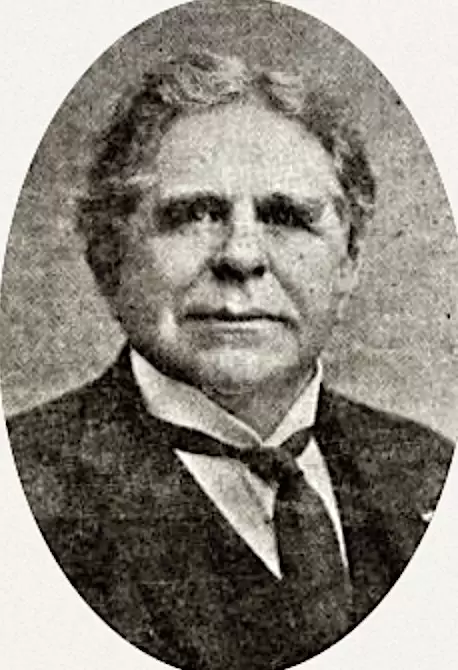

PENTZ, ARCHIBALD MACLAY (1839-1914). Private, 8th Regiment, New York State Militia, Company K. A native of New York City, Pentz’s family was well-known in the fire-fighting community. His father, Adam Perry Pentz, was president of the New York Volunteer Fire Department for five years and his grandfather was a member of the Floating Engine Company during the last years of the American Revolution. An article in The New York Times on August 10, 1859, listed Pentz as a corporal in the 8th Regiment. That article notes that the 8th Regiment, known familiarly as the Washington Greys, had visited Boston and took part in military exercises there with two Boston regiments who also wore new grey uniforms. During the Civil War, Archibald Maclay (his mother’s maiden name) Pentz served for three months in the 8th New York State Militia in 1861 and was wounded at the Battle of Bull Run, Virginia; the 8th New York had been at Annapolis, Maryland, and Washington, D.C., prior to their advance into Virginia.
On October 17, 1862, The New York Times announced Pentz’s marriage to Marie (Mary) Edwards, the daughter of Captain William Edwards, at St. Paul’s Methodist Episcopal Church in New York City. In civilian life, he was a founder of the Empire Cotton Express Company. On May 21, 1868, the New York Herald published an article stating that Pentz and others had a lawsuit in the United States District Admiralty Court against the steamer Ariadne which had collided with the brig William Edwards on December 14, 1865, off Barnegat, New Jersey; Pentz claimed compensation of $60,200 for the loss of the brig and cargo. The brig was en route from LeHavre, France, to New York City; the Ariadne was bound from New York to New Orleans. The New York Herald reported on June 24, 1868, that the brig was at fault and that the claim was to be dismissed with costs. As per an appeal decided in Admiralty Court on January 1, 1871, the court determined that the Ariadne’s lookout did not see the brig until it was brought to his attention just before the collision, evidence of gross carelessness. The brig was faulted for having no green light, or an insufficient one on her starboard side, and the court reversed the lower court decision, holding that both vessels were at fault and the damages must be divided.
At the time of the 1870 census, Pentz lived in Manhattan with his wife and three young children; he was listed as an insurance broker. The Daily Graphic, a New York newspaper, published an article on March 27, 1874, describing a boat excursion by 50 men who represented the freight departments of most of the Western railroads, looking at the site of a new grain elevator recently purchased by the New York Central and Hudson River Railroad. One of the stops on their trip was Pentz’s plant at the foot of 11th Street where Pentz compressed bales of cotton to one-fourth of its original size by a newly-patented machine. He was listed as “press” or cotton presser in the New York City Directories for 1875-1876, 1877, 1885-1886 and 1894-1895. According to the 1880 census, he lived in Manhattan with his wife, four children, and servant; his occupation was recorded as cotton presser.
Remaining active in military affairs, Pentz mustered into the John A Dix Post of the G.A.R. on August 12, 1880, and remained a member through March 18, 1884; he listed his occupation as “compressor of cotton.” Subsequently, he was a member of the Alexander Hamilton Post #182 of the G.A.R. and also belonged to the Sons of the American Revolution. He was also associated with the New York Savings Bank as a trustee in 1882, vice president in 1893 and secretary as of 1902. The census of 1900 lists him as a banker living in Manhattan with his wife, two children and two servants; at the time of the 1905 New York State census, he was still a banker living in Manhattan with his wife, one child and two servants. In 1907, his application for a pension was approved, certificate 1,139,183. An article in the Daily People on December 18, 1912, reported that a robber who had entered Pentz’s apartment and was surprised by a female cook who fought him; the robber escaped with considerable loot after attempting to stab the cook and then locking her in a closet. Pentz’s obituary in The New York Times, which confirms his Civil War service, notes that he was a member of the St. Nicholas Society; members of that organization were invited to attend his funeral.
The New York Tribune published a tribute to Pentz from the trustees of the New York Savings Bank saluting him as a “man of the highest character, essentially a man of domestic habits, strongly attached to his family, and with a deep and loyal devotion to his business…It is with deep sorrow that we place on record this tribute to the memory of a noble and upright man, and a desire to express in some small degree our profound sympathy for his bereaved family.” Another tribute in the New York Tribune from the General Society of Mechanics and Tradesmen of the City of New York expressed condolences and reported that Pentz had been a member of that organization for twenty-nine years. His death certificate notes that he was a widower and secretary of a New York bank; his wife Mary died in 1909 at their summer home in Seabright, New Jersey. His last residence was 124 West 57th Street in Manhattan. Section 56, lot 4564.
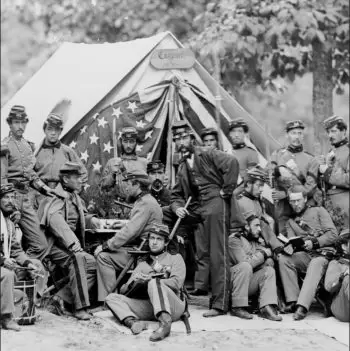
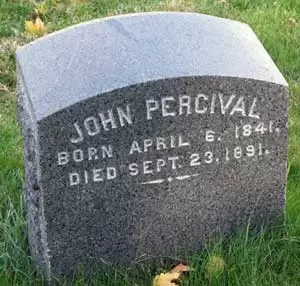
PERCIVAL, JOHN (1841-1891). Sergeant, United States Marine Corps. Of Irish origin, Percival served as a sergeant in the United States Marine Corps. As per the census of 1870, he was married with seven-month-old twin sons, Arthur and Charles, and worked as a clerk. The 1880 census states that he was a dry goods clerk, was married with one nine-year-old son, Charles. The 1885 and 1888-1890 Brooklyn Directories list him as a clerk living at 324 Classon Avenue. A member of the George C. Strong Post #534 of the G.A.R. in Brooklyn, he joined on May 26, 1887. In 1890, Percival’s application for a Navy pension was approved, certificate 8,123.
The G.A.R. Mortuary Table for 1893 confirms that Percival served in the Marine Corps during the Civil War. At the time of his death, he was a salesman at H. B. Claflin’s (see) Dry Goods Store. His last residence was 324 Classon Avenue in Brooklyn. He died at the Chambers Street Hospital in Manhattan from a uremic coma (nephritis). Although his obituary in the New York Herald indicates that he was survived by his wife and son, there was a daughter Mabel, born in 1882, who is listed on the 1892 New York State census, the 1900 census (Middletown, New Jersey), and the 1905 census as living with her mother. In 1891, Anna (Annah) Van Brakle Percival applied for and received a widow’s pension, certificate 6,864. In 1895, a minor’s pension for Mabel Percival was approved, certificate 11,191; 1895 was about the time that Anna remarried, her second husband died in 1905. Anna Percival Morris reapplied to the Navy for a widow’s pension in 1916 as a remarried widow; that application indicates that Percival was a sergeant. Section 135, lot 27263, grave 1524.
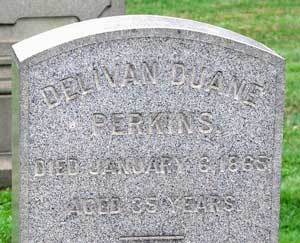
PERKINS, DELAVAN DUANE (1830-1865). Lieutenant colonel and assistant inspector general, United States Army Inspector General’s Department; major, United States Volunteers Aide-De-Camp; United States Army Adjutant General’s Department; captain, 4th Light Artillery, United States Army. Born in New York State, Perkins served in the Army beginning on July 1, 1849, upon his graduation from the United States Military Academy where he ranked 8th out of 43 cadets in his class. First assigned to the garrison at Fort Monroe, Virginia, he returned to West Point from 1850-1854 where he was an assistant professor of mathematics. Returning to the 4th Artillery, he was at Fort Hamilton, New York, for one year, then fought against Indians in the Seminole Wars in Florida. After serving in Fort Leavenworth, Kansas, from 1857-1858, he participated in the Utah Expedition until 1860, and was in Maryland in 1861.
At the start of the Civil War, Perkins enlisted as a captain on May 17, 1861, and was commissioned that day into the 4th Light Artillery, United States Army. On November 18, 1861, he was promoted and commissioned as major and additional aide-de-camp in the United States Volunteers Aide-De-Camp, serving there until he was commissioned as lieutenant colonel and assistant inspector general in the Army’s Inspector General Department on August 20, 1862. Perkins was in charge of the prisoners of war who were confined to Fort Delaware from November 21, 1862 through March 16, 1863. R. Hugh Simmons wrote about Perkins’s command in Fort Delaware Notes (February 2012) noting that as per the Dix-Hill Cartel, a prisoner exchange agreement signed in July 1862, future prisoners were to be paroled for exchange and returned to their own sides within ten days of capture or as “soon as practicable,” usually within two or three weeks. Therefore, during Perkins’s tenure, there were few Confederate prisoners at Fort Delaware. Simmons goes on to say that under the terms of the agreement, 555 paroled Union prisoners of war were sent to Fort Delaware in September 1862, while awaiting exchange. The survivors were sent to Annapolis, Maryland, on December 24, and by January 1, 1863, only five were still at Fort Delaware.
During Perkins’s term, British officials visited to check on allegations that British citizens were forcibly enrolled in the Union Army and held in “dark cells,” a charge that Perkins disputed noting that all cells had a port hole admitting light. In addition, on February 18, 1863, the USS Ericsson brought over 63 bounty jumpers for confinement. He also supervised Union soldiers sentenced to “hard time” after being court-martialed and the 27 Confederate prisoners who were sent there in the first quarter of 1863. As per the Federal Enrollment Act of March 3, 1863, Perkins was assigned as Acting Assistant Provost Marshal General for the State Of Connecticut at Hartford as of April 25, 1863. He was responsible for implementing the federal draft and reported to the War Department. On June 1, 1864, he was promoted to major and assistant adjutant general and was immediately commissioned into the United States Army’s Adjutant General Department.
On December 21, 1864, Perkins married Lizzie Harward in Washington, D.C. Sadly, shortly after his marriage, he died of consumption on January 6, 1865, in Washington, D.C. On May 10, 1865, Lizzie Perkins applied for and received a widow’s pension, certificate 61,606; her pension claim, filed from Bath, Maine, notes that his illness was contracted while in the line of duty and that she had not “aided or abetted the rebellion in the United States.” In 1874, she petitioned that her pension be restored; she had resided in Paris, France, and had last received a pension payment in March 1870. Section 113, lot 16479.
PERKINS, ROBERT E. (1842-1912). Private, 23rd Regiment, New York State National Guard, Company F. According to his obituary in The New York Times, Perkins was a Civil War veteran whose ancestry could be traced back to the families on the Mayflower. Perkins enlisted as a private and served for 30 days in 1863 with the 23rd Regiment, New York State National Guard. His obituary in the Brooklyn Daily Eagle notes that he was a member of Lafayette Post #140 and the Veteran Association of the 23rd Regiment, New York National Guard; members of both organizations were invited to attend his funeral. In civilian life, he was employed by the Bank of America for 40 years. His last address was 175 Eighth Avenue in Brooklyn. Section 128, lot 337451, grave 2.
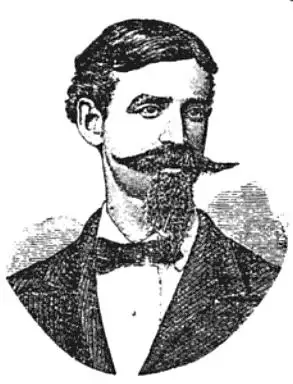
PERLEY, HENRY C. (1842-1920). Captain, 9th New York Infantry, Companies F and H. Perley was born in New York City and was one of eleven siblings including two sets of twins; Henry had a twin brother, John Keys Perley. Having no known record of his birth, he checked family bibles for genealogical records unsuccessfully, and decided to use December 13, 1842, as his date of birth for official purposes. The family lived in New York City at the time of the 1860 census. During the Civil War, he enlisted as a first lieutenant at New York City on April 23, 1861, and was commissioned into Company F of the 9th New York, known familiarly as Hawkins Zouaves, on May 4 of that year. He was 6′ tall with dark hair and eyes and had an olive complexion. War Department records note that in November 1861 he was suffering from intermittent fever, a condition that had lingered for a month and left him feeling exhausted and on furlough for health reasons. His muster roll reports that he was on detached service in Plymouth, North Carolina, in June, July, August and November 0f 1862. On March 1, 1863, he was promoted to captain, effective upon his transfer to Company H that day, and two months later mustered out at New York on May 20. His twin, who is buried in Woodlawn Cemetery, also served in the 9th New York and rose to major.
The 1868 New York City Directory lists Perley as working in iron and living at 957 Second Avenue in Manhattan. The 1870 census notes that he lived with his parents and siblings in Manhattan; his parents’ real estate was valued at $25,000 and their personal estate was worth $4,000. The 1876 New York City Directory lists him as a clerk with a home address at 238 East 60th Street. As per the 1880 census, he was a boarder living on West 50th Street in Manhattan and working as a molder (one who casts iron).
As per his obituary in The New York Times, which confirms his Civil War service and his promotion to captain at the Battle of Fredericksburg, Virginia, Perley continued to serve in the New York State National Guard for seven years, attaining the rank of lieutenant colonel. That obituary notes that he was active in Republican Party politics, having been elected councilman in 1868 and alderman from 1878 through 1881. On April 21, 1881, The New York Times reported that Alderman Perley, the commander of the Reno Post #44 of the G.A.R., would lead his comrades on chartered boats on Decoration Day (now Memorial Day) to honor the soldiers buried at City Cemetery on Hart’s Island. On August 1, 1885, The New York Times stated that Perley was presented with a gold watch by members of the Reno Post in recognition of his years of service as its commander.
Perley was also known as President Chester A. Arthur’s right-hand man (Arthur served from September 19, 1881 through March 4, 1885, after the death of James Garfield (who died two months after he was shot.) Perley ran unsuccessfully for Congress in 1884. When Perley’s name was put in nomination for county clerk, The New York Times reported on October 12, 1888, that General H. A. Barnum said of him:
I ask that you supplement your work by nominating for the office of County Clerk a man who has been in the front ranks of the aggressive Republicans of this city. When a youth of 17, prompted by a loyal and patriotic feeling, he left his home and bore his life to the battlefield and offered it to his country. He became a Captain, Lieutenant-Colonel, and Colonel in the volunteer service of the United States. For 16 years he has been Commander of a post of the Grand Army of the Republic and often a delegate to the State and National Encampments, and is known to almost every soldier and sailor in this city. I nominate Col. Henry C. Perley.
Following his defeat in the election for county clerk in 1888, he became a police court clerk at the Tombs for thirteen years, rising to chief clerk.
As per the 1888 New York City Directory, Perley was a clerk who lived at 217 East 48th Street in Manhattan. The Evening World reported on February 1, 1888, that he was floor manager of the Reno Post’s gala and ball at the Lexington Avenue Opera House. An article in The New York Times on December 18, 1888, noted that Perley, after his defeat for county clerk, was blackballed for membership in the Republican Club at 450 Fifth Avenue. That article, which noted that others were also denied membership, indicated that some members thought Perley was a “boy” whose ideas were as reprehensible as those of John J. O’Brien, whose friends were ejected from the Republican County Committee through the efforts of Police Justice Solon B. Smith, the man who appointed Perley to the position of police clerk. The Evening World reported on May 21, 1890, that Perley, Smith’s lieutenant in the Twentieth Assembly District and twice a candidate for county clerk, was on the inside track for an appointment as police commissioner; it does not appear that he was appointed to that position.
The 1890 Veterans Schedule confirms Perley’s Civil War service. On September 3, 1893, the Evening World reported that Perley, the police clerk at the Tombs and well-known Republican, had undergone a dangerous surgical operation and was slowly recovering. The New York Times reported on December 26, 1896, that Perley was in Bellevue Hospital suffering from locomotor ataxia (movement disorder). That article stated that Perley, who was once erect, 6′ 2″ tall with bright eyes, and only having a few tinges of gray hair was now bent over with dim eyes and hair and mustache that were nearly white. He attributed his condition to the strain of work, little sleep, and irregular meals. His patron, Sol Smith, had died from the stress, the Board of Police Justices had been replaced by the Board of Magistrates, and after suffering a stroke, Perley was too weak to work. He had entered Bellevue for water treatments alternating hot and cold water at intense pressure and denied that he was a charity case.
In 1897, Perley applied for a federal pension, certificate 1,103,785. When his twin brother died in 1901, Henry Perley was listed in the obituary as at Bellevue Hospital; both brothers were active politically: John was allied with Tammany Hall and was also a National Guardsman and commander of the Kimball Post of the G.A.R. The 1910 census noted that he was a boarder in Manhattan and worked as a city clerk. The 1915 New York State census and the 1920 census report that he was a resident at the Home for Incurables in New York City. His death was attributed to nephritis. As per his death certificate, he was single and worked as a clerk. His funeral took place at the Stephen Merritt Burial and Cremation Company’s Funeral Chapel at 2343 8th Avenue near 125th Street in Manhattan. Section 35, lot 5489.
PERLEY (or MONROE), STEPHEN (1841-1887). Private, 9th Massachusetts Infantry, Company I; 32nd Massachusetts Infantry, Company H. A native of Boston, Massachusetts, Perley was also known as Stephen Monroe. The 1855 Massachusetts State census identifies him as a 14-year-old resident of Cambridge. In Perley’s Civil War Draft Registration record of 1863, he is listed as single and a 21-year-old teamster. A resident of Charlestown, Massachusetts, and a laborer by trade, Perley was drafted into Company I of the 9th Massachusetts Infantry on July 13, 1863. On May 5, 1864, he was injured at Wilderness, Virginia. Perley was listed on the roll of the Barrack Branch Ward at the Lincoln U.S.A. General Hospital at Washington, D.C., for September and October 1864. Although listed as absent and wounded, he was transferred into Company H of the 32nd Massachusetts Infantry on June 9, 1865. He mustered out on June 19, 1865. He last lived at 965 Myrtle Avenue in Brooklyn. His death was attributed to lympho-malaria fever. He left personal property valued at $1,400 to his widow, Anna, and three young children ages 12, 10, and 2. Section 127, lot 17931, grave 36.
PERRIN, THOMAS L. (1843-1927). Commissary sergeant, 18th Pennsylvania Cavalry, Company F. Perrin was a resident of Bridgeport, Pennsylvania, in 1860. Though a local history indicates a birth year of 1845, his tombstone is inscribed with 1843. He was 6′ tall with blue eyes and light hair. After enlisting as a private on November 23, 1862, Perrin joined the 18th Pennsylvania Cavalry, a regiment formed from the 163rd Volunteers. He achieved the rank of commissary sergeant prior to suffering gunshot wounds to the thighs and pelvis at White Oak Swamp, Virginia, on June 14, 1864. After being hospitalized at several facilities, he was discharged from White Hall U.S. General Hospital on April 6, 1865. His application for an invalid pension dated April 15, 1865, was approved, certificate 55,268.
Perrin returned to Brownsville, Pennsylvania, after the Civil War and, according to the 1870 census, he worked as a dentist. He may have learned dentistry during his extended hospital stays after his injury at White Oak Swamp. Perrin moved to Baltimore, Maryland, and then by 1874 was in Brooklyn where he practiced dentistry for the rest of his life. A wealthy man, he last lived at 352 Clinton Street and at some point had two servants in his household. He succumbed to heart disease. Ella Perrin, who is interred with him, applied for and was granted a widow’s pension shortly after his death in 1927, certificate a-10-25-27. Section 197, lot 32262.
